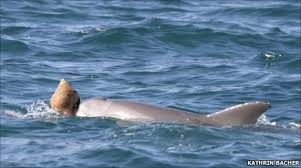 The Mexican Indians symbolized the same; in part; with two other key words ‘Conch’ shell and ‘Thread / Knot’ symbolism. A pink conch shell became symbolic of that ‘origin’. While the sound it can make is a link to the potential of becoming aware of something, as well as its origins, i.e., 'water' link. Especially salt water. Recall what 'it' represents. 'Pearls' also associated with same. One a 'beginning' the other an end. An 'end' result. Alpha and Omega, represented in a different 'form'. [Introduction, 'The Tutankhamun Prophecies'. Mentioned elsewhere].
The Mexican Indians symbolized the same; in part; with two other key words ‘Conch’ shell and ‘Thread / Knot’ symbolism. A pink conch shell became symbolic of that ‘origin’. While the sound it can make is a link to the potential of becoming aware of something, as well as its origins, i.e., 'water' link. Especially salt water. Recall what 'it' represents. 'Pearls' also associated with same. One a 'beginning' the other an end. An 'end' result. Alpha and Omega, represented in a different 'form'. [Introduction, 'The Tutankhamun Prophecies'. Mentioned elsewhere].
N.B. Persevere with it - regardless of how basic? or simple? or 'child' - ish? it first appears.
{Working?} example..."As we slowly made the long drive to Coba, we had - after so many surprises - given up our expectations. Childlike, we brought with us now only open hearts and open eyes. We were simply waiting for 'god' {synchronistic link} to show us our next 'responsibility'." ['Serpent of Light Beyond 2012'. Emphasis, this readers]. 'Story' {method?} enlarged elsewhere. Follow the book title to see if you agree or not.
''In the beginning was the word; and the 'word' was..."
"...Too meditate is to deepen; it is to go to the heart of things." [Extract from the book by Tomberg. 'Letter 21' ]. One could apply same principle - to the study of something / anything.
''The pink-footed goose is well-known for its loud, honking call that it often performs while flying in a flock, or 'skein'; look out for the characteristic V-formation that so many migrating birds use.''
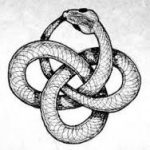
knotted?
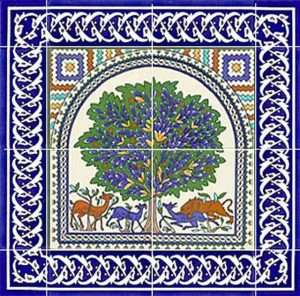
Strangling or grasping?
"The task of the scholar of esoteric studies is not to prove that such an invisible 'tradition', hidden behind the veil of historic events, did or did not exist; as such; before the Renaissance; rather, the task consists of trying to grasp and to describe the different facets of the emergence of this idea as it appears in the imaginary and the discourses of the last centuries [and/or millenniums. This readers input]. Quote by A. Faivre.
As one example: ''Grey - Valour of the Mighty Grasp, a name well suited to the gatekeeper as 'Old Wise Man'. Glewlwyd Gafaelfawr is a well known figure in Welsh Arthurian tradition, and appears in other tales.'' [Page 240 'Fruits of the Moon Tree' / J. Layard].
'Mighty conch's' blown on ''the holy plain, on the field of Kuru'', who were ''gathered together eager for battle''. [ 'First Discourse' of the book 'The Bhagavad Gita' {The Lord's Song, i.e., higher over lower or at least; with that potential 'in sight'}.
A ''gathering together'' as in the artefacts found in Tut's tomb. The 'golden child'.

'Shadow' in relation to S/W?
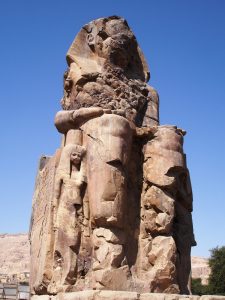 "The voice of truth in a person that has not yet awakened to spiritual life, is the ''still small voice'' { a ''golden'' one?} that may be felt in the heart, listened to by the imperfect; as a half conscious dreamer may listen to the ringing of bells in the distance; but in those that have become conscious of life, that have passed through the first 'resurrection' of the spirit in their own heart, and received the baptism of the first initiation, administered by themselves, the voice of the new born 'ego' has no uncertain sound, but becomes the powerful Word of the 'Master'. [Emphasis this readers. Chapter 1, from the book by F. Hartman]. Link to the word ''teacher'', of 'Dead Sea Scroll' fame. Enlarged elsewhere.
"The voice of truth in a person that has not yet awakened to spiritual life, is the ''still small voice'' { a ''golden'' one?} that may be felt in the heart, listened to by the imperfect; as a half conscious dreamer may listen to the ringing of bells in the distance; but in those that have become conscious of life, that have passed through the first 'resurrection' of the spirit in their own heart, and received the baptism of the first initiation, administered by themselves, the voice of the new born 'ego' has no uncertain sound, but becomes the powerful Word of the 'Master'. [Emphasis this readers. Chapter 1, from the book by F. Hartman]. Link to the word ''teacher'', of 'Dead Sea Scroll' fame. Enlarged elsewhere.
 'Pearl of Great Price'?
'Pearl of Great Price'?
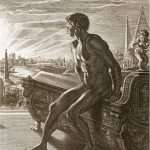
Male or female aspect? Nefertiti?
Find it to understand it - rather than leave to those first impressions.
"The word 'spiritual' should be associated with the word 'eyes'. This is a reference to the eyes of the mind or heart. To see is to understand." [From the book by T. Nottingham].
'Waters of the Gap' ?
A working example: {i.e., Hypothesis about Tut's tomb in relation to}:
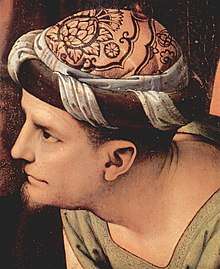
Distaff creation?
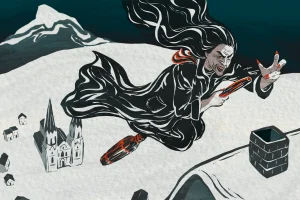
Distaff.
"The Gospel of Nicodemus, a text appended to the Acts of Pilate, provides additional details about Joseph. For instance, after Joseph asked Pilate for the body of the Christ and prepared the body with Nicodemus' help, Christ's body was delivered to a new tomb that Joseph had built for himself. In the Gospel of Nicodemus, the Jewish elders express anger at Joseph for burying the body of Christ, saying: And likewise Joseph also stepped out and said to them: ''Why are you angry against me because I begged the body of Jesus? Behold, I have put him in my new tomb, wrapping in clean linen; and I have rolled a stone to the door of the tomb. And you have acted not well against the just man, because you have not repented of crucifying him, but also have pierced him with a spear."— Gospel of Nicodemus. Translated by Alexander Walker.
Head Jars.
N.B. ''Pontius Pilate became Roman governor of Judea in 26AD.''
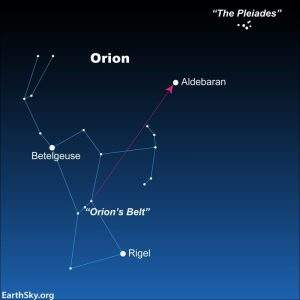
To truly appreciate the concha belt, we must journey back in time. The term “concha” itself is Spanish for shell, which reflects the intricate patterns often found on the silver conchas. These belts have their roots with the Navajo, a tribe known for their rich artistic traditions.
Surprisingly, the history of concha belts dates back well before the arrival of Europeans in North America. Around 500 BC, some Native American tribes were already skilled in working with metals like copper.
And/or: "The Wandering Jew is a mythical immortal man whose legend began to spread in Europe in the 13th century.[a] In the original legend, a Jew who taunted Jesus on the way to the Crucifixion was then cursed to walk the Earth until the Second Coming. The exact nature of the wanderer's indiscretion varies in different versions of the tale, as do aspects of his character; sometimes he is said to be a shoemaker or other tradesman, while sometimes he is the doorman at the estate of Pontius Pilate."
"The 'Spear Side' is a reference to the male side of a family. Distaff the female side.'' ['The Chase' / ITV / 25.2.22].
Refresher: ''It was said that a spear standing upright at the tomb of Christ would cast no shadow at midday, because it marked the center point of everything under the sun...."

“Most certainly, I tell you, one who doesn’t enter by the door into the sheep fold, but climbs up some other way, is a thief and a robber."
Side note: Before dealing with the mineral allocation, let us see if we can find anything in the physiological story which has been brought down through the ages. In C. A. Gaskell's Classic Myths, we note that the Three Fates (Clotho, Lachesis and Atrophos) were the spinners of the thread of human destiny. They were provided with shears with which to cut it off when they pleased, and, according to Hesiod, were the daughters of Night. Clotho held the distaff, Lachesis spun the thread, and Atrophos cut it off when it was ended.....


Shepherd Kings?
Gemini is the branching-off month or period of the year, as has been heretofore explained. It has to do, in utero, with the branching-off of the nerves from the head, to form the body. Thus it does not require much imagination to see that the story of the Three Fates is concerned with the three decans of Gemini. The distaff refers to the base of the brain, where seventy-five per cent of the nerves of the head concentrate and cross, appearing to wind upon themselves. In some mythological pictures the thread is represented as first appearing at the feet of Jove and his heavenly spouse. Clotho, the youngest of the three fates is allocated with the first decan of the sign Gemini, and is holder of the distaff. Lachesis spins or draws out the thread, while Atrophos divides it so that it may form the great nerve branch in either leg. {'The Zodiac and the Salts of Salvation' / Carey and Perry}.
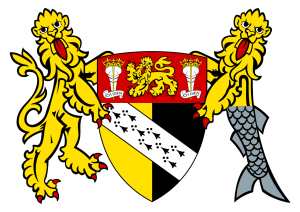
Norfolk: Spear points? S/E -N/W?

Gemini.
''The name for the Ash in Old English, aesc, as well as its Latin name, fraxinus, both mean ''spear,'' and ash was the favourite choice of the Celts for making spear shafts - a primary weapon in the Iron Age due to the branches strength and straightness {anima?}. These spears were often carefully engraved, and many were named, considered treasures handed down through generations. Spears traditionally were considered female objects, hence Oengus's description of ash as ''the boast of women,'' {animus?} alluding to the prowess of spears in battle....Or Cuchulain reference ''the weavers beam'' as is it referred to in the battle of Moytura. And/or: Morainn's reference to it as ''the establishing {or checking} of peace testifies to its status as a primary weapon. Ash is usually sacred to the god Lugh for its masculune solar energy as well as its associations with justice. The ash had special significance in Ireland {Vikings}. Their were five sacred special living trees in Ireland that, like Yggdrasil, were probably understood as World Trees.'' [Page 82 'Celtic Tree Magic: Ogham Lore and Druid Mysteries' / D. Forest].
James the Just?
Righteousness / UPright?
90 degrees?
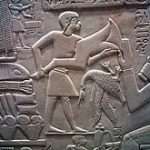
Profile or face on?

Doing his bit for the community? Batman, Red Baron or Biggles? Has he be seen near any foodbanks! Flyover?
''We are not given an ego because we are supposed to starve it to death. We are given an ego to learn to bring it into balance, to master it. In many cases, ego represents identity: It gives it a separateness, a form that is essential to function in this plane. We have difficulty understanding the concept that we are all one. If we were the true embodiment of that concept, there wouldn't be any lessons to be experienced. The ego gives us the identity to experience the lesson in terms of a very specific viewpoint - ours. Its as if we look at the situation through a very specific window. The frame of the window is our ego. It gives us the form to look through {from a very acute perspective} that aspect of that problem. It's very much like there is a horizon, and then there is the vista of the entire universe. The ego becomes a periscope from which we see very specific aspects of that universe. Take, for instance, a high jumper. The high jumper needs to go over the top bar. The bar is there so the high jumper can jump over it. It becomes the obstacle, and jumping over it { 'void'? } becomes the reward. We are given an ego. The reward comes when we are able to let it go and see the bigger picture..." [From the book by E. Pearl. Mentioned elsewhere].
Question. Horus in/of the horizon?
'Breaking the Mother Goose Code' by J. Studebaker.

Recall the animals at the base of those 'T' shaped pillars at Gobekli-tepe.

Gibson Thunderbird. The 'rarest' on the planet. "A legendary tone. Came out in 1963. Its a neck-through-body. All in one piece. They clue the wings on afterwards. Giving it lots of resonance and thumping low end tone. Of the natural wood finish type, only three left in existence....Kind of cool to see one - like a unicorn - very rare." [Wolf Navarro Guitars]. 'WINGS' to enlarge.
"...but Plutarch mentions that in the driving off of Typhon use was made of the sistrum of Isis. The sistrum was a musical instrument made rather like a rattle. There was a hollow ball which contained four ''things,'' which rattled when it was shaken. These ''things'' are said to represent the four elements ...Plutarch writes: ''The sistrum also shows that existent things must be 'shaken up' and never have cessation from impulse, but as it were be wakened up and agitated when they fall asleep and die away. For they say they turn aside and beat off Typhon with sisra..." [Chapter 13, 'Woman's Mysteries: Ancient and Modern'. Mentioned elsewhere]. Put ''Typhon'' in the box. Then try ''sleep.'' [Part one].
Question. ''Four faces'' ? Enlarged elsewhere.

Pantheon to enlarge.
Side note: ''''Bushy Oak, leafy Oak. You TOWER above all trees....O Hazel, little branching one. Coffer for sweet nuts...O apple tree, true to your kind. You are much SHAKEN by men...'' [Page 444 'The White Goddess' / R. Graves].
'Lightening'?
And/or: ''The sistrum also indicates that the things which exist should be shaken and should never stop moving....For they say that with the sistrum they repel and ward off Typhon, meaning that when decay confines and restricts nature, the power of creation sets her free, and restores her by means of movement.''[Page 57 'Hathor Rising'].
Static/Dynamic?
Analogy?: ''The terms 'stopping' and 'seeing' basically cannot be seperated. They mean concentration and insight.'' [Page 21 'The Secret of the Golden Flower' / T. Cleary].
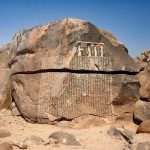
Cancer or Capricorn?
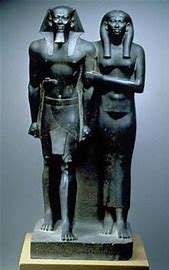
Lunar mansion or just Solar?
Side note: ''Eratosthenes knew it as the Goat-Footed Pan, half fishified, Smyth said, by his plunge into the Nile in a panic at the approach of the monster Typhon; the same story told of Bacchus, so that he, too, was associated with its stars...Platonists held that the souls {Ba?} of men, when released from corporeity, ascended to heaven through its stars {'lunar' ones?}, whence it was called the Gate of the Gods; their road of descent having been through Cancer. But some Orientals knew it as the Southern Gate of the Sun....It has always been regarded in astrology as the Mansion of the Kings {Per-wer?}...An early Babylonian gem, had it surmounted, not inappropriately, by the crescent moon, for Capricorn was a nocturnal sign...as seen on a fragment of a Babylonian planisphere {12 century BC}....Jewish Rabbis asserted that the tribe of Nephtali adopted this sign as their banner emblem: 'Nephtali is a hind let loose' - as if Capricorn was a deer or antelope {ibex}...It was shown at Denderah in its 'double form' as an ibis headed man riding on Capricorn, under which sign Sirius rose anti-heliacally...It was much favoured by the Arabians - Lunar mansions assigned, as the names/characters for its chief stars....It was regarded as under the care of the goddess Vesta....'' [135-139 'Star Names Their Lore and Meaning' / R. Allen].
'Uas' Sceptre?

Ibex carving on Sperm Whale tooth.
A {working?} example..."After the ceremony Vina - who had loaned her rattle to Davlin for the peyote songs and knew nothing of what had happened in my meditation shortly before the ceremony - said that Devlin had appeared to her after the ceremony and asked her to give her rattle to me." ['Serpent of Light Beyond 2012']. The 'whole' story has to be understood to define the importance of the ''rattle''. Enlarged elsewhere.
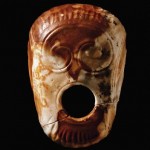
Try 'flint'.
"And my eyes saw the secrets of lightening and thunder, the secrets of clouds and of the dew...I saw the chambers out of which come the 'Sun' and the 'Moon' and where they go." ['Third Book of Enoch]. Recall what the 'sun / moon' are symbolic of. What they represent.
"In the Pagan Mysteries, beginners were known as 'mystae', meaning 'those with eyes closed', and enlightened initiates were known as 'epopteia' meaning, 'those who can see'." [From the book by T. Freke and P. Gandy].
'Mans Search for Meaning' / Viktor Frankl.
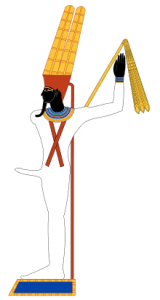
Egyptian Min {or the Roman Pan}: ''Whose arm is raised in the East.'' Lightening strike? i.e., From the tip of the fingers to the tip of the phallus - in a two 'step' form. Below the 'navel' = active i.e., manifested. Above the navel = UNmanifested - represented with the colour black. But with a latent positive potential within it - represented with the colour red. 'See' it? Horus IN/OF the Horizon to enlarge.
Example of {i.e., to get ones head around it}: " The interpretation of the moon mysteries {as one example} suggested in the following chapters links our modern life problems to those of the ancient peoples who recognized that in their day, as in ours, the world at times became sterile, and was laid waste, not by war or pestilence, but because some essential fertilizing spirit had been withdrawn."
"It is he who doth show you The Lightening, by way, of both fear and hope. It is he who doth raise up the clouds, heavy with fertilizing rain." [Quran 13:12].
Question. Coincidence or a meaningful one?
What does 'water' represent?
"They ask thee concerning The Spirit of inspiration. Say: 'The spirit cometh by command of my 'Lord': Of knowledge it is only a little communicated to you." [Quran 17:85].

West? 'Naked' / 'lion' to enlarge.
Link to ''two bows length". Question. What does the bow [therefore; that which it comes with; that which it is associated with] - represent?
Think about in relation to 'higher/lower'. Finally put ''teacher'' in the usual box. Islams equivalent [if only for this reader]. Question. Once again - Coincidence or a meaningful one?
A working example: ''Year 2, second month of the inundation, day 15. Horus: Lord of the Two Lands, Two Ladies: Lord of the Two Lands, Gods of Gold: King of Upper and Lower Egypt, Nebtawyra, Son of Ra, Mentuhotep, who lives forever. My majesty sent the prince, mayor of the city, vizier, chief of royal works, royal favourite, Amenemhat, with a troop 10000 men from the southern nomes of Upper Egypt, and from the {garrisons} of Thebes, in order to bring me a precious block of the pure stone of this mountain, whose excellence was made by Min, for the land of life, who recalls eternity even more than the monuments in the temples of Upper Egypt, as a mission of the king who rules the Two Lands, so as to bring him his hearts desire from the desert lands of his father Min. He made it as his monument to his father Min of Coptos, lord of desert lands, ruler of Bowmen {'nine'?} that he may give many {Jubilees} and to live like Ra forever.'' {Stela: From Deir el-Medina, depicting the Syrian goddess Qadesh, who became the consort of Min in Eighteen{th} Dynasty}.
'Fifty' to enlarge.

'Father' of terror. Nightmare? Question. What is the Sphinx quarried from?
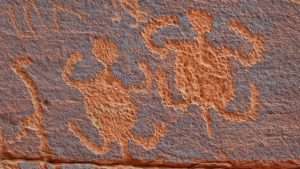
''Possible turtle people emerging from a horizontal crack.''
And/or: ''Sand comes in every colour. The Black sand in Hawaii and Santorini has volcanic minerals mixed into it. Bermuda's pink beaches get their colour from the red and pink shells of tiny marine creatures....On the Rainbow Beach of Australia, sand appears in more than seventy colours. It can come from a variety of sources, including the poop of the parrotfish, which eat algae and dead coral and excrete hundreds of tonnes of sand each year. Most sand comes from granulated rocks that streams carry to the sea....Sandpaper, paint, silicon chips made from it as well as concrete, brick and glass. Depending on what's in it, sand must be heated to 1700 centigrade to become glass. The oldest {and fastest} glassmaker is lightening. When a bolt strikes dry sand, it instantly melts and fuses the sand into hollow branching glass tubes called fulgurites. Not all sand is suitable for building....Meanwhile larger animals such as turtles lay their eggs in sand....German writer Eta Hoffmann's 1816 short story 'Der Sandmann' popularised the myth about the creature who sprinkles sand in our eyes while we sleep....induces sweet dreams - hence the lyrics to the 1954 song by The Chordettes: 'Mr Sandman, bring me a dream....'' [Page 94 'Readers Digest' / August 2023].
'Ancient sea beds' to enlarge.
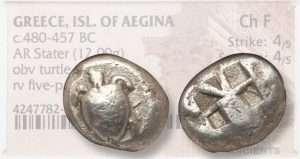
Turtle or tortoise?
''The Dream Stele, also called the Sphinx Stele, is an epigraphic stele erected between the front paws of the Great Sphinx of Giza by the ancient Egyptian pharaoh Thutmose IV in the first year of the king's reign, 1401 BC, during the 18th Dynasty.''
Bells to enlarge.
And/or: ''Knowledge is a responsibility which compels, and i will not render myself in any wise unworthy of that Princely Crown of the Rosy Cross. He did not therefore name OPENLY the certain substance which he understood as First Matter, that vessel like unto 'a little simple shell,' or the Glass of his mystery. When he compares the radiant body of adeptship to the shining face of Moses descending from Horeb, he feels he has 'touched the veil' and must draw back.'' [Introduction: 'The Works of Thomas Vaughan' / Eugenius Philalethes].
"For his wedding with Juno (Hera), Jupiter (Zeus) ordered Mercurius (Hermes) to invite all the gods, the men and the animals to the wedding. Everyone invited by Mercurius (Hermes) came, except for Chelone {mountain nymph}....

"In Greek mythology, Chelônê (Ancient Greek: Χελώνη from khelônê which means tortoise) was an oread of Mount Khelydorea ("rich in tortoises") in Arkadia."
who did not deign to be there, mocking the wedding. When Mercurius noticed her absence, he went back down to the earth, threw in the river the house of Chelone that was standing over the river and changed Chelone into an animal that would bear her name. Chelone is said testudo (tortoise) in Latin."
Side note: "Archaeologists in Iraq have unearthed twin temples built on top of each other. The newer, Hellenistic temple dates to the fourth century B.C. and may have a link to Alexander the Great. The temple contained a fired brick with an Aramaic and Greek inscription that references "the giver of two brothers" — a possible reference to the Macedonian king, who conquered much of the known world during his 13-year-reign from 336 B.C. to 323 B.C.
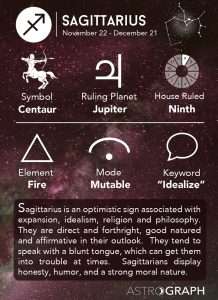 While exploring the dual temple site, archaeologists discovered a silver drachm (an ancient Greek coin) buried beneath an altar or shrine, as well as a brick with the two brothers inscription.
While exploring the dual temple site, archaeologists discovered a silver drachm (an ancient Greek coin) buried beneath an altar or shrine, as well as a brick with the two brothers inscription.
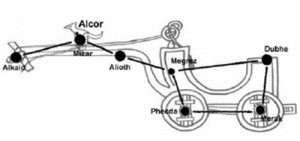
'Handle' on the moment?
"The inscription is very interesting because it mentions an enigmatic Babylonian name written in Greek and Aramaic," Rey said. "The name 'Adadnadinakhe,' which means 'Adad, the giver of brothers,' was clearly chosen as a ceremonial title on account of its archaizing tone and symbolic connotations. All the evidence points to the fact that the name was extraordinarily rare." ['Live Science' / Dec. 2023].
Refresher: ''The Sphinx is to fire as the Sibyl is to soul."
Side note: In the east Soma is said to have been stolen by humans as fire in the west was stolen by the 'trickster' character.
According to Geldner (1951), the word is derived from Indo-Iranian roots *sav- (Sanskrit sav-/su) "to press", i.e. *sau-ma- is the drink prepared by pressing the stalks of a plant, but the word and the related practices were borrowed by the Indo-Aryans from the Bactria–Margiana culture (BMAC).

Men in Iranian dress in one of the Noin-Ula embroidered carpets. They have also been proposed to be Yuezhi. 1st century BC - 1st century AD. A solitary mushroom can be seen within the tapestry.{'Mysteries of the Ancient Dead' / S1 EP5}. 'Queendom' to enlarge.
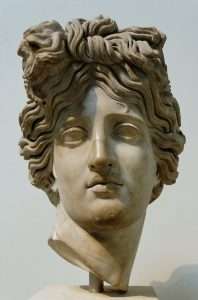
Apollo: Curl or knot?
A working example: "The Noin-Ula burial site (Mongolian: Ноён уулын булш, Noyon uulyn bulsh, also Noyon Uul) consist of more than 200 large burial mounds, approximately square in plan, some 2 m in height, covering timber burial chambers. They are located by the Selenga River in the hills of northern Mongolia north of Ulaan Baatar in Batsumber sum of Tov Province. They were excavated in 1924–1925 by Pyotr Kozlov, who found them to be the tombs of the aristocracy of the Xiongnu;[1] one is an exceptionally rich burial of a historically known ruler of the Xiongnu, Wuzhuliu, who died in 13 CE. Most of the objects from Noin-Ula are now in the Hermitage Museum in Russia, while some artifacts unearthed later by Mongolian archaeologists are on display in the National Museum of Mongolian History, Ulaan Baatar. Two kurgans contained lacquer cups inscribed with Chinese characters believed to be the names of Chinese craftsmen, and dated September 5 year of Tsian-ping era, i.e. 2nd year BCE."
Continued: "Hadad (Ugaritic: 𐎅𐎄 Haddu), Haddad, Adad (Akkadian: 𒀭𒅎 DIM, pronounced as Adād), or Iškur (Sumerian) was the storm and rain god in the Canaanite and ancient Mesopotamian religions. He was attested in Ebla as "Hadda" in c. 2500 BCE.[1][2] From the Levant, Hadad was introduced to Mesopotamia by the Amorites, where he became known as the Akkadian (Assyrian-Babylonian) god Adad."
Drachma: a former monetary unit of Greece, notionally equal to 100 lepta, replaced in 2002 by the euro.
"In ancient Greece the drachma was an ancient currency unit issued by many city-states during a period of ten centuries, from the Archaic period throughout the Classical period, the Hellenistic period up to the Roman period. The ancient drachma originated in the Greece around the 6th century BC.[1] The coin, usually made of silver or sometimes gold[2] had its origins in a bartering system that referred to a drachma as a handful of wooden spits or arrows.[3] The drachma was unique to each city state that minted them, and were sometimes circulated all over the Mediterranean.[4] The coinage of Athens was considered to be the strongest and became the most popular."

Rule of thumb?
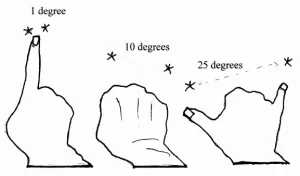
Fist?
"The name drachma is derived from the verb δράσσομαι (drássomai, "(I) grasp").[n 2] It is believed that the same word with the meaning of "handful" or "handle" is found in Linear B tablets of the Mycenean Pylos.[7][n 3] Initially a drachma was a fistful (a "grasp") of six oboloí or obeloí (metal sticks, literally "spits") originally used for roasting lamb.[3] Some say "a handful of arrows". With anthropological evidence it is believed that the oboloi were used as a form of early currency, beginning around 1100 BC and being a form of "bullion": bronze, copper, or iron ingots denominated by weight in a developed barter system.[3] The earliest of these obeloi were found in Palaepahos, Cyprus in a Geometric grave. Anthropological evidence suggests that obeloi were used in burials of warrior elite or in the grave's of people with high social status."
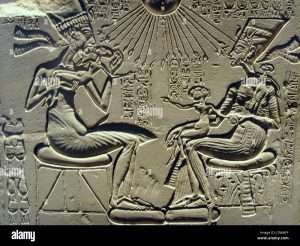
What are EACH sat on?
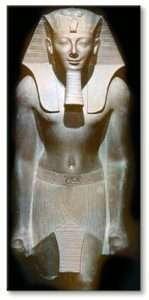
Happy or sad?
A work in progress: Since God has revealed all this to us through His early prophets, saints and sages, one can study these stories with an eye to the truth, trying to understand them and plumb their depths, and one will discover wondrous, awesome concepts. Admittedly, it may be impossible to grasp the true meaning of the stories, or their construction and sequence from the beginning to the end. Nevertheless, even if a person gains only a very small amount of understanding, it will be very sweet to his soul. As mentioned earlier, the King is God's Intellect, represented by the three highest sefiroth, Kether, Chokhmah, and Binah. The feminine concept, through which we can receive and grasp God's Intellect, is Malkhuth, and hence it is referred to as “The King's Daughter.”
Therefore, every Israelite is actively engaged in searching for the King’s Daughter so as to return her to her Father {Kether?}, just as she was in her girlhood. This is the mystery of the verse, “She shall return to her father’s house as in her girlhood, and then she can eat of her father’s bread” (Leviticus 22:13).
Kabbalistically, this represents the forces of creation going through the sefiroth of Chokhmah and Binah (Avodath HaKodesh). In Kabbalistic terms, this represents the light of the King entering the Vessels, which are represented by Malkhuth. As we have seen, Malkhuth, the Daughter, is the ability to grasp and hold....

Bald innkeeper?

Dresden {Saxony} Germany. Rooster on top. Rooster also on top of Notra Dame roof. 'Forest of oaks'.
And/or: The kerchief here is worn around the head. It therefore denotes the surrounding forces (makifin) around the mentalities of the Shekhinah (Zimrath HaAretz). The concept of makifin (surrounding lights) denotes ideas that the intellect cannot grasp (Likutey Moharan 21:4; Likutey Moharan Tinyana 6:7; also see Likutey Moharan 35:9). By giving him her kerchief, she is giving him an idea that his mind cannot grasp. Logically, she cannot be found. In order to find her, the viceroy will have to be able to transcend logic. This may refer to the prophecies of redemption that were given during the seventy years of Babylonian exile. This is the first mention of her kerchief. Some say that it denotes the Torah that he lost and now cannot understand (Rimzey Maasioth, Hashmatoth; see below).
On the holy side, hair also represents the ability of the unclean forces to grasp what is on one's mind (Likutey Moharan 67:9; Zohar 1:217a; Derekh Emeth 6). For this reason one must wash one's hands after cutting one's hair......Conversely, hair on the unclean side indicates that the Holy can grasp the thoughts. But since the Holy cannot in any way grasp the thoughts of philosophy and the klipath nogah, it is bald. {'The Lost Princess' / Rebbe Rashman}.
Birth of Venus?
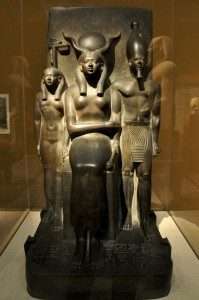
Any handles?
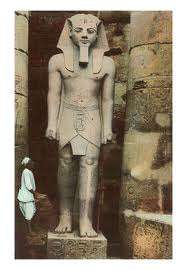
Best foot forward.
Side note: "6th and 7th century in S/E Britain is a fascinating period, we see a distinctive culture emerging and wonder how much of that influence is from abroad or home grown. And where we see that culture best is in graves, because the burial rites at that time was to inter people fully clothed with their jewellery and other objects {'Digging For Britain' / S9 EP1}.......
On the S/E coast of Britain {Kent} - on its TIP - Saxons, Angles and Jutes arrive after the departure of the Romans. In Deal more than eighty graves found.....
The monument was surrounded by a ring ditch 32m in diameter, 3.5m-wide, and 1.7m deep, and its first phase included the interment of crouched burials, some accompanied by distinctive Beaker vessels, inside this enclosed area. One of these was the skeleton of a 12-year-old boy who had been placed in a crouched position at the very centre of the site, together with two beakers. Dr Andrew Richardson, director of Isle Heritage CIC and an expert on Anglo-Saxon cemeteries in Kent, said the ‘Beaker-era monument’ sits within ‘a wider prehistoric funerary landscape’ on the ridge at Mill Hill, but the site also contains burials from the late 6th to late 7th centuries which ‘span the period of the Christian conversion.’
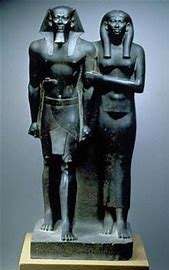
Wednesday's child.
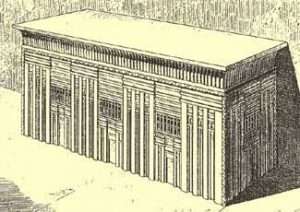
'Three and four'.
According to traditions established by the chronicler Bede (c.673-735), while much of England was settled by Angles and Saxons, Kent was settled by the Jutes. Archaeological evidence presents a more nuanced picture, however, reflecting a fusion of southern Scandinavian and Merovingian Frankish influences, as well as Romano-British traditions.
Most of the later burials were found outside the ring ditch, but inside the prehistoric enclosure the archaeologists found the c.AD 550 grave of a warrior who is thought to have died in battle because ‘the front of his skull was smashed in’ and his shield had been used to cover his face, said Tim. His grave goods included a ring sword featuring a garnet in its hilt, and a bronze bucket with two horse motifs. He had been laid to rest alongside a horse and a wolf size dog, found in a large pit next to the main grave. This is ‘arguably the highest-status male-gendered Anglo-Saxon burial to come out of Kent in the 21st century’, said Andrew.
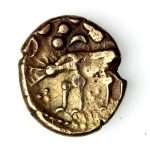
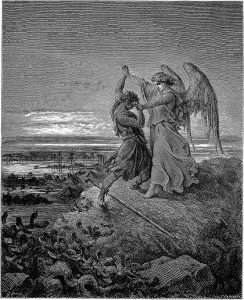 Another unusual find from the site was a set of scales, complete with ‘intricately decorated weights’, Tim said. Andrew explained that a comparable set had been found in Dover at Buckland cemetery in 1994. ‘I’m hoping that by comparing this new find with that set and others that have been found we can get more of an insight into the standard weights and measures that were being used in this period,’ Andrew said."
Another unusual find from the site was a set of scales, complete with ‘intricately decorated weights’, Tim said. Andrew explained that a comparable set had been found in Dover at Buckland cemetery in 1994. ‘I’m hoping that by comparing this new find with that set and others that have been found we can get more of an insight into the standard weights and measures that were being used in this period,’ Andrew said."
'Sixes and sevens'?
And/or: "When they came to the place called Golgotha, which means the place of the skull, they crucified him there. And when crucified they divided his garments among them by casting lots....So Jesus is stripped of his garments. Clothing gives man social position. It gives him a place in society. It makes him someone. His public stripping means he is no longer anything at all. A public outcast, despised by all alike. The moment of the stripping reminds us of the expulsion from paradise. Gods splendour has fallen away from mankind, who now stands naked and exposed. He takes on the condition of fallen man. Stripped of his garments he reminds us that we have all lost the FIRST garment that has gods splendour. At the foot of the cross the soldiers drew lots. Writers use Psalm twentytwo: '
'Swaddling' cloth?
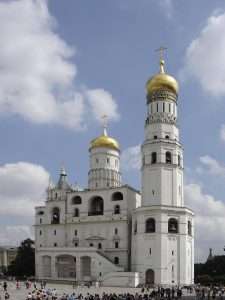
Onions?
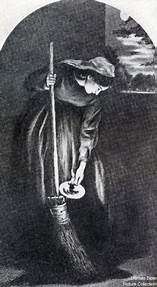
In this parable, a woman sweeps her dark house looking for a lost coin (engraving by John Everett Millais).
And/or: The Parable of the Lost Coin is one of the parables of Jesus. It appears in Luke 15:8–10. In it, a woman searches for a lost coin, finds it, and rejoices. It is a member of a trilogy on redemption that Jesus tells after the Pharisees and religious leaders accuse Him of welcoming and eating with "sinners."[1] The other two are the Parable of the Lost Sheep, and the Parable of the Lost Son or Prodigal Son. As recounted in Luke 15, a woman with ten silver coins (Greek drachmae) loses one. She then lights an oil lamp and sweeps her house until she finds it, rejoicing when she does:
Or what woman, if she had ten drachma coins, if she lost one drachma coin, wouldn't light a lamp, sweep the house, and seek diligently until she found it? When she has found it, she calls together her friends and neighbors, saying, 'Rejoice with me, for I have found the drachma which I had lost.' Even so, I tell you, there is joy in the presence of the angels of God over one sinner repenting."

A record breaking 64Ib fresh water salmon. {'The River: A Year in the Life of the Tay'}.
Sheep decans?
'Little' Bo-Peep?
"According to Marvel Comics, Thor's official weight is 640 Ibs - because his bones and muscles are much more dense than a humans, causing him to weigh more than he appears." ['Pawn Stars' / S18 EP9].
'Eight' link?
'Bones'.
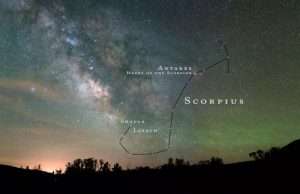
The tail end of the ''stinger'' = two swimming ducks.
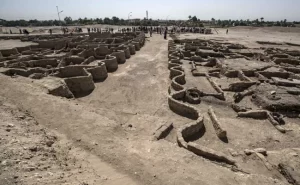
One large fish found within the recently discovered city belonging to Amenhotep III, a solar king. Named the Dazzling Aten. Salmon?
And/or: "The ancient May Day custom persisted in the remote, mountainous regions of Perthshire until the First World War. The bonfire was lit, an oatmeal pancake was baked {more than likely from 'the last sheaf of the previous harvest'}, and no matter how much care was taken in the baking of it, a blackened portion resembling the mark of a huge thumb appeared. The cake was broken into pieces and placed in a bag, and the onlookers had to draw out a piece, one portion to each person while the pieces lasted.
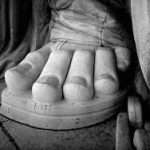
111' Tall {without the pedestal}. 'Lady of the Harbour'. "Chains" to enlarge.

Still/Rested? "Revolving" to enlarge.
Whoever drew the charred piece was made to leap through the fire {"three times"}, and was then driven from the enclosure with much shouting and demonstration. 'He was a kind of scapegoat', but in the old days, he or she would have been sacrificed....
In Derbyshire, not far from where Lindow Man was found, a similar enactment of a special cake baked every Beltain, and in spite of every care taken, a mysterious blackened area of a thumb print appeared when the baking was complete." [Page 37-8 'The Life and Death of a Druid Prince' / A. Ross + D. Robins].
'Mountain Low. Valley High'.

movement?

Direction?
Side note: On page 24 can be seen a tattooed Celt. All limbs have symbols with the exception of the left leg and foot. 'Naked' in appearance. On his right leg are a "line of mountain sheep" and one very large fish in the vertical position facing upwards. Left arm: "Horned mountain ram" and the right arm: "Carnivore with gaping jaws." What is NOT mentioned is the scorpion tattoo near the heart on the chest.
Up or down stream?
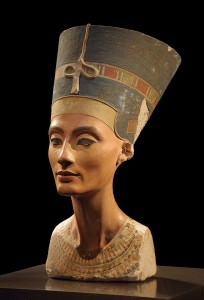
Flat top = 'right' eye = physical world? What would 'left' eye be represented with? All as a means....?
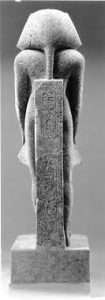
Forwards or backwards?
As seen from a different perspective: "But aspiration is not enough on its own. Aspiration alone can be but wish fulfilment fantasy unless we have the will and ability to bring it to realization and fulfilment. This is implied by the transverse path across our way; its symbol - the Lightening - struck Tower. Aspiration alone might be regarded as our being enclosed in an ivory tower, and many are there {within this subject} who remain in this condition. High on great thoughts but low on practical achievement. If we are to progress to be responsible servers of the 'higher' powers in the Temple of Tiphareth - 'the sphere of the god made Manifest, in the sphere of the mind' - then we have to be prepared for the lightening flash of illumination, or the lightening flash of destruction of false values. This may come to us as a shock, but it also a form of enlightenment..." Enlarged elsewhere.
''Thinking/feeling/willing'' -All a means...?
A working example: At Abydos, we both recieved shocks on our last trip. Denise stepped on an electrical wire and was shocked. It took a long time to heal. My shock came when the guide {Mohamed} showed me a scene of Isis and Osiris on the wall. Isis was depicted as a kite {bird} hovering above the body of Osiris. Mohamad said, "We have our virgin birth too." At that moment, i felt a sharp pain in my heart, and i had a sudden realization that i had been there. Where? I had no idea. I pondered this for a while - but still not a clue. [Page 136 'Invoking the Scribes of Ancient Egypt'].

Natures 'tower' ?
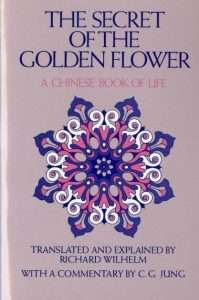 And/or: {something hinted at}: " After the stress and shock of the sudden awakening to the fundamental error of separateness - after the lightening flash of true knowledge has toppled the crown off the Tower of Common Sense - as shown in the 16th Major Trump, there comes a period of calm and gradual growth. In the second stage which we considered in the previous lesson, there is a sudden and painful overthrow of the 'false' wisdom of the world, a momentary, but never-to-be-forgotten glimpse of reality, of the absolute unity of life. In the 'third' stage this new conception of the Oneness of all, begins gradually to unfold {'pennant'?}. What happens to this unfoldment, and the specific activities involved therein, we may discover from the study of the 17th key of the Tarot....This picture develops the esoteric meaning of the Hebrew letter Tzaddi, named the ''fish hook''....That which pulls the 'fish' {Nun, i.e.,14th letter} OUT of Water {Mem, i.e., 13th letter}….''To hook'' is to draw, to entice, to procure....Has a particular application to the Christian aspects to the Ageless Wisdom, i.e., Jesus chose fishermen for disciples, and promised them that they should become 'fishers of men'...." [Pages 96/159 of the book by P. F. Case. Vol 1]. Try ''153''.
And/or: {something hinted at}: " After the stress and shock of the sudden awakening to the fundamental error of separateness - after the lightening flash of true knowledge has toppled the crown off the Tower of Common Sense - as shown in the 16th Major Trump, there comes a period of calm and gradual growth. In the second stage which we considered in the previous lesson, there is a sudden and painful overthrow of the 'false' wisdom of the world, a momentary, but never-to-be-forgotten glimpse of reality, of the absolute unity of life. In the 'third' stage this new conception of the Oneness of all, begins gradually to unfold {'pennant'?}. What happens to this unfoldment, and the specific activities involved therein, we may discover from the study of the 17th key of the Tarot....This picture develops the esoteric meaning of the Hebrew letter Tzaddi, named the ''fish hook''....That which pulls the 'fish' {Nun, i.e.,14th letter} OUT of Water {Mem, i.e., 13th letter}….''To hook'' is to draw, to entice, to procure....Has a particular application to the Christian aspects to the Ageless Wisdom, i.e., Jesus chose fishermen for disciples, and promised them that they should become 'fishers of men'...." [Pages 96/159 of the book by P. F. Case. Vol 1]. Try ''153''.
Blasted Tower?
"....since women played the leading role in the Dionysus cult. It was expressly added that the priestesses of Dionysus were the successors of the daughters of Semachos {i.e., foreign 'hero' - who is speculated to be the originator of the said 'cult' - from a 'mining' region 'S/E' Attica}. Another version mentions only one daughter, who received a 'deer skin' {nebris} from a god as a present. This was more than the gift of a special type of garment. It indicates the bestowal of a rite in consequence of which the deer skin could be worn: nebri-zein also means the rending of an animal. The cult action in which the sacrificial animal was dismembered, however, required at least two persons..."
REFRESHER: 'Sacrifice something of the lower to understand something of the higher'.
''Rending'' = 'something ripped apart, as in lightening splitting a tree' or ''tower''?
Oak? as a means....?
Try ''second/ry'' / ''sea people'' for something further.
'Fisher of Men' and/or archetypes/hieroglyphs?
As a starter try ''deer''.
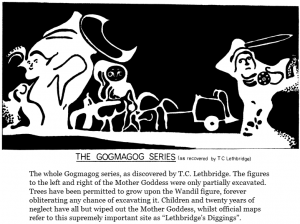
'Hooked' ?

Triples?
Side note: {from a different perspective}: "The Goddess is a lovely slender woman, with a hooked nose, deathly pale face {snow white?}, lips red as rowan berries, startling blue eyes and long fair hair; she can suddenly transform herself into sow, mare, bitch, vixen, she-ass, weasel {'ferret'?}, serpent, owl, she-wolf, tigress, mermaid and loathsome hag {i.e., twelve aspects? i.e., in the negative {shadow/unconscious? sense of the word?}. Her 'names' and titles are innumerable. In ghost stories she often figures as the White Lady, and in ancient religions, from the British islands to the Caucasus, as the White Goddess {therefore S/E - N/W 'Europa'? Recall same direction with 'Bog' bodies} - or muse, the Mother of all living, the ancient 'power' of 'fright' and 'lust' - the female spider or the queen bee whose 'embrace' is 'death' {towards a 'rebirth'?}. HENCE ''Housman offered a secondary test of true poetry: 'everything that reminds me of her goes through me like a spear' {''wounded'' link}. [Page 24 'The White Goddess' / R. Graves. All emphasis, this readers].
Try ''spear'' to attempt a mindset.
Tartessos to enlarge.

The throne of Minos.
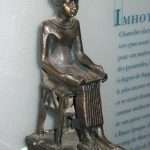
Imhotep:
''Hitting the mark'' ?
Oxyrhynchus fish?
''Europa is a moon of Jupiter that is named after the mother of the mythical king Minos of Crete.'' ['The Chase']
'Arachne Rising: The Search for the Thirteenth Sign of the Zodiac' / J. Vogh
N.B. 'Thirteen' individuals in the picture of the Last Supper.
Ophiuchus?

Something asleep - being awakened. Representational of.

When do we get a "Time lord" for adults and not just five year olds?
Continued: ''Blasted Tower" in relation too: ''Therefore we appeal to many a learned man in our writings, with letters and by our own hands; although our names are not known. That is known to to many a philosopher; many a chemist; many a doctor; many a reverend; many a worthy man - knows the sound of our trumpet." Taken from the chapter headed: 'The Sound of the Trumpet: The Original Intention of the So-Called Rosicrucian Manifestos'. [Extract from the book 'The Magister'. Mentioned elsewhere].
Refresher {a working example?}:"...Because a modern man lives in 'sleep' {unknown/unaware link}, what knowledge therefore can a sleeping man have? And if you think about it and at the same time remember that sleep is the chief feature of our being, it will at once become clear to you that if a man really wants knowledge, he must first of all think about how to wake, that is, about how to change his being..." ['In Search of the Miraculous'. Parenthesis, emphasis, this readers].
Follow the title of the book to 'see' it in its broader context.
"We will now examine a number of perspectives on the 'Rosicrucian manifestos' - regarding the original intention behind their writings and publication...the manifestos represent a test - in its truest forms of both challenge and measurement - of the time in which they were composed. This 'test' - a word whose etymology means a vessel in which metals were assayed, similar to Latin root, 'testa': ''pot'' {'Jars'?} or ''shell'' - is indeed such a shell in which a critical examination was carried out on the consciousness of the age. Not only are the manifestos loaded with metaphors - of light and dark, of loins and eagles, of night and dawn, of chalices, fountains, vipers and asses - they are in themselves a meta-metaphor in which there is 'the right, simple, easy and ingenious exposition, understanding, declaration, and knowledge of all secrets'. " [Same book]. ''Cauldron''?
'Mettle of the mind'
"The Quran has an outer meaning and an inner meaning." [Quote by Muhammad]........"the outer knowledge which is the shell, protects the inner knowledge which is the seed." [Page 22, 39, of the book, 'Secret of Secrets'].
''Oak''?
'Mans Search for Meaning' / Viktor Frankl.
Analogy: "Moreover, the work towards an inner rebirth through the 'circulation of the light', and the creation of the divine seed kernel, is described only in its first stages, although the later stages are named as the goal." ['The Secret of the Golden Flower: A Chinese Book of Life' / R. Wilhelm. Chapter entitled 'Origins of the Book'].
Coincidence?
From a different perspective [i.e.,''angle'']..."It is also fascinating to note that in Egyptian mythology, the Bennu birds cry is believed to have started the great cycles of time. These cycles were said to be appointed by a 'Divine' intelligence....and Horus the 'Bennu bird', became the Egyptian deity associated with the division of time. There is a strong possibility that the main unit of time represented by the Bennu's cry is the Precession of the Eqinoxes...." [Chapter three. 'The Source Field Investigations'. Mentioned elsewhere]. One of the paragraphs relate more so to ''bottom/up'' the other to ''top/down'' as a means to a 'method' of understanding.
That ''divine'' word again.
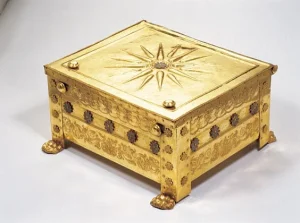
A work in progress: "The tomb of Phillip II {who ruled for "24" years} was found in the modern Greek village of Vergina, the site of Aigai. Objects from the tomb included an ivory head {bedpost}, a gold wreath with myrtle leaves and flowers; a gold quiver cover; a gold larnax, or ossuary, decorated with a sunburst {'SIXTEEN' pointed} or star likely containing Phillips remains; and a gold ornament of the gorgon Medusa." ['Archaeology' / May-June 2024].
''Breath'' in relation to that universal 'bit'. ''Cosmoses'' in relation to 'framework'. - ongoing; day by day. Fact or fiction. A possibility or not?
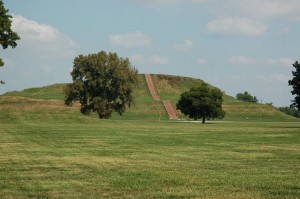
Monk's Mound. North America. Its largest. Very similar to others found on the surface {Key,i.e.,''horizontal'' link} - of the planet. Built by hands. A representation of something other than the obvious,i.e.,boredom and/or anything to do with the EX0-teric.
Together with..."This religion [Minoan] was dominated by a great 'goddess', who, despite her many names, can be identified as essentially one deity, being a 'complex' of all that is feminine, or the feminine principle itself. She was seen as the 'mother' of all creation, and hence her nature is all embracing, even to the point of containing all opposites. Since in mythopoeic thinking, the 'part may stand for the whole', she is the omphalos, the navel of the universe, whose mound like shape is the worlds womb, and whose spiral umbilical means not only the turn towards death, but the counter turn towards rebirth. She represents the constant principle in the flux of being, which is ever changing, yet ever the same, of the circle of eternal return." [Chapter two. 'The Riddle of the Sphinx'. C. Herberger]. Try ''Great turning at hand''.
Spirit or soul as a means....?
From a different perspective: {the 'ritual' one. As a means...?} ''I will be as a Bluestar upon a field of green, circling upward towards a golden sun."
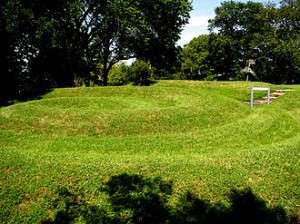
''Why lies the mighty dragon here, let him who knoweth tell. With its head to the land, and its huge tail near the shore of the fair loch Nell?" [page 259. Douglas Monroe]. ''gnashing of teeth''?
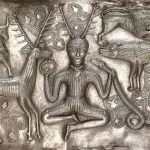
Seated on what?
The symbol given above, as well as usage of the word 'circling' within the passage itself, gives weight to the idea that perhaps the 'Bluestar' also symbolized the spiral path of life {birth-rebirth}, due to the natural tendency of the vine to spiral and climb around anything in its path. It is therefore suggested that the recitation be coupled with a spiral movement of the head and upper body {from a seated position}, which begins slowly in a small clockwise motion, builds to a large swaying circle, then recedes back on itself counter clockwise." [Page 55 '21 Lessons of Merlyn: A Study in Druid Magic and Lore'].
Morning Glory {Bluestar and/or lily} in relation to the rotation of the Earth in relation to the movement of Precession {H/V} relative to incarnation/reincarnation. ALL as a means...?
Try 'croc/hippo' to seek a further connection.
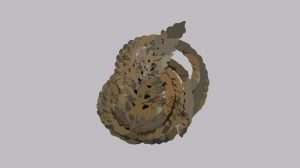
Found on Oak island. Three spirals. '13' branches. Enlarged throughout.

"Shrink away from fear and it becomes your master. Beating your chest, gnashing your teeth, and howling at the injustice of it all only exacerbates your plight."
Now from a different perspective: "In Dante's vision the masculine intellect, even at its highest and most poetic or 'magical' levels, can only go so far in the comprehension of reality, and that is to the external limits of the Earthly paradise. Therefore when Dante having traversed the deepest pits of Hell, and climbed the spiral path of Mount Purgatory, comes to the brook that circumscribes the Garden of Eden, he is able to go no further under 'Virgils' guidance. Virgil can only return to limbo, the noble but love-less state of the intellect, that can only see the world on its own terms and within its own limitations. To go further the force of 'love' is necessary {Nefertiti?}. This force is embodied by Beatrice, who expresses...[From the book by G. Knight. Emphasis, this readers]. Try ''grace''. Its intent and 'purpose'. In relation {say} to a ''blasted tower''.
'The Rose and the Goddess' by G. Knight.
"...that is to the external limits of the earthly paradise." Analogy with same intention: "...that active intellect, which is merely conceived by abstract theorizing, is actually encountered in the 'Event' - at the limit of the cosmos - as personified and individualised..." Enlarged elsewhere. And/or...
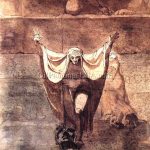
Raised arms = twin horns = ?
"Gnosis, is a feminine Greek noun, which means ''knowledge.'' It is often used for 'personal' knowledge compared with 'intellectual' knowledge {eidein}, as with the French 'connaitre' compared with 'savoir', or the German 'kennen' rather than 'wissen'...In Latin they simply drop the Greek 'G' and ''Gno'' becomes ''No'' as in 'Nosco' meaning to ''know'' and ''Noscentia'' meaning ''knowledge'' and 'Notus' meaning ''known..." [Wiki/'Gnosis'].
often used for 'personal' knowledge compared with 'intellectual' knowledge {eidein}, as with the French 'connaitre' compared with 'savoir', or the German 'kennen' rather than 'wissen'...In Latin they simply drop the Greek 'G' and ''Gno'' becomes ''No'' as in 'Nosco' meaning to ''know'' and ''Noscentia'' meaning ''knowledge'' and 'Notus' meaning ''known..." [Wiki/'Gnosis'].
Moses who was also - ''unable to go no further''...
Understanding the above also explains why streams {brooks?} had to be redirected around the tomb of the 1st Dynasty Emperor of China Prior to it being built. Representation of. Proving that regardless of character, all attempted to be associated with it. All {if only in those ancient days} attempted to be identified with it. The real questions however - REMAIN THE SAME. Fact or fiction. A possibility or not?
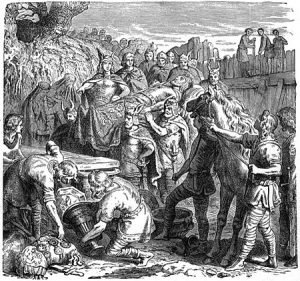
Alaric the 1st. King of the Visigoths. Coincidence or a meaningful one?
''During the early months of 411, while on his northward return journey through Italy, Alaric took ill and died at Consentia in Bruttium. His cause of death was likely fever, and his body was, according to legend, buried under the riverbed of the Busento in accordance with the pagan practices of the Visigothic people. The stream was temporarily turned aside from its course while the grave was dug, wherein the Gothic chief and some of his most precious spoils were interred. When the work was finished, the river was turned back into its usual channel and the captives by whose hands the labour had been accomplished were put to death that none might learn their secret.'' [Wiki].
''Gnosis'' in relation to up-stream / down-stream. As a means....?
Refresher: An American / Mongolian student. The archetypal equivalent...that every student aspires to. Attributes of determination / fortitude / discipline / purpose...all forged together within that most important one. The well grounded one, [as well as the obvious intelligence]. Sets off to find the lost tomb of Genghis Khan. Galvanized by the tales told by one of his relations. That their ancestors "had come from the North", [ ‘Lost tomb of Genghis Khan’. National geographic channel. Can also be seen on ‘You tube’ ].

Flat top?
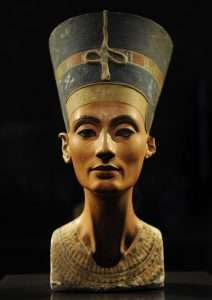
Wearing a flat or rounded top: 'Stamp of the feminine'? Real or symbolic?
A ‘temple’ structure of some description was finally located within a certain ‘mountain’. just as Khufu-s sarcophagus was found within the kings chamber within that well known similar structure...but no body was found. Or will be found. To find that location, understand this subject.
A river with two forks also mentioned within the above. As is: ''He was out hunting or chasing wild horses one day when he came across a solitary tree and said to himself: 'This is a good spot to be my final resting place.''
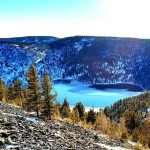
Analogy: ''Loughcrew or Lough Crew (Irish: Loch Craobh, meaning 'lake of the tree') is an area of historical importance near Oldcastle, County Meath, Ireland. It is home to a group of ancient tombs from the 4th millennium BC, some decorated with rare megalithic art, which sit on top of a range of hills. The hills and tombs are together known as Slieve na Calliagh (Sliabh na Caillí)[1] and are the highest point in Meath. It is one of the four main passage tomb cemeteries in Ireland and is a protected National Monument. The area is also home to the Loughcrew Estate, from which it is named.''
Cairns to enlarge.
A side step: "This evening Bhaduri expounded various philosophical points connected with the life of Mirabai, a medieval Rajputani princess who had abandoned her court life to seek the company of saints. One great sannyasi, Sanatana Goswami, refused to receive her because she was a woman; her reply brought him humbly to her feet. 'Tell the master,' She had said, 'that i did not know there was any male in the universe save God; are we not all females before him?' Enlarged elsewhere.
Anima or animus or both?

What would be used to bring together that 'circle'? Male or female aspect? 'Zodiac' to enlarge.
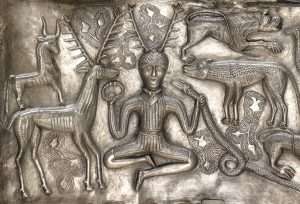
Seated on what?
Side note: From a different perspective: ''One of the most stunning examples of British La Tene art comes from a field near Snettisham, in Norfolk....Celtic treasure hoards found. One piece especially stands out - the Great Torc: a twisted gold neckring ending with ornate terminals....There were very few signs of any other human activity in the vicinity of the hoards - no settlement, no burials; only what seemed to be an unprepossessing ditch.'' [Page 113 'The Celts' / A. Roberts].
''Norfolk (/ˈnɔːrfək/) is a ceremonial and non-metropolitan county in East Anglia in England. It borders Lincolnshire to the north-west, Cambridgeshire to the west and south-west, and Suffolk to the south. Its northern and eastern boundaries are the North Sea, with The Wash to the north-west. Known for its flat lowlands.....The county town is the city of Norwich.''
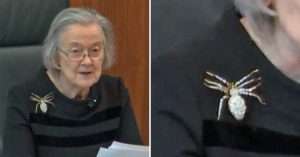 Continued: "Of course, this has to do with how one views the creation; what is exactly meant with ''creator'' and/or ''creation''. The way I see it today, the ONE mirrors itself in millions of forms, in an un believable variety. Every form and image, each facet and sound lives this uniqueness, with the knowledge within that it is only a reflection of the ONE. Because of this, I think it is wonderful to discover and live one's own being, without being identified with it. There is nothing else but THAT, the ONE. And each human being has the right to live his being, to allow HER particular fragrance to unfold as part of the whole." [Page 37 ' The Path has No Name' / Annette Kaiser].
Continued: "Of course, this has to do with how one views the creation; what is exactly meant with ''creator'' and/or ''creation''. The way I see it today, the ONE mirrors itself in millions of forms, in an un believable variety. Every form and image, each facet and sound lives this uniqueness, with the knowledge within that it is only a reflection of the ONE. Because of this, I think it is wonderful to discover and live one's own being, without being identified with it. There is nothing else but THAT, the ONE. And each human being has the right to live his being, to allow HER particular fragrance to unfold as part of the whole." [Page 37 ' The Path has No Name' / Annette Kaiser].
And/or..."In this last title, Queen of Peace, she shows an aspect of the feminine principle that is akin to a great figure who wanders like a shadow through the early pages of biblical history, the great high priest Melchizedek. His name means 'priest-king' and his title, King of Salem, means King of Peace." [From the book by G. Knight]. Question. Anima or animus?
Silence is golden?
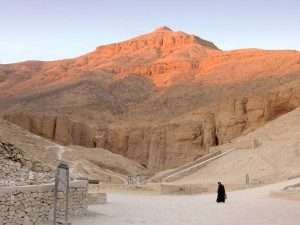
'Spring' waters / 'Flood' waters as a means....? Which and Why?
From a different perspective {that first one?}: ".....Previously, a ram {Aries?} had been thrown into the water as a sacrifice to Pylaochos - the 'guardian of the gate'. The lake of Lerna, situated between the limestone mountains {'stalagmites'?} of Lerna, whose flanks had been inhabited since Neolithic times, and the sea - was fed by many springs, which characterised it as belonging to the 'underworld'.....Dionysos disappeared for a time into the underworld, and ever since his 'cult' came to this 'coast' {boundaries/cycles link?} the ''disappearance'' was enacted in a ceremony in which a 'young bull' {lower aspect mastered? and/or Taurus link?} was sacrificed....The gods descent and return from the waters of Lerna was interpreted as a journey to bring back his 'mother' from the realm of the dead. In connection with this interpretation, there is a strange tale to the effect that Dionysos paid a high price for his journey to the 'underworld' in the lake of Lerna {fresh water?}- total 'effeminization' - and that after his return he set up a phallus as a cult symbol {something mastered/understood? - represented from the 'lower' regions?}...." [Pages 180/1 'Dionysos: Archetypal Image of Indestructible Life' / C. Kerenyi].
'Still waters run deep'? and ''She who loves silence''?
'Lady of the Lake'?

Inner/outer as a means...? Phaistos Disk?
Something extra {something that can be worked out by the objective process}: ''Lets look at the word 'Xeper'. We have seen its relationship with Thelema {'desire' i.e., in the wisdom sense of the word}, and how that Word generated the matrix {i.e., as one example - 'web'?} that produced Xeper {Cayce's Hall of Records'?}…..First encountered by E. A. Wallis....it allowed for a 'death' that had both power in the real world {'east'?} and potential for knowing the secrets of the cosmos in the next world {'west'?]….Very old in Egyptian religion....I was not the first to utter Xeper. According to mythology the first was Mehen-Pet-Tha - mentioned by 'Set' {'shadow'} in the 'The Book of Coming Forth by Night' {Duat?}. I had really looked for that name in writings about New Kingdom times: the board game of Horus and Set called Mehen was popular then.....'She who kindles celestial fire' - belonging to a 'princess' of the second dynasty - the son of Peribsen, the only pharaoh to call himself a ''Living Set'' rather than a 'Living Horus''....As a 'princess' he would have been a high priest..." [Page 168 'Overthrowing the Old Gods' / A. Crowley/Don Webb].
Drag queen only?
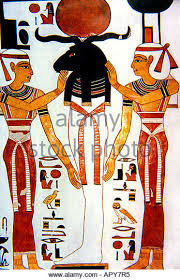
'He' or 'She'?
Side note: "The meaning of Amun's name is unknown, except that it is the same word used to express ''to hide'' {shadow?}, and ''hidden''. However, the word in Egyptian is also used in the action ''to make firm, establish, fortify''...Amun was the exclusive patron of the Royal House in the Middle Kingdom. He was the 'Lord of Kings'', being the prototype of the mature, fully realized human being...Amun embodies both past and future of human experience - the principle of completion." [Page 104/5 of the book by R. Clark].
 Analogy of same?..."All the old sea powers of the Titanic mythology relate to this power of the feminine, for in the ancient times it was predominant in the development of infant man. It is still as much a power today although during the epoch of mankind's adolescence - which covers the historical period - there has been a reversion from the feminine. This may have been a necessary phase but the feminine principle is not something that will simply go away. It pertains as much to 'god' as does the Masculine principle. Only in the balanced union of the two can progress to maturity be made..." [Extract from the book by G. Knight. Emphasis, this readers].
Analogy of same?..."All the old sea powers of the Titanic mythology relate to this power of the feminine, for in the ancient times it was predominant in the development of infant man. It is still as much a power today although during the epoch of mankind's adolescence - which covers the historical period - there has been a reversion from the feminine. This may have been a necessary phase but the feminine principle is not something that will simply go away. It pertains as much to 'god' as does the Masculine principle. Only in the balanced union of the two can progress to maturity be made..." [Extract from the book by G. Knight. Emphasis, this readers].
Aries {ram} / Libra = ''a balance''? as a means - towards a mind set?
Try re-ligion - its true meaning in relation to anima/shadow as a MEANS to express something.
"I owe a debt of gratitude to my friend J. Michell whose book 'City of Revelation' led me to the study of Greek gematria and its pre-Christian origins. It was the musicologist Joscelyn Godwin who introduced me to the monochord - and hence the ancient science of harmonics - which also marked an important turning point in my research. This experience led me to notice the fundamental relationship between Greek gematria and Pythagorean theory of Means. Siemen Terpstra, another servant of the Muses, also came along at the right time; his monograph on 'Means and Music' helped lead me to recognize that ratios of the Means themselves, define the central values of Greek gematria..." [Preface, 'Jesus Christ sun of God: Ancient Cosmology and early Christian Symbolism'. Mentioned elsewhere].
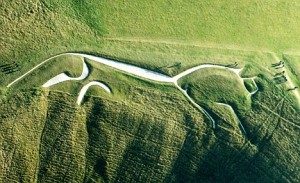 "Nature is a net of correspondence to be deciphered and integrated into a holistic {'whole'?} worldview {'Amon'?}." [extract from the book 'The Magister'. Parenthesis, this readers].
"Nature is a net of correspondence to be deciphered and integrated into a holistic {'whole'?} worldview {'Amon'?}." [extract from the book 'The Magister'. Parenthesis, this readers].
N.B. The root of the word ''holy'' = whole, i.e.,a reunion of the ''whole?'' By way of ''correspondences?''
''The whole gamut of human experience {and/or emotions}''. Question. What animal represents that final word? ...Why?
'The Festival of the Re-union'. Enlarged elsewhere, i.e.,'re-ligion' and/or 'Re' and/or ro-setau link? Don't forget those 1st impressions.
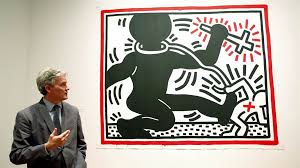
Question. Shadow self? Therefore - 'lower'? S/W? And/or ''the reward comes when we are able to let it go and see the bigger picture.'' {S/E?}. Enlarged elsewhere.
Think about it, not just in relation to a 'direction' but the significance of what 'navel' represents, within same, relative to 'positive/negative.' Final link to Artemis. Explained within. This subject clarifies and verifies that 'possibility'. Think about it, in relation to Horizontal / Vertical symbolism, together with what; as in the Egyptian case; Horus represents, within those 'units of time', [explained within]. That link to the 'development' of same over those 'units of time' [i.e., as an example; as in the Egyptian case; between the first and third uraeus, in relation to the rest of the acclaimed 'framework'] that allows the possibility of an understanding in explaining those 'synchronistic' moments that take place in relation to the individual effort, and... those simultaneous discoveries of human innovations ["that appear in different peoples minds simultaneously"], in relation to the collective one, as speculated in chapter four of 'The Source Field Investigations'. Sometimes we all need one in order to have that flash, [ lightening ]...of inspiration. In order to begin that understanding of something new. A kick up the proverbial spinal column, regardless of whether it be a synchronistic 'event' or otherwise.
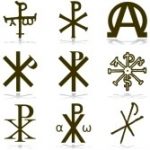 SIDE NOTE: {a working example?}: "Through Christ, there can enter into the winter cold {S/W?} of knowledge a warmth which in no way obscures or corrupts it, but gives it life; and into the stormy creative chaos of the instinctive life {Cernunnos?} - he brings a light {'Lucy' and/or S/E?} which does not lame it {S/W?} but purifies and redeems it." ['The Flaming Door']. Enlarged elsewhere.
SIDE NOTE: {a working example?}: "Through Christ, there can enter into the winter cold {S/W?} of knowledge a warmth which in no way obscures or corrupts it, but gives it life; and into the stormy creative chaos of the instinctive life {Cernunnos?} - he brings a light {'Lucy' and/or S/E?} which does not lame it {S/W?} but purifies and redeems it." ['The Flaming Door']. Enlarged elsewhere.
Side note: ''...does not lame it.'' Hephaestus link? If so, what does that imply within the whole? S/W? and/or ''Scorpion'' link?
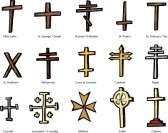 ''Sacred kings, it seems, were not allowed to rest their heels on the ground but walked on their toes....the high heeled buskin of the god Dionysus can be explained only in this sense...'' [Page 315 'White Goddess'].
''Sacred kings, it seems, were not allowed to rest their heels on the ground but walked on their toes....the high heeled buskin of the god Dionysus can be explained only in this sense...'' [Page 315 'White Goddess'].

"To know one's onions." Which corner?
And/or: "But what evidence is there for any lameness in Dionysus? Why should the buskins not have been worn merely to add to his height, rather than as surgical boots to compensate for his deformity? The best evidence is his name, Dio-nysus, usually translated as 'The Light God of Mount Nyse' but more likely to mean 'The Lame God of Light'. Nysos was a Syracusan word for 'lame' and therefore probably of Corinthian origin, for Syracuse was a colony of Corinth. Yet, as Mr. E. M. Parr has pointed out to me, Dionysus may really have taken his name from Nyse, Nyssa or Nysia, a name attached to various shrines in the area where the sacred lameness was cultivated. There are three Nyssas in Asia Minor, three Nysias in Thrace, a Nyza near Mosul, and a Nysia in Arabia where, according to Diodorus, the Goddess Isis was born. This suggests that Nyse was a title of Isis, and that since Dionysus was a tide of the Libyo-Thracian Harpocrates, her lame son, the Corinthian Greeks read Nysus, which was really his matronymic, as meaning 'lame'.

'light oxen': "I bring up an individual type as a point of departure to talk about. The one {'emotion'?} that is strongest will pull you first." [Page 4 'Stopping and Seeing' / Translated by T. Cleary]. REFRESHER: "The elephant is the only animal that cannot leap."
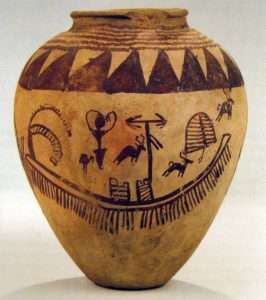
The Rump is part of the Arabian megaconstellation of the Lion (al-asad). It lies well south of the rest of the Lion, so it may have been a later addition to the figure.
Nonnus, in his Dionysiaca, writes that the name Dionysus means "Zeus-limp" and that Hermes named the new born Dionysus this, "because Zeus while he carried his burden lifted one foot with a limp from the weight of his thigh, and nysos in Syracusan language means limping".[31] In his note to these lines, W. H. D. Rouse writes "It need hardly be said that these etymologies are wrong".[31] The Suda, a Byzantine encyclopedia based on classical sources, states that Dionysus was so named "from accomplishing [διανύειν] for each of those who live the wild life. Or from providing [διανοεῖν] everything for those who live the wild life."[32]

Ingots of copper to look like ox hides.
Other Mycenaean records from Pylos record the worship of a god named Eleuther, who was the son of Zeus, and to whom oxen were sacrificed. The link to both Zeus and oxen, as well as etymological links between the name Eleuther or Eleutheros with the Latin name Liber Pater, indicates that this may have been another name for Dionysus. According to Károly Kerényi, these clues suggest that even in the thirteenth century BC, the core religion of Dionysus was in place, as were his important myths. At Knossos in Minoan Crete, men were often given the name "Pentheus", who is a figure in later Dionysian myth and which also means "suffering".

Friend. What happened to you're shoes? They kinda got ahead of me."
Shell cordovan, cordovan, or cordwain is a type of tanned leather commonly used in high-end shoemaking. Cordovan is an equine material made from the superficial fascia (or shell) of the lower layers of the hide on the rump of a horse.[1]
'Tail' end?

Shoeless Joe Jackson.
Side note: The Sed festival (ḥb-sd, conventional pronunciation /sɛd/; also known as Heb Sed or Feast of the Tail) was an ancient Egyptian ceremony that celebrated the continued rule of a pharaoh. The name is taken from the name of an Egyptian wolf god, one of whose names was Wepwawet or Sed.[1] The less-formal feast name, the Feast of the Tail, is derived from the name of the animal's tail that typically was attached to the back of the pharaoh's garment in the early periods of Egyptian history. This tail might have been the vestige of a previous ceremonial robe made out of a complete animal skin.[2] The ancient festival might have been instituted to replace a ritual of murdering a pharaoh who was unable to continue to rule effectively because of age or condition.[3][4]
Continued: The material derives its name from the city of Cordoba, Spain, which was long known as a center of leather production.[2] It is a difficult and expensive material to make, and in the late 19th and early 20th century was mostly used for razor strops to hone razors in barber shops. More recently it has been increasingly used for shoes, wallets, and watch straps due to its visual appeal and exceptional durability. It is also used in archery to protect the fingers. It is smooth and durable, ideal for a finger tab. Shell cordovan has a unique non-creasing characteristic. Because it is made of connective tissue, it is smooth and lacks the pebbled effect of leather derived from the outer skin.[3]

light oxen.

"Serpent hands": Elephant and Castle is an area of South London, England, in the London Borough of Southwark. The name also informally refers to much of Walworth and Newington, due to the proximity of the London Underground station of the same name. The name is derived from a local coaching inn.
Why 'Cordovan' leather? Probably because the Llew cult came to Britain from Spain, as it is known that the buskin did. At Uxama in Spain a dedication has been found to 'the Lugoves', i.e. the Lughs, by a guild of shoemakers. And why coloured and gilded shoes? Because such shoes were a symbol of royalty among the Celts. They used also to figure in the English Coronation ceremony, but dropped out after the reign of George II. Though officially styled 'sandals', they were gilded half-boots, like the purple buskins in which the Byzantine Emperors were crowned, with purple soles and wooden heels covered with scarlet leather. Scarlet was a product of the kerm-oak and doubtless the heels were oaken. In the Romance the colour of the shoes is not specified; which suggests a further connexion with Spain, where bosAeguis de piel Colorado does not mean 'buskins of coloured leather', but 'buskins of scarlet leather'. Similar buskins are thought to have been used in the sanctification of the kings of Rome, since they were part of the sacred dress of the Triumphant General in Republican times, and this dress was of regal origin. Sandals also occur in the legends of the solar hero Theseus, whose Goddess mother gave him a pair at the same time as she gave him his arms and sent him out to slay monsters; of Perseus, another monster-slayer; and of Mercury." [same].
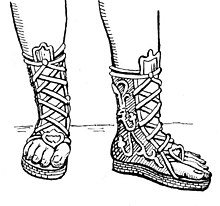 Refresher: ''On many Russian churches the crosses on the domes often have a slanting support bar underneath the cross. This is a Russian tradition that Christ was lame...'' [Page 266 'Russia: Past, Present and Future' / R. Steiner].
Refresher: ''On many Russian churches the crosses on the domes often have a slanting support bar underneath the cross. This is a Russian tradition that Christ was lame...'' [Page 266 'Russia: Past, Present and Future' / R. Steiner].

S/E or N/W as a 'start' point?
Egyptian equivalent?..."A third characteristic of the Pharaonic mentality is an appreciation of simultaneity. This is expressed in various ritual representations - encountered chiefly in the temples - by the superimposition in a single image of several points of view and moments of time. The Falcon hovering over the king is a typical example: its head is in profile; one of its wings is represented as seen from above; the other wing and the tail are seen from below. What at first seems to be a frozen moment of flight thus actually represents several moments of flight seen together." [Extract from the book by L. Lamy. Emphasis - this readers].
Question. An objective view?
'Humming bird'?
'On Having No Head: Zen and the Rediscovery of the Obvious' / D. E. Harding.
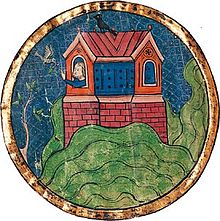

'Spirit' or 'Soul' as a start point?
A work in progress: ''May we come and go in and out of heaven through the gates of starlight. As the houses of earth fill with dancing and song so filled are the houses of heaven. I come in truth {maat}. I SAIL a long river and ROW back again....I am the sojourner destined to walk a thousand years untill i arrive at myself. I looked up to see a huge seagull HANGING in the wind, some AIRY messenger HOVERING in front of my face. It squawked once, then flew off, as if to say, 'Message received'....All became chaotic, then STILL again. And after a time of stillness, with the thunder of ice cracking {Ararat?} during a spring thaw {Easter?}, i began again to move {static/dynamic?}.'' [Page 294 'Dreams of Isis'].
'Place of Rowing'?
Hanging / Hovering / Still - as a means....?
Revolving Castle?
REFRESHER: "The science of the I Ching, indeed, is not based on the causality principle, but on a principle {hitherto unnamed because not yet met with among us}, which I have tentatively called the 'synchronistic' principle. My occupation with the psychology of the unconscious processes long ago necessitated my casting around for another explanatory principle, because the causality principle seemed to me inadequate for the explanation of certain remarkable phenomena of the unconscious {Wolfgang Pauli?}. Thus I found, that there are psychic parallelisms which cannot be related to each other causally, but which must stand in another sort of CONNECTEDNESS. This connection seemed to me to lie mainly in the relative simultaneity of the events, therefore the expression 'synchronistic'..." [Page 141, The Secret of the Golden Flower / R. Wilhelm WITH a commentary by G. Jung].
 Try ''simultaneous'' to see subject material in the universal sense of the 'word' - since the oral tradition BEFORE ''the written word came into common use''. Then try ''event''.
Try ''simultaneous'' to see subject material in the universal sense of the 'word' - since the oral tradition BEFORE ''the written word came into common use''. Then try ''event''.
'On Having No Head: Zen and the Rediscovery of the Obvious' / D. E. Harding.
"To become conscious of itself it makes itself simultaneously a subject and object." [From the book by T. Freke and P. Gandy].
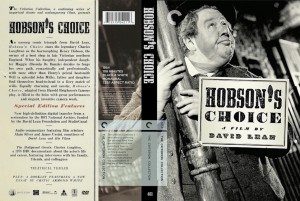
Something closer to the 'mark'. Middle England leading the Way?
Apply the above to define the following..."Adrian Gilbert, who was previously mentioned, has written several books on the subject of ancient knowledge and esoteric wisdom. In his book 'Signs in the Sky' he noted that the term 'serpent' was frequently used in ancient times to define a shadow cast by the sun. I couldn't help remembering that the Celtic cross in Northamptonshire shows an image of intertwined serpents on the circular head. This would make sense if the cross were used for measurements using the shadow of the sun, and a shadow was regarded in ancient times as a serpent." [From the book by K. Gest].
'Shadow' in relation to 'light' as a means...?
''The lengthened shadow of man is history''.
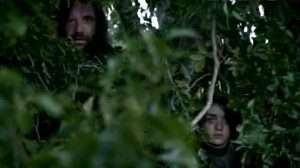
Green man?
The author of 'Where is Saint George: Pagan Imagery in English Folklore' attempting to define this subjects material by way of those repetitive universal keys [throughout]- in folk-songs...
"The 'Dilly Song' is surely the best known and most popular of all true folk-songs. It is still widely sung throughout Britain... in its variation called 'Green grow the Rushes oh...
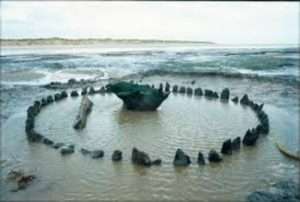
As for what the rituals at Holme I and II may have involved, Dr Nance’s paper delves into folkloric beliefs relating to the changing of the seasons, linking these to the solid wall formed by the original arrangement of Holme I’s posts, and explores ideas of the symbolic significance of the penned cuckoo, and of sacral kingship. He also highlights the monument’s alignment with the sun during the summer solstice. The full paper is published at https://link.springer.com/article/10.1007/s10708-024-11088-5.
"The 'Dilly' bird which perches upon the tree of life may be seen as cult bird, such as the woodpecker or cuckoo, which are both seldom seen but heard..."
A work in progress: ''With the constellation representing the mythological Greek huntsman Orion, Rigel is his knee or (as its name suggests) foot; with the nearby star Beta Eridani marking Orion's footstool.[27] Rigel is presumably the star known as "Aurvandil's toe" in Norse mythology.[76] In the Caribbean, Rigel represented the severed leg of the folkloric figure Trois Rois, himself represented by the three stars of Orion's Belt. The leg had been severed with a cutlass by the maiden Bįhi (Sirius).[77] The Lacandon people of southern Mexico knew it as tunsel ("little woodpecker").[78]
A 'green one'?
Rigel was known as Yerrerdet-kurrk to the Wotjobaluk koori of southeastern Australia, and held to be the mother-in-law of Totyerguil (Altair). The distance between them signified the taboo preventing a man from approaching his mother-in-law {'line of sight' or AFAR?}. The indigenous Boorong people of northwestern Victoria named Rigel as Collowgullouric Warepil.[80] The Wardaman people of northern Australia know Rigel as the Red Kangaroo Leader Unumburrgu and chief conductor of ceremonies in a songline when Orion is high in the sky. Eridanus, the river, marks a line of stars in the sky leading to it, and the other stars of Orion are his ceremonial tools and entourage. Betelgeuse is Ya-jungin "Owl Eyes Flicking", watching the ceremonies.[81]
The Māori people of New Zealand named Rigel as Puanga, said to be a daughter of Rehua (Antares), the chief of all-stars.[82] Its heliacal rising presages the appearance of Matariki (the Pleiades) in the dawn sky, marking the Māori New Year in late May or early June. The Moriori people of the Chatham Islands, as well as some Maori groups in New Zealand, mark the start of their New Year with Rigel rather than the Pleiades.[83] Puaka is a southern name variant used in the South Island.[84]
In Japan, the Minamoto or Genji clan chose Rigel and its white color as its symbol, calling the star Genji-boshi (源氏星), while the Taira or Heike clan adopted Betelgeuse and its RED color. The two powerful families fought the Genpei War; the stars were seen as facing off against each other and kept apart only by the three stars of Orion's Belt.
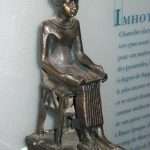
Imhotep: Copper? The ORIGINAL 'incarnation'. The beginning of something.
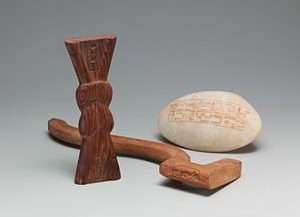
Which of the 'two suns' does the 'white stone' belong to?
And/or: ''Greeness is the overcoming of the dualism between earthly and heavenly....Link to the ''two suns'' i.e., a fulfilment that is both physical and divine...The soul flows through the body like sap through a tree....Zosimus tells how the 'two suns' of copper alchemy creates a flowering 'king on the earth'..This 'greening wisdom' {'language'?} underlies some of the most important and prestigious treatises of European Alchemy....and to the Christian mystery of the Incarnation, the union of the human and the divine.'' [Page 208 'Hathor's Alchemy'].
Smith/Jones to enlarge. Then 144.
And/or: ''Ibn Umail associates it with the 'soap of wisdom' and the green substance with growing 'out of copper' {verdigris}. He also compares the 'divine water' with the 'green woodpecker'. Arnauld of Villanova refers to the 'greeness' in gold that makes it 'true gold' not 'common gold'....'' [Page 294].
Refresher: The temple of Serabit el-Khadim is located on a plateau on top of a mountain in south-west Sinai. From earliest dynastic times, pharaohs sent expeditions to Sinai in search of turquoise and copper, and abundant seams of turquoise were found in the Serabit region. Hathor had the epithet ‘Lady of Turquoise’, so it is no surprise to find a temple dedicated to Hathor near the mine workings.

Entrance or exit? Spirit or soul?
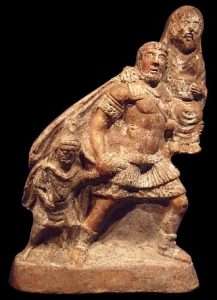
Someone exiting Troy. To go where? A corner stone? {i.e., 'right angle'}. Recall the ''left'' one in Egypt.
Analogy: ''These proficients have two kinds of imperfection: the one kind is habitual; the other actual. The habitual imperfections are the imperfect habits and affections which have remained all the time in the spirit, and are like roots, to which the purgation of sense has been unable to penetrate. The difference between the purgation of these and that of the other kind is the difference between the root and the branch, or between the removing of a stain which is fresh and one which is old {'hoary'?}, and of long standing. For, as we said, the purgation of sense is only the entrance and beginning of contemplation {or study}, leading to the purgation of the spirit, which, as we have likewise said, serves rather to accomodate sense TO spirit than to unite spirit with god. But there still remain in the spirit the stains of the old man, although the spirit thinks not that this is so, neither can it perceive them; if these stains be not removed with the SOAP and strong lye of the purgation of this night, the spirit will be unable to come to the purity of Divine union.'' [Page 43 'Dark Night of the Soul' / St. John of the Cross].
Help section to enlarge, i.e., ''in that sense of the word.''
Smith/Jones to enlarge.
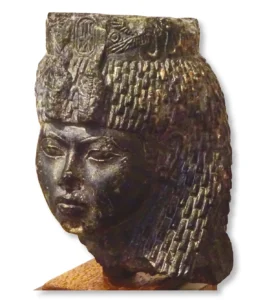
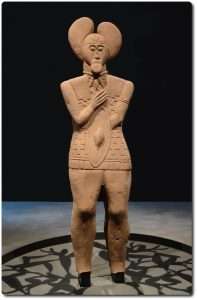
Happy or sad?
A working example: The temple of Serabit el-Khadim is located on a plateau on top of a mountain in south-west Sinai. From earliest dynastic times, pharaohs sent expeditions to Sinai in search of turquoise and copper, and abundant seams of turquoise were found in the Serabit region. Hathor had the epithet ‘Lady of Turquoise’, so it is no surprise to find a temple dedicated to Hathor near the mine workings....The temple is compact, about 70m long by 35m wide, but full of stelae erected along its processional routes. Although the temple that we see today was started by Senusret I, Petrie reports finding the breast and back of a stone falcon, inscribed with the cartouche of Sneferu, which he thought dated to that king’s reign (c.2613-2589 BC). This would make it the earliest object found at the site, but Gardiner (1955) describes this dating as ‘very suspect’. It is probably a later piece on which the cartouche of Sneferu was written to celebrate his memory.
Petrie also found a small head of green steatite {soap stone}. It is only 7cm high, but would have been part of a statuette, around 30cm tall, dedicated to Hathor. The cartouche on the forehead identifies Queen Tiye, wife of Amenhotep III. The head’s features follow the artistic principles of that time, with almond-shaped eyes and a thin nose. The down-turned mouth is often seen in portrayals of Tiye, and has led to her reputation as a tough character. Petrie writes of the ‘haughty dignity of the face’ and how the expression is one of ‘disdain without malice’. ['Page 52 'Ancient Egypt' - Nov-Dec 2024].
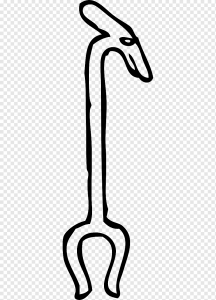
Egyptian 'Uas' Sceptre.
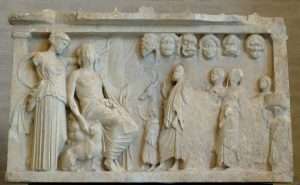
Attic relief (4th century BCE) depicting an aulos player and his family standing before Dionysos and a female consort, with {six?} theatrical masks displayed above. Sculpture = 'added'? Question. All within a mantle {'fireplace'}. Overhang? HOOD to enlarge.
Side note: "According to the trieteric order {esoteric?}, Dionysos would have 'remained' on earth for the next twelve months. According to the Athenian order, he was 'divided' again after a brief period and became double, simultaneously above and below. It was the superstitious fear in a later period that made the Athenians chew rhamnus leaves all day on the 12th of Anthesterion and smear their doors with pitch. The singers of dithyrambs who appeared that day at the Altar of the Twelve gods on the Agora {zodiac/'higher' link} must also have been chewing leaves! For the first time we glimpse such a chorus on an Attic krater {vessel for mixing water/wine - often seen in a room on a tripod - and used at funerary functions} of the 5th century. The vase painting represents 'four' men whose names are indicated, all wearing 'long garments'. The poet Phrynichos and a flute player are in the middle {'octave'?}. They are characterised by branches {tree link} or wreaths of ivy, and since they do not wear masks or theatrical costumes it seems probable that they are singing no other Dionysian song than the dithyramb. The strange structure consisting of a long pole and a crossbeam {perch/bench link?} around which they are grouped is also carried on an Attic chous by 'children' acting out the 'marriage' procession of Dionysos....
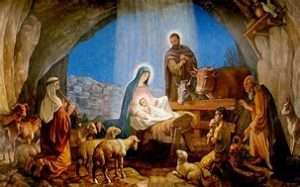
Manger: "to eat" or "to chew."
This same structure appears again much later in representations of the myth of Dionysos childhood. This object can only be explained as a vestige of the Dionysian idol, which after the 'thigh' {below?} birth was replaced by the god in mobile, dynamic forms {'static' link?}. In the dithyramb the god is sung to as one who has just been 'born' after a long childbirth." [Pages 304/5 'Dionysos' / C. Kerenyi].
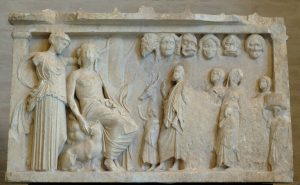
Relief flute player. Pied piper?
Side note: ABOUT this epoch, and perhaps a little earlier, several things came to pass which influenced in a perceptible manner the civilization of the Celts. The Druids, in listening to the oracles of Voluspa, perceived that these oracles were always contained in measured phrases of regular form, drawing with them a certain harmony which varied according to the subject so that the tone with which the prophetess pronounced her sentences differed much from the ordinary language. They examined attentively this singularity, and, after becoming accustomed to imitate the diverse intonations which they heard, they succeeded in reproducing them, and saw that they were harmoniously adjusted according to fixed rules. These rules, reduced to a system by dint of hard work, gave them the principles of two of the most beautiful conceptions with which men have been able to honour themselves—music and poetry. Such was the origin of melody and rhythm.
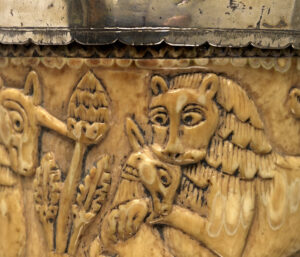
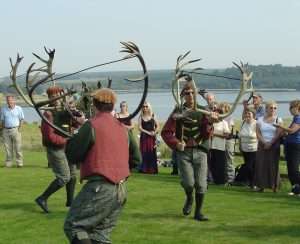
Horn Dance. Blithfied Reservoir
Until then, the Celts had been little affected by music. That of the Atlanteans, which they had heard in combats or in ceremonies, seemed to them only noise more or less loud, shrill, or low. Seeking to outstrip their enemies they had duly invented instruments warlike and monotonous, such as drums, the cymbal, the horn, and the bucine, by means of which they indeed filled the air with noises or formidable sounds but without any melody. It was not until their priests had received from Voluspa the principles of musical and poetical harmony that they began to find any charm in it. The flute, whose inventor was a favoured genius, caused a revolution in the ideas {'octave'?}. They saw with inexpressible rapture that they could follow with this instrument the voice of Voluspa and, as it were, recall her words by the sole repetition of the sounds which she had attached to them. The repetition of these sounds constituted the poetic rhythm. This rhythm, presented to the nation as a gift from heaven, was received by it with an enthusiasm difficult to express. It was learned by heart, chanted on all occasions, inculcated at an early age in the minds of the children; so that in a very short time it became instinctive, and by means of it one was able to spread with the greatest facility the text of all the oracles or all the laws which Voluspa always uttered in the same measure. Such was the reason for which in antiquity, music and poetry were never separated and were likewise called the language of the gods.
Continued: "Dithyramb, choral song in honour of the wine god Dionysus. The form was known as early as the 7th century BC in Greece, where an improvised lyric was sung by banqueters under the leadership of a man who, according to the poet Archilochus, was “wit-stricken by the thunderbolt of wine.” It was contrasted with the more sober paean, sung in honour of Apollo. The word’s etymology is uncertain, although, like other words that end in amb, it seems to be of pre-Hellenic origin.
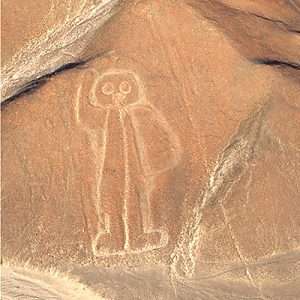
And/or: Sack is an antiquated wine term referring to white fortified wine imported from mainland Spain or the Canary Islands.

'Glass' of wine or water?
The dithyramb began to achieve literary distinction about 600 BC, when, according to the Greek historian Herodotus, the poet Arion composed works of this type, named the genre, and formally presented them at Corinth. In the last decades of the 6th century BC in Athens, during the tyranny of Peisistratus, a dithyrambic competition was officially introduced into the Great Dionysia by the poet Lasus of Hermione. Dithyrambs were also performed at other festivals. The performance of dithyrambs was grandiose and spectacular: after a prologue spoken by the group’s leader, two choruses in expensive apparel—one of 50 men and the other of 50 boys—sang and performed circle dances around the altar of Dionysus. Auloi (wind instruments with double reeds) provided the instrumental accompaniment."
Continued: 'Joined at the hip' in relation to mineral/plant/animal....as a means...? [Pages 445-450 'Secret History of the World'].
The author E. Reymond {'Origin of Egyptian Temple'} also attempts to determine the symbology of the ''perch''. Question. What normally perches in a tree. Male/female? Higher/lower?
And/or: A metal ''Tripod''? Therefore 'fire' link i.e., forged by fire {blacksmith?}. Recall what the first three letters of same shape {i.e., pyramid} - relate to. 'Fire' in relation to 'water' . Lower/higher? Above/below as a means....?
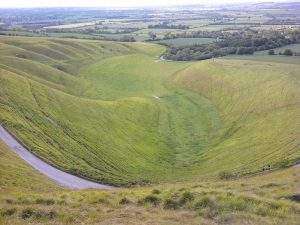
"The Manger - looking north west. The Manger is a strangely shaped valley, which is thought to have been formed by the melting of ice in the last Ice Age. Folklore suggests that the manger is the supernatural feeding place for the White Horse, which would travel from its vantage point on the crest of the hill on moonlit nights."
"No man having drunk old wine desires new. The old is better. Thus said the Lord. Stand thee in the ways, and see, and ask for the old paths - which is the good way - and walk therein, and you shall find peace {Hotep?} for your souls." [New Testament].
Continued: "To put the Dilly song into a true context within the folk-song and folk-lore, a new method of interpretation is needed. The archetypal of the song is an exposition of the Divine Universe through various stages {simultaneous?} of manifestation. Once this simple fact has been realized, it is easy to understand why varying faiths all have versions of their own, each apparently deriving from early forms which have in common a 'mystical' concept." Try ''simultaneity'' - a few paragraphs back.
Question. Gullible; illusional?
The word 'serendipitous' explored throughout, in relation to the discoveries made in all sciences. Synchronicity also explains that same process. Explained within. ['Infinite Monkey Cage' / BBC 4 / B. Cox and R. Ince. 23.2.15]. Try ''simultaneously''
 ‘Thread / Weaving’ terms became symbolic of the overall framework. 'Arachne Rising'. By J. Vogh, is a good start on the ‘Weaving’ theme to the overall subject, i.e., all Anrthropods = ‘unconscious’ aspects of inspirations/aspirations. Both positive/negative. Explained elsewhere. Mainly because of size and especially color, i.e., most are ‘dark’ colored [ unaware link ]. Egyptian equivalent with same intent, but now after a further 'understanding' has taken place...the 'goddess' Neith. One of Egypts 'oldest'. Whose main fame was established at Sais, in the Nile Delta. The 'goddess' of 'Weaving' and 'Hunting'. Question. 'Hunting' for what? Possible answers found in 'The Thread Of Ariadne' by C. Herberger.
‘Thread / Weaving’ terms became symbolic of the overall framework. 'Arachne Rising'. By J. Vogh, is a good start on the ‘Weaving’ theme to the overall subject, i.e., all Anrthropods = ‘unconscious’ aspects of inspirations/aspirations. Both positive/negative. Explained elsewhere. Mainly because of size and especially color, i.e., most are ‘dark’ colored [ unaware link ]. Egyptian equivalent with same intent, but now after a further 'understanding' has taken place...the 'goddess' Neith. One of Egypts 'oldest'. Whose main fame was established at Sais, in the Nile Delta. The 'goddess' of 'Weaving' and 'Hunting'. Question. 'Hunting' for what? Possible answers found in 'The Thread Of Ariadne' by C. Herberger.
'Cities of Dreams: When Women Ruled the Earth' by Stan Gooch.
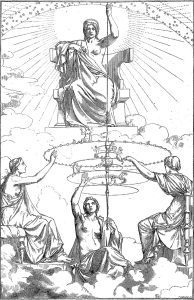
In ancient Greek religion, Ananke (/əˈnæŋkiː/; Ancient Greek: Ἀνάγκη), from the common noun ἀνάγκη ("force, constraint, necessity"), is the Orphic personification of inevitability, compulsion, and necessity. She is customarily depicted as holding a spindle. One of the Greek primordial deities, the births of Ananke and her brother and consort, Chronos (the personification of time, not to be confused with the Titan Cronus), were thought to mark the division between the eon of Chaos and the beginning of the cosmos.
"A few mornings later i made my way to Masters empty sitting room. I planned to meditate, but my laudable purpose was unshared by disobedient thoughts. They scattered like birds before the hunter." [Extract from the book 'Autobiography of a Yogi'. Mentioned elsewhere].
'The Heart of the Hunter' by Laurens Van der Post.
"The no-mans land between Physics and the psychology of the Unconscious [is] the most fascinating yet the darkest hunting ground of our times." Carl Jung.
That familiar subject again. Question. Why?
"There may well be useful parallels to be drawn between analytical psychology and magic, one with its approach to the Unconscious, the other to the Anima Mundi or the 'astral light', but such terms are not necessarily completely interchangeable. We must be beware of substituting one set of ill-understood and inadequate terms for another set - thinking that we are gaining great wisdom thereby. [Extract from the book by G. Knight].
"At Sais is found the 'tomb' of Him whom i hesitate to name...About these Mysteries, all of which, without exception, are known to me, may my lips maintain a religious silence. [Quote by Herodotus ].
'Tomb' in relation to 'Womb' - as a representation of something - other than the obvious.
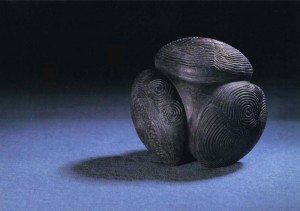
Question. Stylized dolmen in 'mini-me' form i.e., representing 'micro'? Other 'spiral' examples seen in the program by N. Oliver. Enlarged elsewhere.
"...To penetrate the mysteries of the forces that lie beyond physical life there are the two avenues that we discussed at the beginning of this book. One is the attempt to go on beyond death into the 'earth' or the tomb. The other is to attempt to get back to conditions before birth via woman or the womb. In terms of the symbolism of the circled cross {enlarged elsewhere} - this may be expressed by placing gateways at North and South. To be within physical incarnation is to be in the Western half of the circle. Then the two gateways form two alternative ways of penetrating the Eastern, inner half.
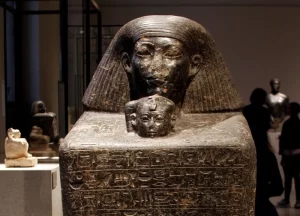
Neferure or Neferura (Ancient Egyptian: Nfrw-Rꜥ, meaning The Beauty of Re) was an Egyptian princess of the Eighteenth Dynasty of Egypt. She was the daughter of two pharaohs, Hatshepsut and Thutmose II. She served in high offices in the government and the religious administration of Ancient Egypt.
The northern gateway leads through the 'tomb' {S/W? and/or 'unconscious'?}. The southern gateway back through the 'womb' {S/E? and/or 'conscious'?}. As we have said, the primitive techniques for this were blood and sacrifice and orgiastic rites but neither of these methods are valid means of spiritual progress nowadays. The evolution of consciousness has moved on and such practices would be atavistic; degrading rather than enlightening. There is a third way, and that is the approach to the 'center' - the center of the spiral. That is, to the mid-point of the web {'net' link?} of creation. Here may be found a very ancient feminine symbol of the spider who spins and designs {''pattern" link} and builds the 'web' of MANIFESTATION. The symbol is also found in Rosicrucian literature." Continued / enlarged elsewhere. [Extract from the book by G. Knight. All emphasis, this readers].
Try ''center'' and ''mandala'' - all as a means...?
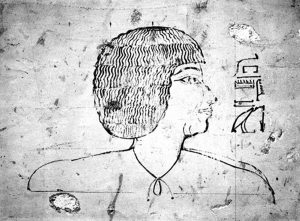
Senenmut: Steward of Amun. Wearing linen garmet that Arachne supposedly 'invented'.
AND/OR: "The relationship of these two pairs of zodiacal constellations to the Milky Way is not affected by precession and never changes. Gemini and Taurus will always mark the northern 'gate' of the Milky Way and Sagittarius and Scorpio will always mark the southern 'gate' of the Milky Way. Of the two, however, it is the later pairing that is the most important, because it so happens that the part of the Milky Way seen through this gate as we look up at the night sky forms the very center and heart of our galaxy..." {+ black hole and dark rift links}.

Gateway of Qena?
Find more information on that ''southern gate'' to see what this author is still attempting.
Refresher: "To sacrifice a 'lower' value to a 'higher' value is to give substance and power to the desire which has been 'sacrificed'. If this higher value is of a 'spiritual' order, the spiritual power is attracted by this desire, and givers to the sacrificer a power of domination over his lower states." ['Journey into the Light'].
And/or: "Everyone has an internal thought process: that silent other self who speaks to you; the one you debate with." [First sentence; first paragraph; first page of the book by Q. S. Lam].
Try Part 1 to enlarge on the word ''sacrifice'' before that inner voice {first impressions?} suggest something else. Then try ''teacher''.
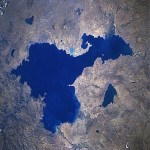
Lake Van {S/E?}.

Chess board? Triumphal {victory} Arch? Kings and Queens?
"The word 'mystery' comes from the Greek 'myein', to keep silent....The real secret about the mysteries is that they cannot be communicated by one being {'teacher'?} to another: the mystery guardian can only give guidelines and keys to knowledge, not actual knowledge itself, which is revealed to the initiate by personal experience and {or?} revelatory realisation." ['The Wester Way: A Practical Guide to the Western Mystery Tradition'. Chapter 1].
Minds eye.
Cognition.
'She Who Loves Silence'.
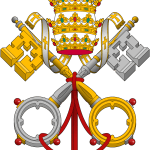
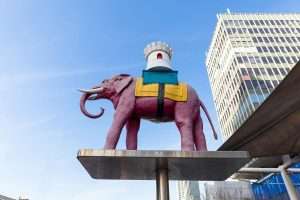 A {working?} example,i.e.,in the present moment - Finds discovered in the loch's of the Outer Hebrides {Isle of Lewis}. The islands {Crannogs} MAN MADE. 'Created' therefore a few thousand years earlier than originally thought -''right back into the Stone Age." Other artefact's very similar to the 'mini-me' ball also found, i.e., local/Orkney/''other places in Scotland''. Alice Robert asks 'what are they?' Answer given: "Many hypothesis - could have been used as weapons...but more likely 'weapons of social exclusion', i.e., members of the elite {who could afford a boat} making long journeys - showing off their power" The final analysis being ''a prop to their power''. ['Digging For Britain' / BBC4 / Episode 2 / 2016].
A {working?} example,i.e.,in the present moment - Finds discovered in the loch's of the Outer Hebrides {Isle of Lewis}. The islands {Crannogs} MAN MADE. 'Created' therefore a few thousand years earlier than originally thought -''right back into the Stone Age." Other artefact's very similar to the 'mini-me' ball also found, i.e., local/Orkney/''other places in Scotland''. Alice Robert asks 'what are they?' Answer given: "Many hypothesis - could have been used as weapons...but more likely 'weapons of social exclusion', i.e., members of the elite {who could afford a boat} making long journeys - showing off their power" The final analysis being ''a prop to their power''. ['Digging For Britain' / BBC4 / Episode 2 / 2016].
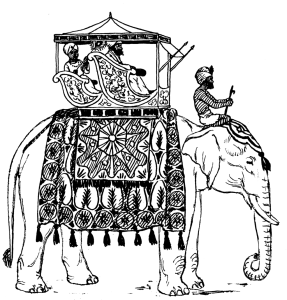
Objective view?
A closer analysis to that question - when ALL the available information is assessed would be FOUND WITHIN LANDSCAPE SYMBOLISM i.e., N/E {Orkney} in relation to S/W {Glastonbury Tor ,i.e., ''tower'' and ''Arthur'' link} together with S/E {Hunstanton and Sea-henge} and N/W {'islands', i.e.,as above and/or Iona, i.e., something 'created' in relation to an 'end' result}. All enlarged throughout. Together with 'transcendent third' symbolism i.e., what ever in neolithic times represented a ''whole'' - those stone balls would represent three quarters of that whole number. That final link to 'four''. All enlarged throughout.
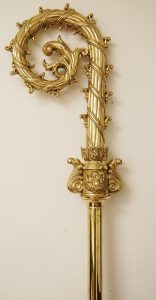
'Knot' to enlarge.
Side note. The chalk balls that were found in pits opposite Woodhenge {Bulford} - does its weight {volume?} = one third of those stone balls. 'Chalk' in relation to 'Stone'. South in relation to north?
And/or: ''Near Bulford can be seen a chalk figure of a New Zealand bird - the Kiwi.'' ['The Chase'].
''The Bulford KiwiCoordinates: 51°11′38.84″N 1°42′54.20″W is a large depiction of a kiwi, carved in the chalk on Beacon Hill above the military town of Bulford on Salisbury Plain in Wiltshire, England. It was created in 1919 by soldiers of the New Zealand Expeditionary Force who were awaiting repatriation following the end of First World War.''
"In fact, the nickname is affectionate and being called a Kiwi is a point of pride for most New Zealanders. The nickname 'Kiwi' comes from the small flightless bird native to New Zealand.
Egyptian Ostrich?
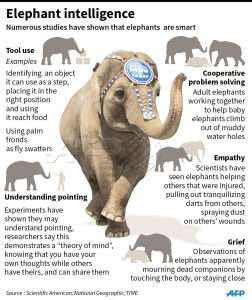
Which one likes dappled sunlight - Asian or African?
"If you travel to Aotearoa, you must be careful when using the word kiwi, since there they use it with three different meanings. A dry kiwi is a person who was born in New Zealand, a kiwi bird is a bird that is also used as a national symbol and, of course, there is the kiwi fruit to refer to the delicious fruit!"
''The silver fern is both native to, and a national symbol of New Zealand.'' ['Tipping Point'].
''What are ferns? Ferns are an ancient type of plant, dating back more than 360 million years. They don't produce flowers or seeds, but spores instead. They are prized for their attractive leaves, or fronds, which typically unfurl from crosiers (tightly coiled buds) in the centre of the plant....Ferns are a natural inhabitant of shady areas, most commonly found where they will get at least some sun during part of the day or where they will receive dappled sunlight most of the day. In fact most ferns will not grow that well in real dense shade, they need a bit of sun to grow their best....Some species of Ferns release spores that can cause poisoning through oral ingestion. The spores can contain toxins which endanger the health of humans and animals. The severity of the toxic effect depends on the type. The ill effects in people can range from nausea to cardiac issues.''
Bacteria?
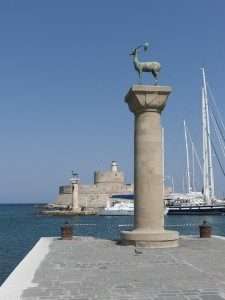
Stag and deer.
 Side note: In Greek mythology, the Ceryneian hind (Greek: Κερυνῖτις ἔλαφος Kerynitis elaphos, Latin: Elaphus Cerynitis), was a creature that lived in Ceryneia,[1] Greece and took the form of an enormous female deer, larger than a bull,[1] with golden antlers[2] like a stag,[3] hooves of bronze or brass,[4] and a "dappled hide",[5] that "excelled in swiftness of foot",[6] and snorted fire.[3] To bring it back alive to Eurystheus in Mycenae was the third labour of Heracles. Other names and descriptions for it were: doe with the golden horns,[7] golden-horned hind,[5] Ceryneia hind,[4] Cerynitian hind,[2] beast with golden antlers,[8] Parrhasian hind,[9] nimble hind of Maenalus[10] and beast of Maenalus.[11] Frazer says that the hind took its name from the river Cerynites, "which rises in Arcadia and flows through Achaia into the sea".[2]
Side note: In Greek mythology, the Ceryneian hind (Greek: Κερυνῖτις ἔλαφος Kerynitis elaphos, Latin: Elaphus Cerynitis), was a creature that lived in Ceryneia,[1] Greece and took the form of an enormous female deer, larger than a bull,[1] with golden antlers[2] like a stag,[3] hooves of bronze or brass,[4] and a "dappled hide",[5] that "excelled in swiftness of foot",[6] and snorted fire.[3] To bring it back alive to Eurystheus in Mycenae was the third labour of Heracles. Other names and descriptions for it were: doe with the golden horns,[7] golden-horned hind,[5] Ceryneia hind,[4] Cerynitian hind,[2] beast with golden antlers,[8] Parrhasian hind,[9] nimble hind of Maenalus[10] and beast of Maenalus.[11] Frazer says that the hind took its name from the river Cerynites, "which rises in Arcadia and flows through Achaia into the sea".[2]
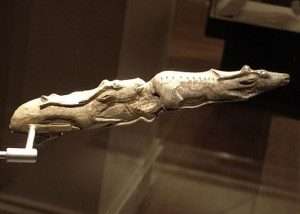 One tradition says that Artemis found a mighty herd of five Ceryneian hinds playing on the base of Parrhasian hill far away from the banks of the "black-pebbled Anaurus"[1] where they always herded. Artemis was so impressed by the hinds that she yoked four of them to her golden chariot with golden bridles, but purposely let one escape to the Ceryneian hill to be a future labour for Heracles.[1] Whilst in Ceryneia, the hind chased farmers from vineyards.
One tradition says that Artemis found a mighty herd of five Ceryneian hinds playing on the base of Parrhasian hill far away from the banks of the "black-pebbled Anaurus"[1] where they always herded. Artemis was so impressed by the hinds that she yoked four of them to her golden chariot with golden bridles, but purposely let one escape to the Ceryneian hill to be a future labour for Heracles.[1] Whilst in Ceryneia, the hind chased farmers from vineyards.

Frieze_of_Imdugud_Anzu_grasping_a_pair_of_deer_from_Tell_Al-Ubaid.
Once Heracles captured the hind, and only after explaining to Artemis and Apollo ("who would have wrested the hind from him"[2]) that he had only hurt the sacred hind out of necessity, was he allowed to take it alive to Eurystheus in Mycenae, thus completing his third labour.
Pindar says that in his quest of the hind with the golden horns Hercules had seen "the far-off land beyond the cold blast of Boreas. [Hyperborea]"[7] Hence, as the reindeer is said to be the only species of deer of which the female has antlers, Sir William Ridgeway argues ingeniously that the hind with the golden horns was no other than the reindeer."[2]
A doe bearing antlers was unknown in Greece, but the story of the hind is suggestive of reindeer, which, unlike other deer, can be harnessed and whose females bear antlers. The myth relates to the Hyperborea,[7] which may have been the archaic origin of the myth itself, as Robert Graves thought.
Side note: Rudolph the Red-Nosed Reindeer is a fictional reindeer created by Robert L. May. Rudolph is usually depicted as the ninth and youngest of Santa Claus's reindeer, using his luminous red nose to lead the reindeer team and guide Santa's sleigh on Christmas Eve. Though he initially receives ridicule for his nose as a fawn, the brightness of his nose is so powerful that it illuminates the team's path through harsh winter weather. Ronald D. Lankford, Jr., described Rudolph's story as "the fantasy story made to order for American children: each child has the need to express and receive approval for his or her individuality and/or special qualities. Rudolph's story embodies the American Dream for the child, writ large because of the cultural significance of Christmas."[3]
Rudolph first appeared in a 1939 booklet written by May and published by Montgomery Ward, the department store.[4][5][6]

'Spotted' dog?

Keresh (Hebrew קֶרֶשׁ) is a Talmudic unicorn living in the forest of Bei Ila'ei. It is similar to a deer, but the length of its body is said to be sixteen cubits (8.6 m / 28.3 ft).
Continued: 'Dappled' in relation to: " Time of night and stellar magnitude. Most of the star calendars of ancient Arabia work by observing stars as they rise or set shortly before the sun rises. (My apologies to the night owls among us!) The star(s) should be almost touching the horizon (within 5-10 angular degrees or so) to be in the proper position. Historically, the rain stars (anwa’ ) and the lunar stations were typically observed at a time of night called ghalas, when the darkness of the night mixes with the light of dawn in the tracts of the horizon. You will find that the period of ghalas occurs between 75 and 45 minutes before sunrise, depending upon your observing latitude. (Note that the time of sunrise will change throughout the year as we progress from fall to winter, spring and summer. Your local times of sunrise throughout the year can be found on a website like timeanddate.com.) The proper mixture of night and dawning light in which the brighter stars are still visible represents a precise period of the night, but not an exact time. Minutes were not in use prior to the European Middle Ages, so don’t get caught up in trying to find an exact time.
In practice, the proper timing for this depends upon the brightness (magnitude) of the star and whether they are rising or setting. The brightest stars are visible just before sunrise, but the dimmer ones may require observation more than an hour before sunrise."
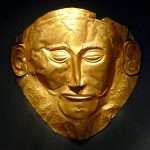

A work in pogress: ''CT scans of the mummy of a fifteen year old boy, nicknamed the Golden Boy, have revealed fortynine {'49'} hidden amulets within his wrappings. Many of the amulets are made of gold, including a golden tongue inside the mouth, a golden heart scarab inside the thoracic cavity, and a two finger amulet next to his penis. Originally discovered in Edfu....mummified to a high standard indicating high social status {'Nobles'?}. He was wrapped in good quality linen, wearing a gilded mummy mask and sandals, and covered with garlands of ferns.'' [Page 6 'Ancient Egypt' / May-June 2023].
''Spores are most conspicuous in the non-seed-bearing plants, including liverworts, hornworts, mosses, and ferns. In these lower plants, as in fungi, the spores function much like seeds. In general, the parent plant sheds the spores locally; the spore-generating organs are frequently located on the undersides of leaves.''
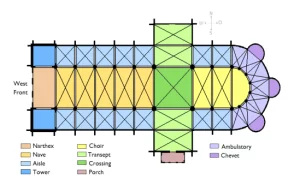

Spot the penis or should that be penises?
And/or: ''While digging beneath the transept of Paris' Notre Dame Cathedral - two lead sarcophagi found.The first was sealed in a masonry tomb at the threshold of the cathedral's choir....'three' bronze medals on top of the coffin. Belonged to an individual in his 'eighties' {83}. The other was found west of the transept: 'The coffins contours sharply follow the shape of the head, shoulders and hips {'spear point'?}. Belonged to an individual of around 'thirty'. Had ridden horses from an early age. He was embalmed, his thorax opened and the top of his skull cut off {'flat' / 'gap'?} - indicating high nobility.'' [Page 16 'Archaeology' / May-June 2023].
Leaves for a pillow were also found. 'Cuddy ducks' to enlarge.
''Seeds are produced by flowering plants. Spores are produced by fungi, algae, bacteria, non-flowering plants etc. Seeds are mostly present inside a fruit. Spores are found underside the leaves of ferns and mosses and gills of the fungi.''
'Queendom'.
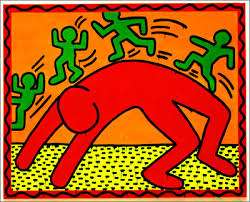
Bridge over troubled waters. Golds, reds and greens.
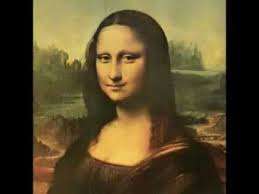
Analogy: "It was only through this regeneration of herself that {such individuals} as Irina Tweedie was able to taste the essence of True Liberation and know that the 'Path of Love is like a bridge of hair across a Chasm of Fire'." Spirit and Soul - which and why? Any bridges or lakes? Icy peaks, therefore north aspect?
Something to ponder on: "The last meals of Tollund and Grauballe man had both consumed a coarse and inedible cereal full of flower seeds, and this implies that they MAY have been sacrifices made by a community on the edge of desperate famine. The grain in Lindow Man's pancake bore little resemblance to theirs, for it contained fewer contaminants and was finely ground and of high quality. It gave no evidence of famine. Careful examination of the gut contents did reveal, though, that very small quantities of charred heather leaves and UNcharred leaves and shoots of sphagnum moss were mixed in with the grain. Either the heather had slipped into the last meal accidentally, through its use as a FUEL, or it had been introduced deliberately as part of the ceremony....
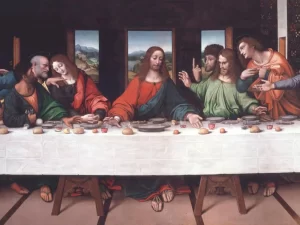
V shape? Window piIlar between. Lake either side. 'Finger' directions = west-east?
Likewise, it was improbable that the sphagnum moss was a chance contaminant - the garrote was so tightly bound that nothing could have worked its way down his gullet once tightened. It must therefore have been consumed well before death as part of a carefully orchestrated and supervised ritual.....
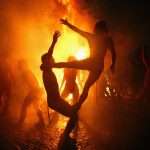
'Triangle'? Tomb or womb?
The most puzzling contaminants of the 'last meal' were a number of fine animal hairs mixed in with the grain...."
Goat, horse or sheep hairs?
Fornax to enlarge.
"Seventyfive per cent of the worlds heather moorland is in the UK. Sixty per cent of that 75% is in Yorkshire." ['Yorkshire Great and Small: Bronte Country'/ CH5].
Side note: Alice Roberts investigates a bog body found in {Ireland?} whose stomach contents contained a type of 'bitter plum'. Enlarged elsewhere.
'Bitter / belly / leavened / N/W / pure / wheat / barley etc.
Refresher: ''All cereal nature means wheat, all treasure nature means gold, all generation means man,'' says the medieval sage Meister Eckhart. And if one looks at this from a psychological standpoint, it is certainly so. The whole inner psychic reality of each individual is ultimately orientated toward this archetype symbol of the Self." ['Man and his Symbols' / C. Jung].
What colours would represent each?
''Orchestrated'' in relation to:
"In Greek mythology, Orpheus (/ˈɔːrfiːəs, ˈɔːrfjuːs/; Ancient Greek: Ὀρφεύς, classical pronunciation: [or.pʰeú̯s]) was a Thracian bard, legendary musician and prophet. He was also a renowned poet and, according to the legend, travelled with Jason and the Argonauts in search of the Golden Fleece, and even descended into the underworld of Hades, to recover his lost wife Eurydice.[1]
Ancient Greek authors such as Strabo and Plutarch note Orpheus's Thracian origins. The major stories about him are centered on his ability to charm all living things and even stones with his music (the usual scene in Orpheus mosaics), his attempt to retrieve his wife Eurydice from the underworld, and his death at the hands of the maenads of Dionysus, who got tired of his mourning for his late wife Eurydice."
'Pan pipes' to enlarge. 'Twentyseven'?
Side note. Etymology of Iona = 'Yew' and/or 'Bear' and 'fox' i.e., Nordic = ''Den of brown bear'' and/or ''Den of fox'' And/or Gaelic ''Isle of beautiful woman'' [Wiki/Iona].
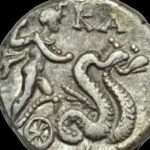
Khufu also identified with ''two snakes''. Enlarged elsewhere.
Side step: The Yew-wood head of queen Tiy - wife of Amenhotep 3rd {with two snakes on forehead}. [Page 33 'Hathor Rising' / A. Roberts].
''The Yew tree is in the village churchyard at Fortingall in Perthshire that is thought to be 3000 years old.'' ['The Chase'].
''Visitors to the old yew tree can also visit Fortingall Church and stroll down the main street of this picturesque. Look out for the single, time worn cairn in the field opposite the village, known as Cairn of the Dead.''
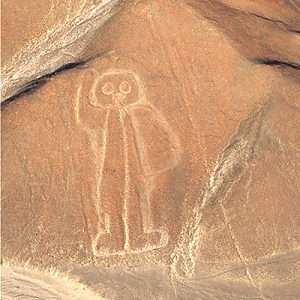
Slope?
''Fortingall is a small village in highland Perthshire, Scotland, in Glen Lyon. Its nearest sizable neighbours are Aberfeldy and Kenmore. Its Gaelic name is Fartairchill, which may be translated as something like: "Escarpment Church", i.e. "church at the foot of an escarpment or steep slope. Local legend claims that it was the birthplace of Pontius Pilate, although he was born well before the Roman conquest and became famous in the biblical account of Jesus's death 30 years before the Romans first reached this part of Scotland....It is the main focus for the villages Samhain festival. Other sites include the Fortingall stone circle, standing stones including the Bridge of Lyon, "
'Overhang'?
Side note: "Pontius Pilate[b] (Latin: Pontius Pilatus; Greek: Πόντιος Πιλᾶτος, Pontios Pilatos) was the fifth governor of the Roman province of Judaea, serving under Emperor Tiberius from 26/27 to 36/37 AD. He is best known for being the official who presided over the trial of Jesus and ultimately ordered his crucifixion. Pilate's importance in Christianity is underscored by his prominent place in both the Apostles' and Nicene Creeds. Because the gospels portray Pilate as reluctant to execute Jesus, the Ethiopian Church believes that Pilate became a Christian and venerates him as both a martyr and a saint, a belief which is historically shared by the Coptic Church,[7] with a feast day on 19 or 25 June, respectively."
'Nineteen' and 'twentyfive'?
Continued: ''The tree is sacred to the Greek goddess Hecate, said to be the liberator of souls after death. Her yew tree is believed to root into the mouths of the dead in order to remove the soul.''
'Teeth' substitute?

Flacid or erect? 'Place of Rowing'?
Roos Carr in East Yorkshire is home to a group of five wooden figures and what appears to be a boat, known collectively as the Roos Carr figures. A chance discovery by workers digging a ditch in 1836, these curious creations are carved from Yew, stand 35-41cm tall, have stone eyes and come with detachable accessories; paddles, shields and genitalia. Radio carbon dating has determined these guys come from the Late Bronze Age, or Early Iron Age. But what on earth were they for? Perhaps a votive offering or even depictions of gods or important community members?
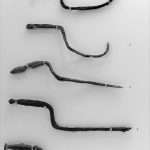
Straight lines and curves. 90/180?
And/or: ''The 5th tree is the yew, the death-tree in all European countries, sacred to Hecate in Greece and Italy. ....Like the Oak it takes time to mature - even more so. '' Other links = 'Tin/lead' + ''coffin of the vine'' + 'bow and poison arrows' + 'poisonous shade'? + ''horses and cattle nibble the leaves without ill effect''+ 'Moon's eclipse' link + 'yews juice {poison?} into ear' + 'eve of winter solstice, last day of year' + goat/'kids' and ''horned Dionysus'' links etc. [Page 189-192 'The White Goddess' / R. Graves].
'Cairns' to enlarge.
Scorpion?

'Tomb' or gateway?
 The fifth tree is the yew, the death-tree in all European countries, sacred to Hecate in Greece and Italy. At Rome, when black bulls were sacrificed to Hecate, so that the ghosts should lap their gushing blood, they were wreathed with yew. The yew is mentioned by Pausanias as the tree beside which Epaminondas found the bronze urn on Mount Ithome, containing on a tin scroll the secret mysteries of the Great Goddess. On the other side of the urn, appropriately, grew a myrtle, which (as will appear in Chapter Thirteen) was the Greek equivalent of the elder, the deathconsonant R. That the scroll was made of tin is interesting; for the ancient Greeks imported their tin from Spain and Britain. In Ireland the yew was 'the coffin of the vine': wine barrels were made of yew staves. In the Irish romance of Naoise and Deirdre, yew stakes were driven through the corpses of these lovers to keep them apart; but the stakes sprouted and became trees whose tops eventually embraced over Armagh Cathedral.
The fifth tree is the yew, the death-tree in all European countries, sacred to Hecate in Greece and Italy. At Rome, when black bulls were sacrificed to Hecate, so that the ghosts should lap their gushing blood, they were wreathed with yew. The yew is mentioned by Pausanias as the tree beside which Epaminondas found the bronze urn on Mount Ithome, containing on a tin scroll the secret mysteries of the Great Goddess. On the other side of the urn, appropriately, grew a myrtle, which (as will appear in Chapter Thirteen) was the Greek equivalent of the elder, the deathconsonant R. That the scroll was made of tin is interesting; for the ancient Greeks imported their tin from Spain and Britain. In Ireland the yew was 'the coffin of the vine': wine barrels were made of yew staves. In the Irish romance of Naoise and Deirdre, yew stakes were driven through the corpses of these lovers to keep them apart; but the stakes sprouted and became trees whose tops eventually embraced over Armagh Cathedral.

Goddess of crossroads. Mad, bad or just sad?
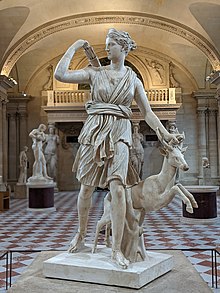
Lozenge floor?
In Brittany it is said that church-yard yews will spread a root to the mouth of each corpse. Yew makes the best bows—as the Romans learned from the Greeks—and the deadliness of the tree was thereby enhanced; it is likely that the Latin taxus, yew, is connected with toxon, Greek for bow, and with toxicon, Greek for the poison with which arrows were smeared. The ancient Irish are said to have used a compound of yew-berry, helle bore and devil's bit for poisoning their weapons. John Evelyn in his Silva (1662) points out that the yew does not deserve its reputation for poisonousness—'whatever Pliny reports concerning its shade, or the story of the air about Thasius, the fate of Cativulcus mentioned by Caesar, and the ill report which the fruit has vulgarly obtained in France, Spain and Arcadia.' Cattle and horses nibble the leaves without ill-effect, he says; but later he suggests that the 'true taxus' is indeed 'mortiferous*. Its use in the English witch-cult is recalled in Macbeth where Hecate's cauldron contained:
• ... slips of yew
Sliver'd in the Moon's eclipse.
Shakespeare elsewhere calls it the 'double fatal yew' and makes Hamlet's uncle poison the King by pouring its juice ('hebenon') into his ear. ['The White Goddess'].
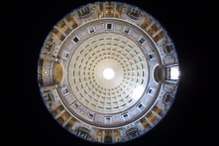
Oculus = ''Eye''?
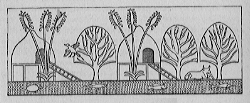 A working example: ''The Pavilion of Unas is woven with Reeds...The water of Unas is wine, like that of Re....The abomination of Unas is hunger. He does not eat it. The abomination of Unas is thirst. He does not eat it. Unas it is indeed....His Nurse is the Milk goddess. It is She who makes Him live again. She gives him birth. Unas is conceived at night. He is born at night. For he belongs to the Followers of Re, who are before the Morning Star. He is conceived and born in the Watery Abyss. He has come. He has brought your Bread which he has found there. The Eye of Horus trickles on the bush of the Yew Plant. Khentiamenti comes to him indeed. He has brought him the 'food' of Horus, who is at the Head of his Houses.'' [Page 34 'The Pyramid Texts' / W. Budge].
A working example: ''The Pavilion of Unas is woven with Reeds...The water of Unas is wine, like that of Re....The abomination of Unas is hunger. He does not eat it. The abomination of Unas is thirst. He does not eat it. Unas it is indeed....His Nurse is the Milk goddess. It is She who makes Him live again. She gives him birth. Unas is conceived at night. He is born at night. For he belongs to the Followers of Re, who are before the Morning Star. He is conceived and born in the Watery Abyss. He has come. He has brought your Bread which he has found there. The Eye of Horus trickles on the bush of the Yew Plant. Khentiamenti comes to him indeed. He has brought him the 'food' of Horus, who is at the Head of his Houses.'' [Page 34 'The Pyramid Texts' / W. Budge].
Venus or Sirius?
''Khenti-Amentiu, also Khentiamenti, Khenti-Amenti, Kenti-Amentiu and many other spellings, is an ancient Egyptian deity whose name was also used as a title for Osiris and Anubis. The name means "Foremost of the Westerners" or "Chief of the Westerners", where "Westerners" refers to the dead.[1]
Khenti-Amentiu was depicted as a jackal-headed deity at Abydos in Upper Egypt, who stood guard over the city of the dead. Khenti-Amentiu is attested early at Abydos, perhaps even earlier than the unification of Egypt at the start of the Early Dynastic Period (c. 3100–2686 BC).'' [Wiki].
And/or: ''Yew-tree, yew-tree, true to your kind. In church yards you are found.'' [Page 444 'The White Goddess' / R. Graves].
Continued: ''The bear is one of a few animals that dares to venture deep in the cold North''. Snow fox?
Question. What do those animals represent? If only within a mind set i.e., Male or female 'bear'?
A change of pace...For a real head scratcher of the same try...’The Feminine in Fairy Tales’. Chapter seven. By M.Von.Franz . Don-t read it in the dark. Keep the light on. Remember this subject only uses that familiar one as a representation of something else...but those archetypes could be ‘real’ if there is any substance to this ‘acclaimed’ framework. Both positive/negative. Unconscious and/or otherwise. Depending on the individual.
'The Rose Cross and the Goddess' by G. Knight. And/or 'Red Tree, White Tree: Faeries and Human's in Partnership' / W. Berg.
The ancient Egyptians symbolized the conscience [ higher ] aspect of...spark/Origin by identifying it with a birth. Only women can give birth therefore only women can be chosen. Only mentioned because of its link to the word ’divine’.[ Explained below ].
The unconscious [ lower ] aspect = The scarab beetle.

'Birds' in a southern constellation.
Side note: " The Egyptian Bennu is a bird. In the age of the pyramids it was represented as a yellow wagtail, but it later came very much like a heron with red legs, and two long feathers growing from its head {recall the kingfisher and its link to Motmot. Enlarged elsewhere}. Its name comes from the verb 'to shine' or to 'rise brilliantly'. A papyrus of the 21st dynasty says of the Bennu that it is 'the one who came into being by itself'. It symbolizes the anticipated rebirth of the soul in the Underworld and was carved onto the backs {embossed?} of scarab amulets buried with mummified bodies. This ensures that the heart does not fail the test of the deceased's past deeds in the Judgement hall of the Two Truths. It is also a symbol of the sun god Ra, celebrating the sun's rebirth each dawn. According to legend, the Bennu arises from a burning tree {bush?}, singing such a melodious song that the god's are transported by its sound. Its legend informs the legend of the Phoenix, as related by Herodotus who visited Egypt in the 5th century BC. He wrote of the sacred bird of Heliopolis {N/E?} which, every 500 years, carries its dead predecessor from Arabia to the sun god's temple..." ['The Element Encyclopedia of Magical Creatures' / J. and C. Matthews]. Question. Why Arabia?
Side note: ''The name Aztec is derived from Aztlán (variously translated as “White Land,” “Land of White Herons,” or “Place of Herons”), an allusion to their origins, probably in northwestern Mexico.'' [Wiki].
And/or: The ancestral home of the Aztecs was known not only as the 'place of the heron' but also the 'place of the reeds' ....'' [Page 232 'The Orion Zone: Ancient Star Cities of the American S/W'].
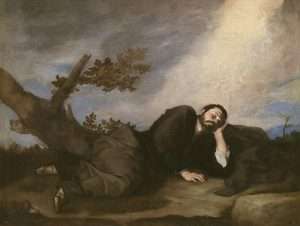
'Stump'?
''American Chicano political activists and poorly informed historians like to mention a place called Aztlan as the primordial founding city of the Toltecs and Aztatecas. But there never was an Aztlan in Nahuatl mythology. It was called Aztatlan. On Mexico's West coast, there is an Aztatlan, Nayarit. The Sanskrit word Asta means 'Place of the Setting Sun' or Westernmost Extreme or Boundary'. Could Aztatlan be the westernmost boundary of what was once Atlantis? Additionally, the Aztec's were never Aztecas, but Aztatecas. Again, Asta means 'Westernmost Extreme Boundary'. Aztateca = 'Westerner.'
''Foremost of the Westerners''?
''One hundred and fiftythree''? {153}.
Glastonbury?


Sawn palm stem: Palms do not form annual tree rings.
Continued: ''The heron = the Egyptian Bennu bird, or phoenix. More specifically, the hieroglyph for bennu means both 'purple heron and 'palm tree'....It is an Egyptian symbol of morning and the generation of life...One of the denotations for the word ''phoenix'' is 'purple red' and the Phoenicians were known as ''red men''...The Hohokam territory is one of the candidates for Palatkwapi, the legendary Hopi 'Red City of the South'....''
Elephantine? {i.e., red granite}.
And/or: A working example: ''We came to a large empty flat over a municipal school, evidently belonging to teachers of this school. I think it was in the place of the former Red Pond.'' ['In Search of the Miraculous' / P. D. Ouspensky].
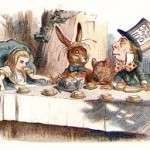

'Spirit' or 'Soul'?
''Homolovi was one of the last stops on the long migration of the Anasazi/Hisatsmom toward their ultimate goal of Sichtilkwi, or Flower Mound, at the Center-place {specifically, near Walpi}. The people who had traveled from Palatkwapi in order to settle along the Little Colorado River include the Water Clan, the Sand Clan, the Sun Clan, the Tobacco Clan, the Rabbit Clan and a few others. Palatkwapi, the mystical red city located perhaps as far south as Mexico, was destroyed by a great flood...'' [Pages 261/83 'The Orion Zone' / G. A. David].
Side note: I once received an interesting inquiry from a woman who wanted to know the meaning of the terms "morning stars" and "evening stars." She wrote: "I mean, they're not stars … they're planets, right? So why do we call them stars? And is a 'morning star' only visible in the morning, like at the crack of dawn, or at other times as well? Hope you can clear this up for me because I'm totally confused!"
Here is an explanation for what qualifies as a "morning star" and an "evening star."

Crack?
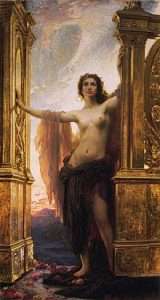
Goddess of Dawn. Gateway to the light.
Originally, the terms "morning star" and "evening star" applied only to the brightest planet of all, Venus. It is far more dazzling than any of the actual stars in the sky and does not appear to twinkle. Instead, it glows with a steady, silvery light. The fact that Venus was a wandering star soon became obvious to ancient skywatchers, who noticed its shifting back and forth from the early hours of the eastern morning sky to the western sky in the early evening. Nicolas Camille Flammarion, a noted French astronomer in the late 19th and early 20th century, referred to Venus as "The Shepherd's Star." I myself like to refer to Venus as the "night light of the sky." So, one can readily understand the origin of the terms evening and "morning star" if we only considered Venus....

Apollo: Curl or knot?
With Mercury and Venus, however, there is never such ambiguity, since they are never very far from the sun in the sky. Because they orbit the sun more closely than Earth, Mercury and Venus are called "inferior" planets. In fact, in the pre-Christian era, both of these planets had dual identities — two names — as initially it was not realized they alternately appeared on one side of the sun and then the other. Mercury was called "Apollo" when it shone in the mornings and "Hermes" when it appeared in the evening sky; Venus was "Phosphorus" in the morning and "Hesperus" in the evening. We can thank Pythagoras around the 5th century B.C. for pointing out that the latter two objects were really one in the same.
So, in general, when either of these planets has a western elongation from the sun it is a "morning star"; with an eastern elongation it is an "evening star." When they are aligned more-or-less with the sun as seen from our Earthly perspective, they will make the transition from evening to morning or vice versa:
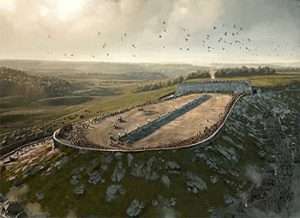
Alte Burg. Described as an oval shape 'hippodrome'. The first of its kind.
When Mercury or Venus is passing between the sun and Earth, we say they are at inferior conjunction and go from being categorized as "evening stars" to transitioning to "morning stars." When the alignment is such that they appear roughly on a line beyond the far side of the sun as seen from Earth, we then say that they are in superior conjunction; that is when they make the switch from being considered "morning stars" to "evening stars."
A CELESTIAL RACETRACK
REFRESHER: A working example: ''We came to a large empty flat over a municipal school, evidently belonging to teachers of this school. I think it was in the place of the former Red Pond.'' ['In Search of the Miraculous' / P. D. Ouspensky].
''Homolovi was one of the last stops on the long migration of the Anasazi/Hisatsmom toward their ultimate goal of Sichtilkwi, or Flower Mound, at the Center-place {specifically, near Walpi}. The people who had traveled from Palatkwapi in order to settle along the Little Colorado River include the Water Clan, the Sand Clan, the Sun Clan, the Tobacco Clan, the Rabbit Clan and a few others. Palatkwapi, the mystical red city located perhaps as far south as Mexico, was destroyed by a great flood...'' [Pages 261/83 'The Orion Zone' / G. A. David]. 

Which is N/W?
And/or: ''During these closing hours, when the sun boat sails towards Nut's protective arms in the Northwest, towards her 'beautiful face' floating in the waters of Nun, nothing but the prospect of old age might seem to loom. Yet this time is particularly radiant, a deep illumination beginning in the tenth hour called 'She who illuminates the heavenly water, who cools the steering OAR,' and rising for the god Heka {'magic'}. According to the tenth hour hymn, this is when Re enters the night boat for crossing into the West, and curiously, immediately after the departure from the Field of Reeds, three torchbearers, shown in the register above the boat, light the way, including a figure named 'He Who Makes Redness', the colour associated with North and its fiery tutelary deity, the serpent goddess Wadjet. As the boat sets sail upon the western waters, everything now shines in the redness he creates.'' [Page 30 ' Hathors Alchemy' / Alison Roberts].
'Place of Rowing'?
Null / Zero / Emptiness?
Continued: "The reason is that each religion or philosophy that comes into the world is a Benjamin of humanity and insures its own life by 'destroying' its mother. It is because the symbolic serpent turns ever devouring its own tail; it is because, an essential condition of existence, a void, is necessary to every plenitude, space for every dimension, an affirmation for each negation: herein is the eternal realization of the phoenix allegory." ['Transcendental Magic' by E. Levi].
'Waters of the Gap' ?

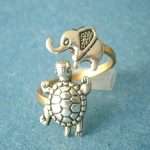 A work in progress: ''The ancient Egyptians called the 'Chapter of Becoming a Divine Hawk', one of the most important - that appeared in the Book of the Dead. It describes the Egyptians idea of the effects of the soul's release after death: Thou shalt change into a living ba...and thou shalt take shape as a heron or swallow, as a falcon or a bittern, whichever thou pleaseth. Thou shall cross in the ferryboat and shall not turn back, thou shalt sail on the waters of the flood, and start afresh.....''
A work in progress: ''The ancient Egyptians called the 'Chapter of Becoming a Divine Hawk', one of the most important - that appeared in the Book of the Dead. It describes the Egyptians idea of the effects of the soul's release after death: Thou shalt change into a living ba...and thou shalt take shape as a heron or swallow, as a falcon or a bittern, whichever thou pleaseth. Thou shall cross in the ferryboat and shall not turn back, thou shalt sail on the waters of the flood, and start afresh.....''
And/or: ''Traditionally, sailors would get the tattoo of a swallow after travelling 5000 nautical miles.'' ['The Chase' / ITV / 2018].
And/or: ''Known for its distinctive booming call, the Bittern is Britains loudest bird.'' [Same].
''Ancient spiritual traditions link the khu with the crown chakra, or pineal gland located at the tip of the brain....it was said to preexist the creation of the world and to be, simultaneously, the final goal of transformed matter {'crocodile'?}.....The khu is depicted as the crested ibis standing before a star- a spark of genius or shining brilliance and/or the divine spark. Represented with its dark green iridescent plumage {drake duck head?}....that seemed to glitter with metallic sparks.''

 And/or: ''One afternoon as i was working with the text of 'Becoming a Bennu bird' {a phoenix}, i decided to abandon {'decommissioned'?} the text and take a walk. As i strolled along Boulder Greek {grey'?}, my head was filled with the text, and i said to myself, 'What i need is a sign, a single image to sustain me for the day'. The late afternoon sun was streaming {'zenith'?} through the canopy of willows and overhead sycamores {'dappling'?}....Then in a moment i saw HIM, no more than a few feet away - my first blue heron....He held himself on one leg balanced on a rock.....With wings spread wide he disappeared into the dimming light of the setting sun at the rim of the mountains. I went home and wrote about the bennu. I did not have to think very hard about it. To the ancient Egyptians the bennu or phoenix, was the messenger of god. It was the herald of all worlds, the source of all life and 'divine' possibility.'' [Pages 242-5 'Dreams of Isis'].
And/or: ''One afternoon as i was working with the text of 'Becoming a Bennu bird' {a phoenix}, i decided to abandon {'decommissioned'?} the text and take a walk. As i strolled along Boulder Greek {grey'?}, my head was filled with the text, and i said to myself, 'What i need is a sign, a single image to sustain me for the day'. The late afternoon sun was streaming {'zenith'?} through the canopy of willows and overhead sycamores {'dappling'?}....Then in a moment i saw HIM, no more than a few feet away - my first blue heron....He held himself on one leg balanced on a rock.....With wings spread wide he disappeared into the dimming light of the setting sun at the rim of the mountains. I went home and wrote about the bennu. I did not have to think very hard about it. To the ancient Egyptians the bennu or phoenix, was the messenger of god. It was the herald of all worlds, the source of all life and 'divine' possibility.'' [Pages 242-5 'Dreams of Isis'].
Elephant Island?

East or west? Tower shape? Recall 'Tower' at Glastonbury. Twice as high as broad? Other clews elsewhere.
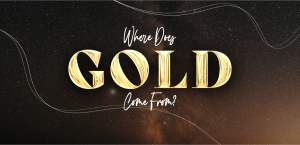
''In the ancient Egyptian pantheon of colours yellow has been considered a substitute for gold, the material associated with the sun and the eternal skin of the gods....The discovery of orpiment and realgar on multiple types of objects continued with archaeological finds from the Amarna period through to the Ptolemaic Period. Usually occuring together, orpiment and realgar crystals would have to be seperated to create the pigments of golden yellow and red/red-orange. Both are toxic arsenic sulphides that must be handled carefully to prevent poisoning. Orpiment found on a hes vase on a coffin in the HARE Nome and found on a kilt of a wooden 'guardian' figure - found in the non royal tomb of Imhotep, a 'Royal Sealer'....In this case it was NOT used to portray the golden skin, but to accent the clothing {'leak' to enlarge}....At Amarna, an outstanding example of Orpiment is found on the bright yellow headband on the famous bust of Nefertiti. The use of realgar is found on fewer objects. Found on the walls {'vertical'?} within the royal tomb of Amenhotep III. Found primary in the Book of the Dead papyri. And both used in same for colouring of the STRIPED borders.'' [Pages 39-43 'Ancient Egypt' / September-October 2023].
And/or: "Another very important teaching in reference to the Duat or 'Beautiful West' comes from the following hymn to Amun-Re. It instructs us that those who are not righteous will not attain the coveted goal.....instead they will be directed towards the east....this is a reference to reincarnation. The ''east'' implies the dawn and a new life for the sun in the form of Khepri represented as the rebirth of the soul...into a new body....over millions of years....until it can 'discover' and return to its original source....The Egyptians were the first to understand and teach reincarnation. Therefore in order to reach the WEST one has to be ''pure of heart''...." [Page 123 'Egyptian Book of the Dead: The Book of Coming Forth by Day' / M. Ashby].
''Foremost of the Westerners''?
Side note: The Book of Kells: once described as the largest book in the world. Unfinished. A 'weighty' book. 150 calf skins {Vellum}: ''Yellow is the most interesting colour - is made from yellow orpiment.'' ['How the Celts Saved Britain' / BBC4].
Question. What would the antidote be for a poison?
The wisdom found within it?
Although the vast majority of coins are round, coins are made in a variety of other shapes, including squares, rectangular, {triangular?}, diamonds, hexagons, heptagons, octagons, decagons, and dodecagons. They have also been struck with scalloped (wavy) edges, and with holes in the middle. Coins in the shape of polygons often have rounded edges or are Reuleaux polygons.

Similar shaped 'coin' found on Plot seven {i.e., west of plot eight}- Oak Island. Arsenic content - which predates it to the 16th century. ['Curse of Oak Island' / S10 EP1].
 This article focuses mainly on circulating coins; a number of non-circulating commemorative coins have been made in special shapes, including guitars, pyramids, and maps.[1] There is a list with more unusual shapes of non-circulating commemorative coins at the end of this page, that all have been issued officially by various countries....
This article focuses mainly on circulating coins; a number of non-circulating commemorative coins have been made in special shapes, including guitars, pyramids, and maps.[1] There is a list with more unusual shapes of non-circulating commemorative coins at the end of this page, that all have been issued officially by various countries....
Many countries have struck square coins with rounded corners. Some of these, such as the Netherlands zinc 5 cent coin of World War II (1941–1943)[4] and the Bangladesh 5 poisha coin (1977–1994)[5] are oriented as a square, while others, such as the Netherlands 5 cents (1913–1940),[6] the Netherlands Antilles 50 cent, the Bangladesh 5 poisha (1973–1974)[7] and the 1981 Jersey 1 pound coin,[8] are oriented as a diamond. Ceylon (the current Sri Lanka) issued its first square coin in 1909, followed by several others.[9] India has had various circulating square coins as well, like denominated 1/2 and 2 anna coins,[10] as well as 1 and 5 paisa coins.[11]
Siege money, such as Klippe coins or the siege money of Newark, was often in the shape of a lozenge (rhombus).
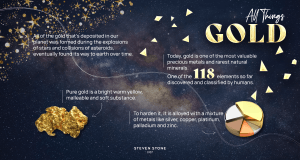 Continued: Try ''Mr Jones'', ''Miss Smith'' for a {simplified?} description {'teaching'?}. Then relate it to the word ''spotless''. One of those universal keys/archetypes/correspondences etc., etc. Call them what you will.
Continued: Try ''Mr Jones'', ''Miss Smith'' for a {simplified?} description {'teaching'?}. Then relate it to the word ''spotless''. One of those universal keys/archetypes/correspondences etc., etc. Call them what you will.
''Do not travel on those western waterways. Those who travel thereon do not come {towards Ra}. Walk, O thou Pepi Nefer-ka-Re, upon these eastern waterways among the followers of Ra of the sublime arm {right one?], who is in the east.'.....These words open the door to the Royal path, also called the direct way.'' [Page 218/9 'Sacred Science' / R. A. Schwaller de Lubicz].
And/or: 5:4
'The way of the WILL' ? {i.e., reader}.
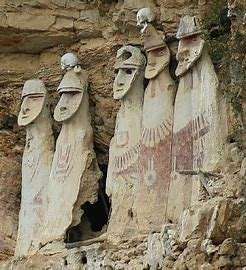 "Frankincense trees are native only to Southern Arabia and Northern Somaliland and incense was imported to Israel...In addition to the holocaust and meal-offering, the Israelite regular sacrifice included the burning of incense on a special incense altar...The name of the shrine {YHW} was ''Altar house''...Contained stone pillars, five gateways of carved stone with their doors ''standing'' and attached by bronze hinges, a ''cedarwood'' roof and woodwork...With what justification, then, did the Jews at Elephantine erect their temple? " [Page 110-116. 'Archives from Elephantine'].
"Frankincense trees are native only to Southern Arabia and Northern Somaliland and incense was imported to Israel...In addition to the holocaust and meal-offering, the Israelite regular sacrifice included the burning of incense on a special incense altar...The name of the shrine {YHW} was ''Altar house''...Contained stone pillars, five gateways of carved stone with their doors ''standing'' and attached by bronze hinges, a ''cedarwood'' roof and woodwork...With what justification, then, did the Jews at Elephantine erect their temple? " [Page 110-116. 'Archives from Elephantine'].
''Whose height is like that of cedar trees.'' {Amos ii.9}.
A working example: ''He was taken up into heaven on the clouds....and has already been said: 'he was guided by a cloud by day and fire by night'....incense used to represent it....sweet smelling....'' [Kathleen Nichols / Magdala / Israel].
Cloud People?
"For as the heavens are higher than the earth, so are my 'ways' higher than your ways." {Isa.Iv.8-9}.
'Twice as high as it is broad' ?
Side Step: "The victories of Horus through struggles, is signified by the unique triple crown he wears. A composite of the white / red crown of Upper/Lower Egypt...It also carries the golden twin plumes of the bennu bird which represents a balance {Maat}..." [Page 101 from the book by R. Clark]. Coincidence?
'A feather in the cap' {or crown?}.

P45? The parson's daughter uses the word ''king-ship'' when visiting the White House. Question. A 'member' of something? Question 2. How can one person ratify anything? Is it not supposed to be a collective {cabinet?} EFFORT? Democracy or dictator-ship?
''Five is a number peculiar to the pharaonic role. The royal person acquired a total of five names, and five crowns, each of which represented a vital function of kingship in maintaining order, unity, and continuity between physical/spiritual worlds. Pharaonic monuments consistently depict five niches or chambers ....that accommodated these five fold functions." [Page 70, from the book by R. Clark].
Quintessence?
Side note: Only five 'silver' artifacts found with Tutankhamun. Coincidence or a meaningful one?
Side note: The "wonderful things" that Carter saw encompassed the greatest collection of Egyptian antiquities ever discovered. But this was only the tip of the iceberg. Beyond this antechamber lay another, smaller, room filled with equally magnificent treasures. It took the archaeological team 2 1/2 months to carefully clear and catalogue the items in these two rooms. Finally, Carter was ready to break through a fourth sealed door into what he believed would be King Tut's tomb - the holy of holies where the pharaoh would be found in his golden casket. On February 16, 1923 Carter began to pick away at the sealed door:
"My first care was to locate the wooden lintel above the door: then very carefully I.....''
Question. Was it made of cedar?
''First attested in English in 1380,[citation needed] the word coffin derives from the Old French cofin, from Latin cophinus, which means basket,[5] which is the latinisation of the Greek κόφινος (kophinos), basket.[6] The earliest attested form of the word is the Mycenaean Greek ko-pi-na, written in Linear B syllabic script.[7]
The modern French form, couffin, means cradle.''
Continued: "The work begun here may take many 'lifetimes' to complete. The meaning of pain and suffering fundamentally shifts when seen as part of a larger unfolding story with no final end point, but endless transformations of consciousness...but ones innermost essence always reemerges {in the present moment}. The Phoenix always rises. Death becomes simply a measure of the degree of purification being enacted." ['Saturn and the Theoretical Foundation of an Emerging Discipline'. Parenthesis/italics this readers].
''Spotless''?
Link to incarnation / reincarnation - BUT ONCE again - in the present moment. Question. Which of those two {concepts} are represented with ''Arabia''. Question 2. Any link to Mecca and/or Medina? {i.e.,S/W}.
Continued...Amongst others...the letters to the word that became ‘ISIS’ was the preferred chose. [ Notice the double usage of two letters. Symbolic of ’ this’ domain/ ’that’ one. Even though an anglicized version of the original name, [whose sacred bird was the Goose, the Great Cackler. 'The Cygnus Mystery'].
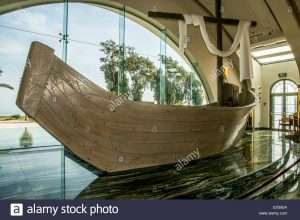
The 'harbour' spot at Magdala/Israel. Question. ''M'' for a sail?
The Christians chose ‘Mary’. The letter ‘M’ is symbolic just on its own. For similar reasons as the word 'isis’. Perfect symmetry. Left and right. This time within one letter = Both domains co-existing within one frame of reference, i.e., ’M’. As mentioned, this reader prefers the word ‘Domain’. Its a neutral word...It helps with the objective clause. Try it. Related words are...afterlife / worlds / dimensions. All three have in some way or form specific meanings. Especially the ‘afterlife’ one. A direct link to that other word that it is most associated with. The religious one...and all the emotional baggage it comes with; If allowed to; which could lead to mental blocks or at least counter intuitiveness 'in relation to' other subjects including this one. [ ‘Higher/lower’ link/explained elsewhere ].
 That link to the walls of Jericho, [ old testament ]...where the "Walls came falling down". Those mental blocks once the individual was made ‘aware’ of... were no longer viable. Or by the words Verily,verily. [ new testament ] A possibility now ‘verified’ through awareness, if only to that individual.
That link to the walls of Jericho, [ old testament ]...where the "Walls came falling down". Those mental blocks once the individual was made ‘aware’ of... were no longer viable. Or by the words Verily,verily. [ new testament ] A possibility now ‘verified’ through awareness, if only to that individual.
Question. ''Emotional baggage'' because of its link to the 'psyche' must therefore have its own symbol. What is it?
"Why should a Fool carry a 'weight' on the end of a straight stick? And what is in that 'heavy' bag, tied to the stick?...What is in your heavy bag Mark? ['The Zelator'].
Follow the title of the book to understand {'see'?} it in its 'lighter' context.
Podrick Payne? {Game of Thrones}.
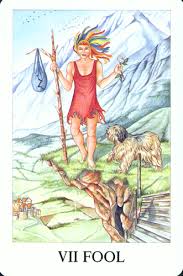
Question. Why 'seven'? Why should the letter ''Z'' be represented? Question 2. What would 'A' {Alpha?} be represented by?

Slope or overhang?
The letter chosen [M] simply because of its structure. Two vertical ‘pillars’ either side of what looks like a small ‘v’. [ the ‘Middle’ bit ] Later came to be used by the Kabbalists. [ ‘V’ sometimes used instead of ‘W’ within the Hebrew / Kabbala-Tetragrammaton. Explained elsewhere].
Chapters entitled the 'Three Ms' within the book 'Cities of Dreams: When 'Women' Ruled the World' by S. Gooch. Those three 'Ms' that the author relates to the mythology of Maidens, Mazes and the Moon. All relevant to the 'feminine' principle. Both however need to be taken into consideration for the whole picture to be seen. 'Masculine' as well as 'feminine'. 'Sun' as well as 'moon'. Anima/Animus as well as 'shadow'. Representation of. For a full understanding to take place. As does...
"{M}ary {M}agdalene: One of the female disciples of Jesus who 'discovered' his resurrection and declared it to the disciples hiding in the 'Upper' room. The loyalty and special place of Mary M. is of so an impressive a character that it has been passed into folklore - often to the extent of making her Christ's physical consort." [Page 178 'The Western Way'. Vol 2].

''M''?
"Is it a coincidence that the words Mary and moon, and also mother, all happen to begin with 'm', and that the sign for Virgo is the same letter? In many lands around the world the word for mother begins with 'm' because, it has been suggested, this is the first consonantal 'noise' which a baby makes." [Same book]. Think about it, relative to what 'virgin' and 'child' represent - all the way back to the oral tradition.
As a means....?
Question. What 'noise' would vowels make? {''silent'' ones?}. Recall those sacred 'days' at the 'end' of the year. 'Five' in total. ''Quintessence'' link?
What would it all REPRESENT?

 Refresher: "In the Ageless Wisdom there has always been the knowledge that the Life-Breath presents itself to human consciousness in a five-fold manner."
Refresher: "In the Ageless Wisdom there has always been the knowledge that the Life-Breath presents itself to human consciousness in a five-fold manner."
“Khamsa” means “five” a number which is said to guard against evil. The hand’s five fingers also allude to the Five Pillars of Islam. In Judaism, the five fingers are said to represent the five books of the Torah. The five fingers are also a reminder that one must use all five senses in praise of God."
Something extra: something that can be used to work something else out: "Aleph is the first of the three {M}other letters in the Hebrew Alphabet. It corresponds to the element 'Air'. In our opinion it corresponds also to the planet Hershel or Uranus, but we do not offer this correspondence upon any other authority than our own studies of the astrological influence of Uranus...." [Page 84 of the book by P. F. Case. Vol 1].

A refection of something?
And/or: "The 13th letter of the Hebrew Alphabet is 'Mem'. Numeric number is 40. Literally ''Sea's'', for MEM is a plural form. According to the alchemists, Water is the 'mother, seed, and root of all minerals'. It is the 'first mirror', thus it symbolizes reflected life, the reproduction of the Life-Power in the various forms and objects of self manifestation....MEM is translated 'M'. It is the second of the 'mother' letters in the alphabet." [Page 93. Same].
All as a means....?
'On Having No Head: Zen and the Rediscovery of the Obvious' / D. E. Harding.
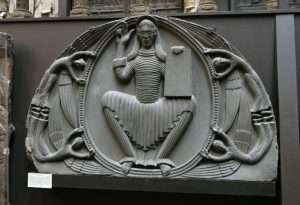
Hand gestures?
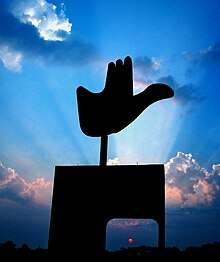
Horizon line from the S/E? Bird in flight?
Refresher: "The moon goddess played a great part in the superstitions of fishermen....She was believed to be able to bring back lost ships....'Ships' have always been associated with her....I have described a number of these sea superstitions in Boats and Boatmen, and there is no need to repeat them here. I shall, however, mention the 'oculus'. This is the eye, which is still found painted on the bows of ships all over Europe and Asia. In ancient Egypt it apparently ensured the presence and 'protection' of the sun; but this appears to have changed to the eye of Isis....With the coming of Christianity many of these 'eyes' were changed to the 'Stella Maris' of the Virgin Mary. Some, however, would maintain that the word Mary is really related to the Ma of the Great Mother and thus Magog....The Pictish crown also descended from the feminine line. Here the oculus survives strongly on the bows of boats." [Pages 123/126 'GogMagog'].
Superstition only?

The ''beginning'' of something? As a means...? Ear shape? therefore 'sound'' link?

Flag of Brazil. 'Twentysix' stars above the equator. The solitary one = Spica - below. 'Twentyseven' in total. 'nineteen{th}' of November 1889 = Independence Day.
As is: {working exercise?}: "In the early images of the constellation Virgo we find the predominant fixed star Spica, which is now known to be a binary. Spica was the 'Ear of Corn' in the hand of the celestial 'Virgin' {Stella Maris}. Historians link her with Isis, who also clasps to her body either wheat ears or the 'young' Horus child...Some mediaeval images of {M}aria show her with ears of corn scattered over her dress as symbolic motifs - reminiscent of Astraea, with whom the myth of the origin of the constellation of Virgo was linked...Associated with Easter, at which festival, the stars of the constellation shine brightly in the eastern evening sky - non more so than Spica...This same Spica was adopted as one of the 'fifteen fixed stars' to be given special status..." ['The Secret Zodiac']. Try ''wheat'' for a connection.
Side note: Why 15 ? Enlarged elsewhere.
And/or: Our Sages themselves used this method. The Midrash tells us: “When Rabbi Akiva noticed in the course of a lecture that his pupils were getting sleepy, he told them the following story; ‘Why did Esther merit to rule over one hundred and twentyseven provinces?’ ...” (Esther Rabbah 1). Similarly we find that when Rabbi Yehuda the Prince noticed that his listeners were beginning to get sleepy, he interrupted his lecture and said: “A woman in Egypt gave birth to 600,000 babies!” When his pupils shook themselves out of their drowsiness and asked him what he was talking about, he answered: “It was Yocheved, who gave birth to Moses, who was equal to the 600,000 Jews in Egypt” (Shir HaShirim Rabbah 1).
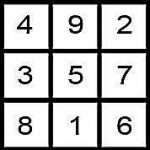
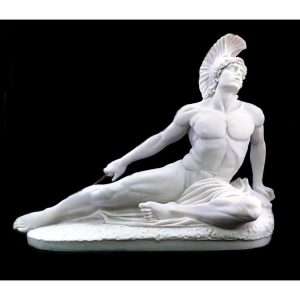
The death of Achilles. Feet 'horizontal', head 'vertical'? N/E? 'Knee' = S/E. The start of something new?
Side note: "I moved into the center of the Kings chamber, the long axis of which orientated east to west while the short axis was equally perfectly orientated north - south. The room formed a precise 2 by 1 rectangle....The floor consisted of 15 massive granite paving stones, and the walls - 100 granite blocks....laid in five courses....The sarcophagus of which had an external volume twice as that of the internal one …." [Page 330 'Fingerprints of the Gods'].
While recalling that the kings chamber is ''free standing''.
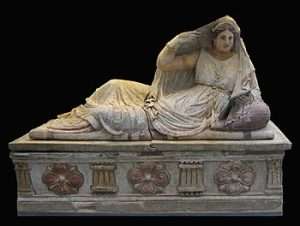
Etruscan 'noble' woman. Veiled or UNveiled? A beginning or end?
A work in progress: ''When archaeoloists first excavated a 5th century A.D. cemetery in Pannonia, an ancient Roman province in present day Western Hungary - they found a large portion of elongated, oblong heads {purposely 'deformed'}....almost 50% came from outside the local boundaries hence: ''The practice was imported - and not sure as to why skull modifications took hold in this region after the fall of the Roman Empire.'' ['Page 16 'Archaeology' / Jan/ Feb 2021].
Get into that MIND SET to understand why. Enlarged elsewhere.
''Foreign spirit'' to enlarge.
Crook and Flail?

The cosmic 'egg' ? Achernar?

Aeneas escaping Troy with father and son. East or west as a ''transformation'' into something new?
Continued: Analogy of same [principle?]..."The sound Am is used to harness the Life Force energy. Special attention is given to the ''m'' in Am, which is the universal sound of the original vibration enjoined by the 'spirit' to bring 'creation' into being. In this sense the ''m'' becomes an emphatic ''M'' that carries the grosser vibration at the beginning of the syllable to a greater level of subtlety...The letter ''m'' in ancient Egyptian grammar signifies ''transformation'' from one form to another...from ordinary consciousness to someone possessing enlightened consciousness {representational of}...''AM'' is a universal word of power...OM or AUM is related to the word Amun and Amen of Christianity..."[Extract from the book by S. Ashby. Emphasis, this readers]. Try ''being'' and ''logos'' to connect it all - if only for this reader - before asking yourself those bigger questions - agree or disagree? Fact or fiction ?
Antares = 'Heart of the Scorpion' | Brightest Stars | EarthSky.

A working example: "Akasha is called the sonoriferous ether, or the subtle principle which takes form in our sense of hearing. SOUND is the basic mode of vibration, because sound is produced by a smaller number of vibrations per second than is light.

''The Birth of the New Man.'' 'Egg/Incarnation' to enlarge
Thus sound vibration is likened to the EGG from which light is born. 'Fundamentally, all forms of vibrations are generated by and are transmutable into ''sound'' says Edward {M}aryon in {M}arcotone - 'therefore sound is the origin, even as it is the architect and builder of form." [Page 28 / P. F. Case. Vol 1].
''Hen'' ?

The Manger. "Path of Love is like a bridge of hair across a Chasm of Fire."
A working example {i.e., something that can be worked out beyond 'superstition'}: "Hog-manay, the last night of the year, preserved in the Highlands of Scotland a ceremony which must have belonged once to Hallow-een, the Celtic New Year's Eve....

Bridge over troubled waters?
A man dressed in a bull's hide, had to run 'sunways' around the house and then pronounce a blessing on the inmates and their 'cattle'. He then burnt some of the 'bulls' hairs on the 'fire' and all the people including the domesticated cattle had to smell it. The whole performance was accompanied by racing and chasing, SHOUTING and din. Till relatively recent times the cattle byre was a part of the house..." [Page 121 'GogMagog'].
''Striving'' ?
Try ''manger'' to enlarge further.
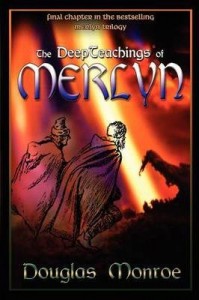
Question. Croc. Head? Higher or lower? And what within that picture could represent 'its' flip side?
Side note: "Both the Kabbalah and the Vedas teach that the very root-sound of the word 'OM' is a powerful vibration of openness and closure. For those knowledgeable in tongues, the word means 'many-occurring' and stands for the variety of possibilities in nature...As it regards 'reincarnation' - rebirth may occur with an evolving soul, or it may not {redeemed/unredeemed?} - and something else may occur. A variety of experience!'' [Douglas Monroe].
Continued: "Like all M-type giants and supergiants, Antares is close to the end of its lifetime. Someday soon (astronomically speaking), it will effectively run out of fuel and collapse. The resulting infall of its enormous mass – some 15-18 times the mass of our sun – will cause an immense supernova explosion, ultimately leaving a tiny neutron star or possibly a black hole. This explosion, which could be tomorrow or millions of years from now, will be spectacular as seen from Earth, but we are far enough away that there likely is no danger to our planet." [www.earthsky.org].
Side note: The 'Sky at Night' program { 'Xmas Special'} asks the question as to the possible interpretation of the 'Star of Bethlehem' that lead the three Magi to the 'manger'. Understand that universal ''mindset'' to get beyond the obvious i.e., supernova, or just nova, comet, meteorite etc. Enlarged elsewhere. Try ''manger''.

Only found on Northwestern EDGE of Europe {i.e., Holyhead/Anglesey}.
Side note: ''The name Beehive {i.e., Praesaepe - the heart of the Crab in Cancer} - derives from the appearance of a swarm of stars in a dance of activity. There are at least 40 stars in the cluster that are visible to the naked eye as a cloudy patch, its 1.5 degree size is equivalent to three full moons end-to-end. In ancient times this cluster often served to predict the weather; if not crystal clear inclement weather might be on the way. Pliny said, “If Praesaepe is not visible in a clear sky it is a presage of a violent storm”.
With us it is the well-known Beehive, but its history as such I have not been able to learn, although it undoubtedly is a recent designation, for nowhere is it [named] Apiarium
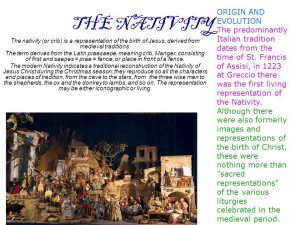 Scientifically it was the (Greek) Nephelion, or Little Cloud, of Hipparchos; the (Greek) Achlus (Achlus), or Little Mist, of the Greek astronomer Aratus, circa 270 B.C.; the (Greek) Nepheloeides, Cloudy One, (Greek) Sustrophe (“a twisting together“), or Whirling Cloud, and (Latin) Nubilum, literally a Cloudy Sky, of the 17th century German astronomer Bayer; {p.113} but the Almagests and astronomers generally of the 16th and 17th centuries referred to it as the Nebula, and Nebulosa, in pectore Cancri, for before the invention of the telescope this was the only universally recognized nebula, its components not being separately distinguishable by ordinary vision. But it seems to have been strangely regarded as three nebulous objects. Galileo, of course, was the first to resolve it, and wrote in the Nuncius Sidereus
Scientifically it was the (Greek) Nephelion, or Little Cloud, of Hipparchos; the (Greek) Achlus (Achlus), or Little Mist, of the Greek astronomer Aratus, circa 270 B.C.; the (Greek) Nepheloeides, Cloudy One, (Greek) Sustrophe (“a twisting together“), or Whirling Cloud, and (Latin) Nubilum, literally a Cloudy Sky, of the 17th century German astronomer Bayer; {p.113} but the Almagests and astronomers generally of the 16th and 17th centuries referred to it as the Nebula, and Nebulosa, in pectore Cancri, for before the invention of the telescope this was the only universally recognized nebula, its components not being separately distinguishable by ordinary vision. But it seems to have been strangely regarded as three nebulous objects. Galileo, of course, was the first to resolve it, and wrote in the Nuncius Sidereus
“The nebula called Praesepe, which is not one star, only, but a mass of more than forty small stars. I have noticed thirty stars, besides the Aselli.”
Popularly it also is the Manger, or Crib, the Phatne (a crib or manger from Greek pateomai “to eat”) of the Greek astronomer Aratus, circa 270 B.C., and Eratosthenes; the Phatnes of the second-century Greek astronomer Ptolemy; and with the Latins, Praesaepe, Praesaepes...'' ['Constellations of Words' / Internet].
And/or: ''If you have pulled this card. you are asked to embody your star consciousness. The star of your being is rising....'' [Card 17 -Sothis- 'The Anubis Oracle'].
 Continued: As seen from a different perspective {'angle'}..."In Tantric Yoga there are a great deal of Sanscrit words, ending with the letter 'M' which are known as Bijas. A Bija has its own meaning as a word, but its meditational use is non-rational. It is the sound, the particular vibratory effect, which is important. In the chanting of Bijas, the terminal 'M' is, as it were, held back {rather in the manner of the English 'NG' ending} and made to resonate within. Its effects are psycho-physical and act upon the nervous system, certain resonated sounds being stimulating and others being pacifying. Some are regarded as positively dangerous, and a Bija is 'fitted' to a pupil by his guru. The pupil will try out the vibratory effect of a number of Bijas, choose the one most helpful to him, and after a little while he will chant it silently. This is an exercise of the imagination, when its power too induce interior silence is profound. The nervous system, once trained to respond to the resonance of a Bija, brings the body into a deep silence..." [From the book by A. Duncan].
Continued: As seen from a different perspective {'angle'}..."In Tantric Yoga there are a great deal of Sanscrit words, ending with the letter 'M' which are known as Bijas. A Bija has its own meaning as a word, but its meditational use is non-rational. It is the sound, the particular vibratory effect, which is important. In the chanting of Bijas, the terminal 'M' is, as it were, held back {rather in the manner of the English 'NG' ending} and made to resonate within. Its effects are psycho-physical and act upon the nervous system, certain resonated sounds being stimulating and others being pacifying. Some are regarded as positively dangerous, and a Bija is 'fitted' to a pupil by his guru. The pupil will try out the vibratory effect of a number of Bijas, choose the one most helpful to him, and after a little while he will chant it silently. This is an exercise of the imagination, when its power too induce interior silence is profound. The nervous system, once trained to respond to the resonance of a Bija, brings the body into a deep silence..." [From the book by A. Duncan].
"Philo describes Sophia as the 'mother of the Logos'. [Quote from the book by T. Freke and P. Gandy].
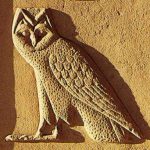
Egyptian phonetic 'M'.
AUM - Resonates {begins} at the back of the mouth - closes at the {front} of the mouth. Something being 'digested' internally? Alchemy equivalent the 'lion' and 'sun' ? Picture found elsewhere. ALL as a means to understand something - relative to the self.
The real questions, however, remain the same.
Alchemy equivalent? {i.e.,indicative of.}: "Zosimos refers to Mary {i.e.,'Mary the Jew'} as the 'Transmitter of the Art'." ['The Chemistry of Alchemy'].
"In the old Indian civilization the idea of Unity prevailed. Those magnificent scriptures of the primeval East which we now possess, were handed down for long ages only by word of mouth, the Veda - or Word; and from them we know how man felt himself entirely united with the spiritual origin of his existence. The three vowels of the sacred Word were experienced differently: as A, O, U, and they culminated in a fourth sound, M, which signifies silence - the closing of the mouth...In head, heart, and breath {thinking/feeling/willing?} - the ancient Indian, though aware that these held for him a 'triad' of experiences, felt himself completely identified with the Earth, the Sun, the sun impregnated atmosphere. He looked toward the Self with reverted insight, i.e.,outwards into the cosmic whole - seeking 'deathlessness'. " ['The Flaming Door'. Mentioned elsewhere].
"Reverted" in relation to an 'about turn' of something?
Cassiopeia.
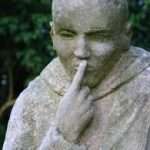
Little and large?
"The importance of OM {pronounced AUM} - the primal 'word', can be traced through the teachings of Plato, the Greek Stoic philosophers and Philo the Jew to St. John, the author of the 4th Gospel in the New Testament, who writes, 'In the beginning was the word. The word was with god etc..."Om implies no special divine attributes and refers to no particular picture of god. It is a universal and non-specific name for the ultimate 'power' of life, and is often used as a symbol to represent the Hindu faith. It is a natural and complete sound, a primal 'word' - a word beyond meaning, just as 'god' is truly an idea beyond intellectual understanding.." [From the book 'World Mysticism'. Mentioned elsewhere. Emphasis, this readers].
''Intellectual'' = the 'Tower of Babel'. Representational of?
A side step..."The blue iris and, above all, the white Madonna Lily, were plants deeply associated with the virgin Mary. Precisely where we find plants accurately depicted, we encounter the paradox that they are only depicted with such care because they were seen as pointing beyond themselves to specific spiritual qualities. The environment in which 'they grow' is thus one frequented by 'angels' and saints." [From the book 'The Future of the Ancient World: Essays on the History of Consciousness' by J. Naydler. Emphasis, this readers]. Get it?
From 'Stone' to 'plant' as a means...

'Head of the corner'? Eastern equivalent? Therefore - 'Fired' / UNfired? If so, what symbols represent each and why? Final link to E/W and S/N. Which and why?
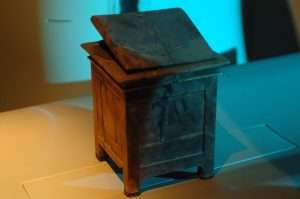
Solitary 'tooth' {and liver} found in a 'square' box belonging to Hatshepsut.
Refresher : "...in its 'physical' form as a 'Lily', i.e.,"as bearer of symbolic meaning". Chapter two. Same book. All as a means...?
Analogy?: "Bluestar'' is actually a viney flower - identical to today's common variety of blue Morning Glory. It is a plant with a fascinating history of religious use, extending back as far as ancient Sumeria, Egypt and Greece, through the Aztec's, and more recently to the 1960's psychedelic ''hippy movement''. [Page 54 'The 21 Lessons of Merlyn: A study in Druid Magic and lore'].
The real questions, however, remain the same.
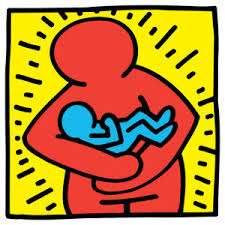
try ''child'' as a means...?
Western equivalent?..."The potential literature for an intellectual study of this is vast. We hope we have provided a few simple pointers on the way. It is however, a 'centering' in, rather than a wandering in the labyrinthine fields of intellectual speculation, that is the direct way of truth. The 'rose' blooms at the center of the cross {animate/inanimate?}. And those who are prepared to contemplate the imagery and take it unto their inmost hearts are the more likely to be met by Beatrice from the triumphal car {'chariot'?}, and 'led' to places where even the intellectual genius of a Virgil cannot go. To this end we can hardly do better than to survey the body of images that are presented in the Litany of the Blessed Virgin Mary. Any of these images {Atalanta?} will infinitely repay meditation, contemplation and appropriate acts of symbolic or ritual intention. They may be grouped under the three heads of Mother, Maiden or Virgin, and Queen." [From the book by G. Knight].
'The Wise Old Woman: A Study of Active Imagination' by Rix Weaver.
Side note: ''The Chartreux Brothers, also known as Carthusians embrace a deeply escetic existence in S/E France's Chartreuse Mountains - the emerald of the Alps. Its origins began in 1084 with 'seven' men, in seach of isolation and solitude. According to legend, centuries later, in 1605, the order's monastery recieved an alchemist's ancient manuscript for a perfectly concocted medicinal tonic of about 130 herbs and plants: the Elixir of Long Life....This lifestyle has survived centuries of external turmoil...including the French Revolution and plagues. Through times of earthly chaos, the Chartreux thrive in accordance with their Middle-Ages motto: 'The cross is steady while the world turns'....'' [Page 90 'Readers Digest' / April 2022].
Precession?
Recall the supernova of 1054
And/or: ''At the start of the 17th century the world was still fraught with wonders and nothing seemed impossible. In December 1603 there was a conjunction of Saturn and Jupiter, the hour hands of the cosmic clock which usher in new epochs and crumbles old orders. New stars suddenly appeared in the constellations of the Serpent and the Swan, and fears and hopes were rife throughout Europe. In England the long reign of the Tudors came to an end....'' [Page 5 'Robert Fludd' / J. Godwin].
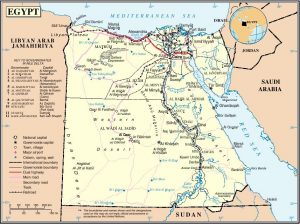
S/W corner = 1st/4th/7th or 10th? As a means....?
As seen from a different perspective {that first one?}: "The truly creative accomplishment of the human individual is accomplishment in totality and in plenitude of humanhood; and the framework of such a creative accomplishment is provided by the four basic phases of experience represented by the four ''angles'' of the birth-chart - first, fourth, seventh and tenth houses. These constitute the cross of human living: the permanent self, the rooted and centred personality...At the center of this cross, when lived in balanced {Libra?} activity and in the conscious use of power {'meridian' and/or 'grace'?}, the 'Rose' of human plenitude blossoms forth...'' ['The 12 Astrological Houses'].
 From a different perspective "In the old days we were strong and happy people - all our power came to us from the sacred hoop of the nation, and so long as the hoop was unbroken, the people flourished. The flowering tree {hawthorn?} was the living center of the 'hoop' and the circle of the four quarters nourished it." [Black Elk].
From a different perspective "In the old days we were strong and happy people - all our power came to us from the sacred hoop of the nation, and so long as the hoop was unbroken, the people flourished. The flowering tree {hawthorn?} was the living center of the 'hoop' and the circle of the four quarters nourished it." [Black Elk].
Side note: ''Mankind, more than is realised, is an expression of the part of the earth upon which he subsists. A 'rose' of the West should not aspire to bloom like a 'lotus' of the East....West is a place of manifestation - the East a place of beginnings..." [Pages 1/6 'The Western Way' / C+J Matthews].

''In PRE-FLOOD times there arose a race of giants." [Page 116 same book]. 'Higher' of the lower?
What would the highest be represented with?
Head/feet? or Hands/feet?

'Triangle' or 'right angle'? of the 4th Galactic Quadrant. As a means...?
Analogy of same?..."The present Arabic name of Egypt is al-Misri, which is the equivalent of the biblical Misraim. This name is derived from the Semitic root which in Akkadian gives the verb asaru, "to cut, to delimit, to delineate", and hence, "to draw a picture, a plan, " and the noun esertu, "drawing plan, representation," applied in particular to the specifications for the construction of a building. In Semitic language an 'm' before the root of a verb forms what we would call a past participle: Egypt is the country built according to a geometric plan. The Egyptians expressed this idea by calling their land To- Mera, "the land of the mr." The word 'mr' is used to refer to the pyramids, but more specifically it refers to the meridian triangle of a pyramid, whose hypotenuse is the apothem. The 'mr', essentially is a right angle triangle....." [Page 291, from the book, 'Jesus Christ Sun of God'. Mentioned elsewhere]. Try ''hypotenuse'' in the usual box.
Landscape equivalent?..."Meretseger was generally shown as a coiled cobra, or as a cobra with a woman's head. Sometimes she was shown in cobra form with head and arm projecting from the hood of the cobra. At other times she was shown as a snake, with three heads - that of a woman, cobra and vulture. On occasion she was also shown as a cobra headed woman or as a full woman , though this is very infrequent. Her name ''She who loves silence'' comes from mr = ''love'' {with the feminine 't' ending} and sgr = ''quiet''. She was believed to live on a certain peak, shaped like a pyramid {which has the sound ''mr''}...At times she was known as her dwelling place as 'Peak of the West'..." ['www.touregypt.net].
''Peak'' in relation to the pinnacle of something i.e., 'lord' and/or therefore ''king''? {horn?}.
Westward leading, still proceding guide us to thy....
Side note: ''The song 'Instanbul {not Constantinople}' - was the first GOLD record hit for 'The Four Lads' in 1953.'' [Pawn Stars].
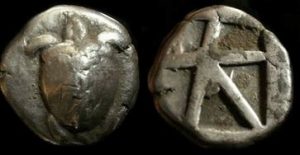
Made of electrum {gold/silver}. Some called it ''green gold''. The top {''capstone''} of the Great Pyramid also had same. The coming 'together' of ''gold'' and ''silver''. A union of something. As a means....?

"Melancholia has been a popular topic in the western world for centuries. The term was coined by an ancient Greek physician, Hippocrates, and means “black bile.” When someone has a mood that is low, they can have more black bile. It is connected to sadness or depression. There is still a lot of debate on whether or not to treat this condition. Some people think that the person should be able to get better without help. But other people think they need to get treatment. Do not feel bad if you sometimes feel sad or happy. Moreover, everyone has these feelings. Sometimes we feel sad. These feelings may happen because our brain reacts differently than it does to other things."
Additional information? : "The human headed vase was called Imset, {as part of the 'four sons of Horus'} - and contained the liver...The name Imset is related to the production by the liver of 'set', the separating fire of the god Set, the bile. The word for liver is 'miset' or 'merset' usually written with the sign 'Mr', which represents a canal or reservoir; and of course the liver is the reservoir of the ''water of Set'', the bile, which it canalizes into the gallbladder. Thence the bile runs into the small intestine, where it makes possible the separation of subtle and coarse, of pure and impure. The symbol of the human head shows the two aspects of the 'liver'; in its psychic role it is the seat of the Personality, whose innate and inherited characteristics are engraved in it. Second, this indicates the mutual reaction of the brain and liver whenever the Personality receives a 'shock'. The Egyptians also said that ''Imset leads his brethren'' and that he ''makes green'' {rwd, meaning to grow, to vegetate}. By its separative action the bile creates the chyle, which is the basic nourishment of vegetative life. Imset ''leads his brethren'' {'brother'?} who are the other animal functions, because he is the seat of the personal impulses which can direct or thwart the animal instincts...The liver is the seat of the subconscious personality, the 'Automaton', but also of the Permanent Witness." ['The Opening of the Way' / Page 195].
'Green Lion'?
'Star Witness'? {i.e., first one}.
''Human headed'' in relation to ''horn''. Single or double horn?
''Vegetative life'' REPRESENTED with the 'petals' {lotus?} found in the ''middle'' of the forehead in the outermost coffin of Tutankhamun.
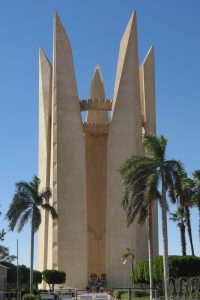 ''Electrum is a naturally occurring alloy of gold and silver, with trace amounts of copper and other metals. The ancient Greeks called it "gold" or "white gold", as opposed to "refined gold". Its colour ranges from pale to bright yellow, depending on the proportions of gold and silver. It has been produced artificially, and is also known as "green gold".'' [Wiki].
''Electrum is a naturally occurring alloy of gold and silver, with trace amounts of copper and other metals. The ancient Greeks called it "gold" or "white gold", as opposed to "refined gold". Its colour ranges from pale to bright yellow, depending on the proportions of gold and silver. It has been produced artificially, and is also known as "green gold".'' [Wiki].
A working example: While the Lydian Lion coins are generally considered to be the world's first standardized coinage, there is some debate among scholars about whether the earlier Greek Aeginetan coins were the first truly standardized coins. Both the Lydian Lion coins and the Aeginetan coins were made of electrum, a naturally occurring alloy of gold and silver. However, the Aeginetan coins were slightly heavier than the Lydian Lion coins, and they also had a different design....
 The exact date when the Lydian Lion coins were first minted is unknown. However, most scholars agree that they were first minted sometime around 610 BC, based on the archaeological record and the writings of ancient historians. For example, the Greek historian Herodotus wrote that King Alyattes of Lydia, who reigned from 610 to 560 BC, was the first Lydian king to mint coins...
The exact date when the Lydian Lion coins were first minted is unknown. However, most scholars agree that they were first minted sometime around 610 BC, based on the archaeological record and the writings of ancient historians. For example, the Greek historian Herodotus wrote that King Alyattes of Lydia, who reigned from 610 to 560 BC, was the first Lydian king to mint coins...
 It is fitting, and worth observing, that the Lydians engendered a mercantile culture; Herodotus acclaimed them (with exaggeration) as the world's first merchants, as they earned a reputation for being important interlocutors between East and West. In his monograph The Coinage of Lydia and Persia, Barclay Head noted “the spirit of commercial activity which the natives of Lydia possessed,” while another 19th-century historian, Ernst R. Curtius, compared their knack for playing middlemen to that of the Phoenicians: "The Lydians became on land what the Phoenicians were by sea, the mediators between Hellas [Greece] and Asia." With its strategic territorial expansion near the Bosporus and Hellespont (now the Dardanelles Strait), which effectively connect the Black Sea to the Aegean Sea, it is no surprise that the Lydian Empire of the late 7th - early 6th century BCE would be home to a thriving mercantile tradition. The Lydians even gave special status to merchants within their society: they were known as agoraios, or “People of the Market,” and enjoyed a higher rank than commoners in the social hierarchy.
It is fitting, and worth observing, that the Lydians engendered a mercantile culture; Herodotus acclaimed them (with exaggeration) as the world's first merchants, as they earned a reputation for being important interlocutors between East and West. In his monograph The Coinage of Lydia and Persia, Barclay Head noted “the spirit of commercial activity which the natives of Lydia possessed,” while another 19th-century historian, Ernst R. Curtius, compared their knack for playing middlemen to that of the Phoenicians: "The Lydians became on land what the Phoenicians were by sea, the mediators between Hellas [Greece] and Asia." With its strategic territorial expansion near the Bosporus and Hellespont (now the Dardanelles Strait), which effectively connect the Black Sea to the Aegean Sea, it is no surprise that the Lydian Empire of the late 7th - early 6th century BCE would be home to a thriving mercantile tradition. The Lydians even gave special status to merchants within their society: they were known as agoraios, or “People of the Market,” and enjoyed a higher rank than commoners in the social hierarchy.

"Archaeologists examined the skulls of 130 men who were buried across the Viking world between the 10th and 12th centuries and who had strange horizontal striations on their teeth {e-w?}. The majority found in the Kopparsvik cemetery on the Swedish island of Gotland which was an important trading center....The merchant class." ['Archaeology' / Sep-Oct 2024]. Recall the tail end of something on the Viking helmet. Just above the upper lip. {N-S?}.

“Most certainly, I tell you, one who doesn’t enter by the door into the sheep fold, but climbs up some other way, is a thief and a robber."
Side note: "Gotland today is part of Sweden, but during the Viking Age, roughly 800 to 1150, it was independently ruled. The accumulation of riches on the island from that time is exceptional. More than 700 silver hoards have been found there, and they include around 180,000 coins. By comparison, only 80,000 coins have been found in hoards on all of mainland Sweden, which is more than 100 times as large and had 10 times the population at the time. Just how an island that seemed largely given over to farming and had little in the way of natural resources, aside from sheep and limestone, built up such wealth has been puzzling. Excavations led by archaeologist Dan Carlsson, who runs an annual field school on the island through his cultural heritage management company, Arendus, are beginning to provide some answers.
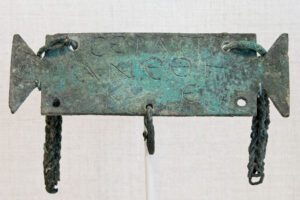
Votive tablet_Serapis. "Votives were kept on display in the god's sanctuary for a set period of TIME and then were usually ritually discarded. Bronze tripods, prize cauldrons and figurines, terracotta tablets and figurines, lamps, and vases are typical examples." One 'panel' or two?
Traces of around 60 Viking Age coastal settlements have been found on Gotland, says Carlsson. Most were small fishing hamlets with jetties apportioned among nearby farms. Fröjel, which was active from around 600 to 1150, was one of about 10 settlements that grew into small towns, and Carlsson believes that it became a key player in a far-reaching trade network. “Gotlanders were middlemen,” he says, “and they benefited greatly from the exchange of goods from the West to the East, and the other way around.”
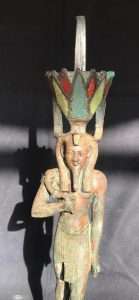
From the 'waters' of creation {Self becoming?} - a lotus flower.
Something extra: "On the right panel {of the fireplace}, opposite the one we have just analysed, we notice the previous identified old mans mask, holding in his jaw two plant stems with leaves - with flower bud about to be opened. These stems set a kind of open 'almond', inside which we catch the sight of a 'vase' decorated with scales and containing flowerbuds, fruit, and ears of corn. Here is the symbol of 'vegetation', nutrition and the growth of the new born body previously discussed....The scaly vase represents the primitive substance,,,,extracted from the 'mine' {cave?} which begins ones labour..." [Page 213 'The Dwellings of the Philosophers' / Fulcanelli].
Gnashing of teeth?

Crossroads: Which is S/E?
Continued: It is, however, unclear that the earliest staters of Lydia actually circulated in commercial exchange. In archaeological sites near Sardis, for instance, there are no staters found in the ruins of shops and marketplaces. One would expect to find them here if they were spent as money within the kingdom. More likely, these coins were hoarded by the king and the wealthy, perhaps issued for the collection of taxes, and used in long-distance trade between Lydia and its neighbors, as many staters have been recovered from Ionian temples.

There do exist cruder pieces struck in electrum that possibly predate the stater. These first electrum “pre-coins” were blank, bearing no emblem that tied them to an issuing authority. They sometimes featured striations on one side of the flan, which historians have speculated may harken to the electrum-rich Pactolus River that supplied the raw materials for these pieces. (The Pactolus was said to have acquired its metallic abundance when King Midas of nearby Phrygia bathed in its waters to remove his curse of the “golden touch.”) It appears, however, that many of the Asiatic Greek cultures — especially in Miletus (or Miletos) and Ionia, along the Aegean coast — were using, or perhaps experimenting with, these electrum blanks contemporaneously with the Lydians. It is the administrative innovations of Alyattes and his son Croesus (or Kroisos) which set the Lydian staters apart....
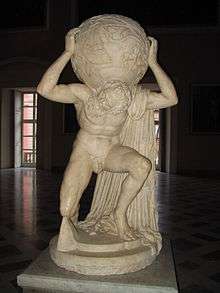
What would the remedy be for such a weight ''upon ones shoulders''?
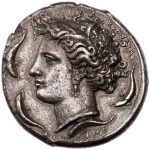
Arethusa coin
Staters came in somewhat irregular shapes, many of them ovular or bean-shaped, but had a fairly consistent weight of 220 grains of wheat. (This measure is somewhat complicated by the variance between the wheat grains, barleycorns, and carob seeds that formed the basis for different weight standards in antiquity.) This weight is what defined a “stater.” In fact, all ancient coin “units” or denominations — such as shekels, drachms, and the like — were expressions of units of weight rather than a specific value. The term “stater,” for instance, was used generically around ancient Greece to mean “that which balances scales.”
Side note: Shekel came into the English language via the Hebrew Bible, where it is first used in Genesis twentythree. The term "shekel" has been used for a unit of weight, around 9.6 or 9.8 grams (0.31 or 0.32 ozt), used in Bronze Age Europe for balance weights and fragments of bronze that may have served as money.
Continued: "The coins were minted in Sardis (or Sardes), the Lydian capital, with an unmistakable design that represented the city: the foreparts of a lion (on the left) and a bull (on the right) facing one another. Smaller varieties only use the right-facing lion protome with a small sunburst above that many modern observers mistook for a “nose wart.” The image was created by a punch, as evidenced by the two incuse squares located on the reverse of the coin. This design is of crucial importance, not only in its Assyrian symbolism, but also for its identifying presence. The use of the “Lydian Lion” hallmark showed that these coins were official tender of the king in his kingdom, an idea that we do not see employed in the ancient world prior to Lydia. Rather quickly, however, other kingdoms and empires adopted the same seigniorage scheme as Alyattes had, and Croesus built upon after him.

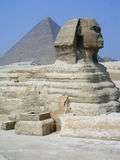
Common factors?
The Lydian Lion coins were primarily crafted from electrum, a naturally occurring alloy of gold and silver found in abundance in the Pactolus River, which flowed through Lydia. Electrum, with its high purity (typically 54% gold and 46% silver), became the hallmark of these coins. The design was beautifully simple, featuring a lion's head on the obverse and an incuse square on the reverse, which was created during the minting process, leaving a punch from the hammer used to shape the coin....they were actually made from a specific and rather consistent mix of approximately 55% gold, 45% silver, and a small balance of copper. This indicates that silver and copper were added to natural electrum in order to achieve a more durable and balanced metal alloy. Although the extra copper slightly debased the coin's intrinsic value, it allowed it to exhibit a golden hue, unlike the pale white-gold color of pure electrum.
The exact reasons why King Alyattes of Lydia decided to mint standardized coins are unknown....
An incuse coin differs radically from a traditional coin. Traditional coins have raised design devices, meaning the details of the design--say the head of a President--will appear on top of the fields of the coin. The designs on incuse coins are structured differently: the fields are the highest point on the coin, and the devices or design details are struck “incused,” or indented, below the fields. Incuse coins have been made and used in commerce dating back to 600 B.C. in Greece and Italy.
Embossed/Debossed?
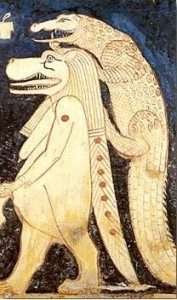

Alte Burg. Described as an oval shape 'hippodrome'. The first of its kind.
What was the Sed festival in ancient Egypt: Heb-Sed, one of the oldest feasts of ancient Egypt, celebrated by the king after 30 years of rule and repeated every 3 years thereafter. The festival was in the nature of a jubilee, and it is believed that the ceremonies represented a ritual reenactment of the unification of Egypt, traditionally accomplished by Menes.
Side step: Large stone Jars {'vases'?} found N/E Laos; in a valley below a mountain range; a few found in East India; speculation as to why. Question. Any link between ''east'' and ''vases''? [Chapter headed 'Mystery of the Plain Jars: the Quest to Solve one of Archaeology's Greatest Puzzles' / Readers Digest. September 2020].

Limgam/Yoni - carved on a river bed.
Refresher: ''When the sperm drop falls into the womb, it represents the First Substance. When the embryo has four strata, it represents the elements and the natures. When the members appear, the outward members like the head, the hands, the stomach, the private part, and the feet represent the seven climes. The INWARD members like the lungs, the brain, the kidney, the heart, the gallbladder, the liver, and the spleen represent the 'seven' heavens. The lungs are the first heaven and represent the sphere of the moon, the intermediary between the two worlds...many angels....the leader of which in charge of temperate water and air. The brain is the second heaven and represents the sphere Mercury...Main angel in charge of learning to write, aquiring knowledge, and managing livelihood is Gabriel. He is the second cause of the knowledge of the people of the world. The kidneys are the third heaven = Venus = joy/happiness.

Happy or Sad? Plant/mineral or animal?
'Appetite' is the leader of these angels. The heart is the fourth heaven = the sun = Seraphiel. He is the secondary cause of the life of the people of the world. The spleen is the fifth heaven = Mars, in charge of severity, wrath, beating, and killing. He is the LENDER {leader?} of these angels. The liver is the sixth = Jupiter = Michael = ''the cause of the provision of the inhabitants {people}. The gallbladder = seven{th} heaven = Saturn = ''in charge of taking spirits {at death} = Azrael. The animal spirit is the FOOTSTOOL and represnts the sphere of the fixed stars, since the sphere of the LURED stars is the footstool of the macrocosm. The psychic spirit is the Throne and represents the sphere of spheres. The intellect is the vicegerent of god. As long as the bodily members do not grow and develop, they represent minerals. When they do begin to grow and develop they represent plants. When sensation and volitional movement appear, they represent animals. Ten qualitative levels. Different things in the universe give news of god in diverse ways and various degrees. God is light, and there is no light but light.'' [Pages 90-92 {Kindle}: 'Tao of Islam' / Murata Sachiko].
UNmanifested/Manifested to enlarge.
 Continued: "The immense waterworks undertaken by the ancient Egyptian pharaohs of the twelfth dynasty to transform the lake into a huge water reservoir gave the impression that the lake was an artificial excavation, as reported by classic geographers and travellers. The lake was eventually abandoned due to the nearest branch of the Nile shrinking from 230 BC.
Continued: "The immense waterworks undertaken by the ancient Egyptian pharaohs of the twelfth dynasty to transform the lake into a huge water reservoir gave the impression that the lake was an artificial excavation, as reported by classic geographers and travellers. The lake was eventually abandoned due to the nearest branch of the Nile shrinking from 230 BC.
The name Moeris is a Greek version (reformed as if from Greek - "the Fates") from Egyptian mer-wer ‘great canal’. Amenemhat III, who started this project was also known as Moeris. In ancient Egypt, the lake was also variously called ‘the lake’, ‘pure lake’, and ‘Osiris’ lake’. During the Middle Kingdom, the whole area around the lake was often referred to as mer-wer as well. Similarly, the Late Egyptian word Piom ‘sea’, originally restricted to Lake Moeris, came to be used to refer to the city of Crocodilopolis (mod. Faiyum), then to the entire region in later times." ['Wiki']. Try ''crocodile''.
Side note: "But sacred libations were also poured through ceremony as a 'magical' devise for effecting the rebirth of the spirit body into the inner life, thus serving as a spiritual birth canal..." [Page 103 of the book by R. Clark].
N.B. The founding of Alexander began in the south at the Moeris lake. Why?
Schedia {S/E} and Kibotos {N/W} canals associated with same.
All as a means...?
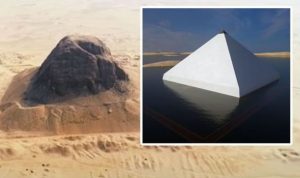
Senusret II was the fourth pharaoh of the Twelfth Dynasty of Egypt who ordered for the construction of the Pyramid of Lahun before his death. The ancient ruler took a great deal of interest in the Faiyum oasis region and began work on an extensive irrigation system from Bahr Yussef through to Lake Moeris in Middle Egypt.

'Three and Four' = ''two in one''?
And/or: ''The pyramid of Seila is one of a group of seven small step pyramids which are very similar to one another, along with the Edfu South pyramid, the pyramid of Elephantine, the pyramid of El-Kula, the pyramid of Naqada, the pyramid of Saujet el-Meitin, and the pyramid of Sinki. These pyramids were all built far from the major centres of Egypt and very little is known about them. The pyramid is located on an outcrop between the Faiyum Oasis and the Nile Valley, about 6 km north of the motorway from Wasta to Faiyum. Its builder may have been Snefru, the founder of the Fourth Dynasty. It was discovered in 1889/1890 by Flinders Petrie[1] and revisited in 1898 by Ludwig Borchardt.''
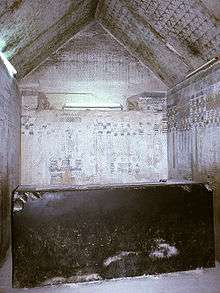
Common factors?
And/or: ''There are seven step pyramids that are attributed to either Huni - the last king of the 3rd Dynasty - or Sneferu - the first king of the 4th Dynasty. Located in different provinces in Egypt, from Seila near the Faiyoun in the North to Elephantine in the South. All stand alone. None have entrances, internal CORRIDORS, or chambers. Could not therefore have been tomb locations.'' [Page 96 'Shamanic Wisdom in the Pyramid Texts' / J. Naydler].
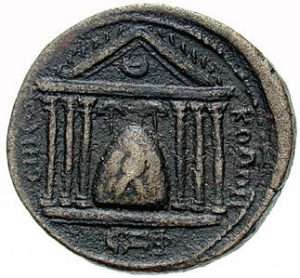
A baetyl (/ˈbiːtɪl/; also betyl), literally "house of god" is a sacred stone (sometimes believed to be a meteorite) that was venerated and thought to house a god or deity.[1] The most famous example is the Omphalos stored in the Temple of Apollo at the Greek town of Delphi.
That DUALITY again.
Mud brick baked by the sun. Limestone created by ancient sea beds. Fire/Water. Innner/Outer as a means....?
Gross/subtle.
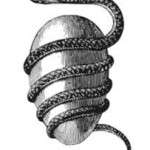
Inner/outer. A beginning or end?
''The limestone from Tura was the finest and whitest of all the Egyptian quarries, so it was used for facing stones for the richest tombs, as well as for the floors and ceilings of mastabas, which were otherwise made of mudbrick... A layer of limestone covers most of the surface of modern Egypt. Beneath this lies a bed of sandstone, and this earlier sandstone is the surface rock in Nubia and southern Upper Egypt, as far north as the area between Edfu and Luxor.''
Jebel Barkal - as a means....?
 And/or: ''El Lahun (Arabic: اللاهون El Lāhūn, Coptic: ⲗⲉϩⲱⲛⲉ alt. Illahun, Lahun, or Kahun (the latter being a neologism coined by archaeologist William Matthew Flinders Petrie) is a workmen's village in Faiyum, Egypt {'new city'?}. El Lahun is associated with the Pyramid of Senusret II (Greek: Sesostris II), which is located near the modern town, and is often called the Pyramid of Lahun.
And/or: ''El Lahun (Arabic: اللاهون El Lāhūn, Coptic: ⲗⲉϩⲱⲛⲉ alt. Illahun, Lahun, or Kahun (the latter being a neologism coined by archaeologist William Matthew Flinders Petrie) is a workmen's village in Faiyum, Egypt {'new city'?}. El Lahun is associated with the Pyramid of Senusret II (Greek: Sesostris II), which is located near the modern town, and is often called the Pyramid of Lahun.

"Pavilion" hip roof on a square plan with pitches rising to a peak.
The ancient name of the site was rꜣ-ḥn.t, literally, "Mouth (or Opening) of the Canal")....The most remarkable discovery was that of the village of the workers who both constructed the pyramid and then served the funerary cult of the king {'Senusret is at peace'}. The village, conventionally known as Kahun, is about 800 meters from the pyramid and lies in the desert a short distance from the edge of cultivation. When found, many of the buildings were extent up to roof height, and Petrie confirmed that the true arch was known and used by the workmen in the village....The pyramid stands on an artificial terrace cut from sloping ground. On the north side eight rectangular blocks of stone were left to serve as mastabas, probably for the burial of personages associated with the royal court. In front of each mastaba is a narrow shaft leading down to the burial chamber underneath. Also on the north side is the Queen's Pyramid or subsidiary pyramid.''
Recall Menkaure's son who returned to the use of a mastaba.

A ''New City'' found near Karnak. Found where the temple of Tutankhamun was supposed to be. Serpentine boundaries ENCLOSES ALL. A large fish found within it. Salmon? N.B. Serpentine 'tops' to the walls at Karnac.
 Senusret
Senusret
''It was called the floating pyramid - because it was surrounded by water. Butterfly {copper?} connectors between each block, with the pharaohs cartouche made the edifice secure. Socket joints at the base did the same for the foundation {'anchored'?}. Senusret built the first dam in the Faiyum {Fayoum}. Chapels found east and north but no entrance into the pyramid. Entrance found - by way of a deep shaft - on its south side {ALL others have north at the entry point}. Burial chamber made of pink granite from Aswan. A solid gold wadjet snake found with blue head. ['Blowing Up History' S5 EP9].
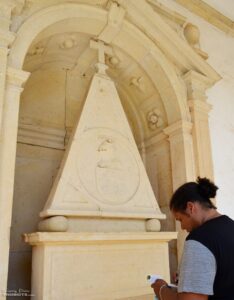
"The Washing Cloister or the Claustro da Lavagem is a two-storey gothic cloister built around 1433 under Henry the Navigator (1394–1460). The name is very practical since it’s where the monks would wash their clothes." Poles or scrolls?

Benben capstone or should that be Benbenet? 'Knee' to enlarge.
Side note: ''On Floating Bodies (Greek: Περὶ τῶν ἐπιπλεόντων σωμάτων) is a Greek-language work consisting of two books written by Archimedes of Syracuse (287 – c. 212 BC), one of the most important mathematicians, physicists, and engineers of antiquity. On Floating Bodies, which is thought to have been written around 250 BC, survives only partly in Greek, the rest in medieval Latin translation from the Greek. It is the first known work on hydrostatics, of which Archimedes is recognized as the founder.[1]
The purpose of On Floating Bodies was to determine the positions that various solids will assume when floating in a fluid, according to their form and the variation in their specific gravities. It contains the first statement of what is now known as Archimedes' principle.''
N.B. The purity of 'GOLD' derived from it.
REFRESHER: Senusret II was the fourth pharaoh of the Twelfth Dynasty of Egypt who ordered for the construction of the Pyramid of Lahun before his death. The ancient ruler took a great deal of interest in the Faiyum oasis region and began work on an extensive irrigation system from Bahr Yussef through to Lake Moeris in Middle Egypt.
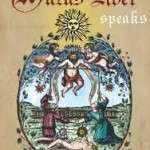
 And/or: ''The Ramesseum Dramatic Papyrus describes and comments on a ritual performed for 12th Dynasty king, Sesostris I {Senusret}. Derives from a 1st Dynasty ritual or something like it....May have taken place in the Old Kingdom, at the time the Pyramid Texts were committed to writing....A royal ritual of fortysix scenes, with thirtyone vignettes {''seventyseven'' and/or ''three and four''?} - culminating in the coronation of Horus and the raising {''upright''?} of Osiris....It could be linked to the Sed Festival {on the eve of it} - to the renewal of kingship...The texts identify with the qeni {worn over the chest and back and knotted at the shoulders}, normally seen during the Opening of the Mouth ceremony...It signifies the union or ''embrace'' of the Horus-king and Osiris. The king says: I have embraced this my 'father' who has become tired, so that he may be healthy again....And/or: ''The Pyramid texts also state that Horus, who is held protectively by the embrace of Osiris, is made shining {akh} - like Ra - through his embrace....eventually to climb a great ladder that reaches up to the sky.'' ['Page 70 'Shamanic Wisdom in the Pyramid Texts' / J. Naydler].
And/or: ''The Ramesseum Dramatic Papyrus describes and comments on a ritual performed for 12th Dynasty king, Sesostris I {Senusret}. Derives from a 1st Dynasty ritual or something like it....May have taken place in the Old Kingdom, at the time the Pyramid Texts were committed to writing....A royal ritual of fortysix scenes, with thirtyone vignettes {''seventyseven'' and/or ''three and four''?} - culminating in the coronation of Horus and the raising {''upright''?} of Osiris....It could be linked to the Sed Festival {on the eve of it} - to the renewal of kingship...The texts identify with the qeni {worn over the chest and back and knotted at the shoulders}, normally seen during the Opening of the Mouth ceremony...It signifies the union or ''embrace'' of the Horus-king and Osiris. The king says: I have embraced this my 'father' who has become tired, so that he may be healthy again....And/or: ''The Pyramid texts also state that Horus, who is held protectively by the embrace of Osiris, is made shining {akh} - like Ra - through his embrace....eventually to climb a great ladder that reaches up to the sky.'' ['Page 70 'Shamanic Wisdom in the Pyramid Texts' / J. Naydler].
''Father'' = higher aspect.
"Saturn is the first step on the Ladder of the Planets {'seven' stages}. It is farthest from the sun of all the visible planets - 888 million miles - and represents the galactic starting point on our journey IN from the stars."
Side note: ''Omm Sety died at Abydos aged seventyseven.''
She believes she knows where Nefertiti is buried: ''Close by to the tomb of Tutankhamun - but they will never be able to GUESS where.''
Could that {esoteric} mind set?

Oculus of the Pantheon = ''Bulls eye''.
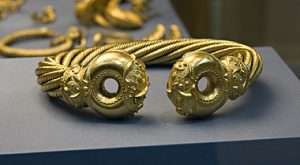 And/or: ''The accentuation of the center is a fundamental idea on alchemy....The center contains the ''indivisible point,'' which is simple, indestructible, and eternal. Its physical counterpart is gold, which is therefore a symbol of eternity. In Christianos the center is compared to paradise and its four rivers. These symbolize the philosophical fluids, which are emanations from the center. In the center of the earth the seven planets took root, and left their virtues there, wherefore in the earth is a germinating 'water'....The fire that originates in the center carries everything upward, but when it cools everything falls back again to the center....'' [Pages 148/9 'Alchemical Studies'].
And/or: ''The accentuation of the center is a fundamental idea on alchemy....The center contains the ''indivisible point,'' which is simple, indestructible, and eternal. Its physical counterpart is gold, which is therefore a symbol of eternity. In Christianos the center is compared to paradise and its four rivers. These symbolize the philosophical fluids, which are emanations from the center. In the center of the earth the seven planets took root, and left their virtues there, wherefore in the earth is a germinating 'water'....The fire that originates in the center carries everything upward, but when it cools everything falls back again to the center....'' [Pages 148/9 'Alchemical Studies'].
Living water?
Analogy: Mountain low, valley high. Enlarged elsewhere.
Smith and Jones for something deeper.

Decorative edge?

According to legend, Trophimus of Arles becomes the first bishop of Arles.
Continued: ''In the pink is an informal expression meaning the peak of health or an optimal state. It is often used to describe a situation in which an investor or an economy is in a good financial position....The expression in the pink to mean to be at the peak of health goes back to the 1500s when the word pink did not refer to a color. At that time, the word pink referred to a certain type of flower called dianthus, still referred to as pinks in the English vernacular, today.''
Side note: A tympanum (pl.: tympana; from Greek and Latin words meaning "drum") is the semi-circular or triangular decorative wall surface over an entrance, door or window, which is bounded by a lintel and an arch.[1] It often contains pedimental sculpture or other imagery or ornaments.[2] Many architectural styles include this element.[3]
Alternatively, the tympanum may hold an inscription, or in modern times, a clock face.
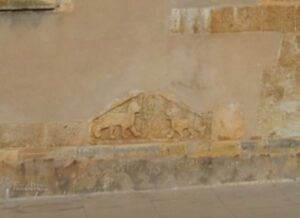
At the bottom right of the clock tower {Tomar - Portugal} sits a pyramidal stone relief of a dog and a lion which is very weathered by time older than the church itself. They are separated by a flor-de-lis.

Daniel and the lions {West portal}.
"The west portal {of the Church of St. Trophime} is one of the treasures of Romanesque sculpture, presenting the story of the Apocalypse according to St. John, and the Gospel of St. Matthew. Christ is seated in majesty in the tympanum, with the symbols of the Evangelists around him; according to the most common interpretation, they are the man of St. Matthew, the lion of St. Mark, the ox of St. Luke, and the eagle of St. John. The Apostles are seated below him. To the left of the portal, a procession of chosen Christians is going to heaven, while to the right sinners are being cast into hell.
The decoration of the portal also includes a multitude of Biblical scenes; the Annunciation; the Baptism of Christ; the Adoration of the Magi, the Magi before Herod; the Massacre of the Innocents; shepherds with their flocks.
On the lower level, separated by pilasters and columns of dark stone, are statues of saints connected with the history of Arles; on the left, St. Bartholomew, St. James the Great, St. Trophimus, St. John the Evangelist, and St. Peter; and on the right, St. Philip, St. James the Just, St. Stephen, St. Andrew, and St. Paul.
The bases of the columns beside the portal are decorated with statues of lions, Samson and Delilah, and Samson and the Lion.[6]"
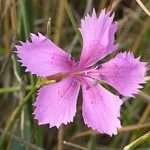
'Five'?
Continued: ''The name Dianthus is from the Greek words δῖος dios ("of Zeus") and ἄνθος anthos ("flower"), and was cited by the Greek botanist Theophrastus.[2] The color pink may be named after the flower, coming from the frilled edge of the flowers: the verb "to pink" dates from the 14th century and means "to decorate with a perforated or punched pattern". As is also demonstrated by the name of "pinking shears", special scissors for cloth that create a zigzag or decorative edge that discourages fraying. Alternatively, "pink" may be derived from the Dutch "pinksteren" alluding to the season of flowering . "Pinksteren" means "Pentecost " in Dutch. Thus the colour may be named from the flower rather than the flower from the colour.''
'Shears'.
Pentecost, which means “fiftieth” in Greek, has its roots in the ancient Jewish feast of Shavuot. It commemorates the descent of the Holy Spirit upon the Apostles fifty days after the Resurrection, marking the birth of the Church (Acts 2:1–4).
'Fifty'.
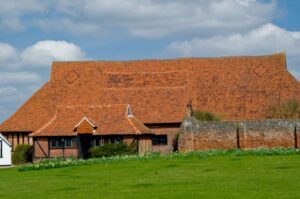
One of the two ancient barns at Cressing Temple. Lozenge shape on roof?
 Side note: Pentecost was the celebration of the beginning of the early weeks of harvest. In Palestine, there were two harvests each year. The early harvest came during the months of May and June; the final harvest came in the Fall. Pentecost was the celebration of the beginning of the early wheat harvest, which meant that Pentecost always fell sometime during the middle of the month of May or sometimes in early June.
Side note: Pentecost was the celebration of the beginning of the early weeks of harvest. In Palestine, there were two harvests each year. The early harvest came during the months of May and June; the final harvest came in the Fall. Pentecost was the celebration of the beginning of the early wheat harvest, which meant that Pentecost always fell sometime during the middle of the month of May or sometimes in early June.
There were several festivals, celebrations, or observances that took place before Pentecost. There was Passover, there was Unleavened Bread, and there was the Feast of Firstfruits. The Feast of Firstfruits was the celebration of the beginning of the barley harvest. Here's the way you figured out the date of Pentecost.
According to the Old Testament, you would go to the day of the celebration of Firstfruits, and beginning with that day, you would count off 50 days. The fiftieth day would be the Day of Pentecost. So Firstfruits is the beginning of the barley harvest and Pentecost is the celebration of the beginning of the wheat harvest.

''Bridge'' / 'lake' and snow topped mountains. As a means....?

First Witness?
And/or: Happy Easter! During these days, we pray that Easter may come like the "mighty wind" of Pentecost, renewing our faith, our hope, and our charity. In the liturgy, we contemplate the prominent role of Mary Magdalene as the first witness to Christ’s resurrection.
We are now rejoicing in the "Easter of Flowers," as it was once called in the old catechism, surely alluding to the beautiful springtime experienced here in the northern hemisphere.
On the First Saturday of Easter, April 26th this year, we celebrated the local feast of Saint Mary Magdalene here in Magdala. This is due to two reasons: July 22nd {'twentytwo'} falls during the peak of summer, when the heat in Magdala is intense; moreover, Saturday is a more fitting day for local community celebrations. That Saturday, during the first week of Easter, the liturgy commemorates Jesus' appearance to Mary Magdalene, making the celebration particularly appropriate.
Easter bunny = Hare or rabbit?
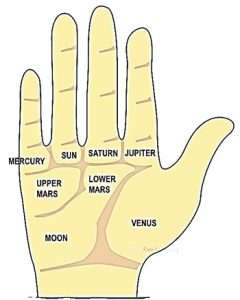
''The little finger is sometimes referred to as a pinky.''

In the pink of health?
And/or: "Two of the Marys, along with Sarah the Egyptian, remained in the seaside village where they landed. When they died, around 50 C.E., Saint Trophime himself came from Arles to administer the last rites. The three were buried near a small oratory, or chapel, they had built in the center of the village. In the ninth century, a new church was built over the oratory and the graves; fortified, it became part of the town walls. When King René d’Anjou, count of Provence, excavated the old church in the 1440s looking for the Holy Grail, he found the holy relics of the two Marys and Sarah and a curious stone buried with them. Called the Saint’s Pillar, it was incorporated into a support column when King René built a lofty and imposing church of pinkish stone to house the saints’ relics (fig. 6.6). With its parapets, merlons, embrasures, and internal freshwater spring, the church acted as a virtually impregnable fortress designed to protect the town’s inhabitants from Moorish pirates and other marauders.” ['The Mysteries of the Great Cross of Hendaye'].

The valley as seen from the adjacent Great Gable.
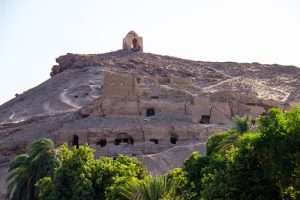
Qubbet el-Hawa or "Dome of the Wind" is a site on the western bank of the Nile, opposite Aswan, that serves as the resting place of ancient nobles and priests from the Old and Middle Kingdoms of ancient Egypt.
And/or: Pillar and Ennerdale Fells is a Site of Special Scientific Interest (SSSI) in Ennerdale, Cumbria, England. Protected for its biological interest, the site is named after Pillar, which at 892 metres (2,927 ft) is the eighth-highest mountain in the Lake District, and other fells in the same range. The area is 425.25 ha.[1]
Ennerdale is a valley in Cumbria, England. Ennerdale Water, fed by the River Liza, is the most westerly lake in the Lake District National Park.
Due to the remote location, the lack of a public road up the valley, and its management by Forestry England, the National Trust and United Utilities, Ennerdale is relatively unspoiled. Ennerdale Water has not been as affected as other lakes in the National Park by construction, activity on the lake or the trappings of tourism. In 2022 the partners managing Ennerdale, together with Natural England, put together a successful proposal to declare much of the Ennerdale Valley as a National Nature Reserve (NNR).[1

''Bridge'' and or "lake"on her left or right? As a means....? Icy topped mountains?

Coming from the west?
There are two biological Sites of Special Scientific Interest (SSSIs) in the valley:
- Ennerdale
- Pillar and Ennerdale Fells SSSI. Pillar and Ennerdale Fells is also protected as a Special Area of Conservation, being one of the ten SSSIs which underpin the High Fells SAC.[2]
- The Western Fells occupy a triangular sector of the Lake District, bordered by the River Cocker to the north east and Wasdale to the south east. Westwards the hills diminish toward the coastal plain of Cumberland. At the central hub of the high country are Great Gable and its satellites, while two principal ridges fan out on either flank of Ennerdale, the western fells in effect being a great horseshoe around this long wild valley.[2] Pillar is on the southern arm.

"The path to Black Sail Pass can be seen following Gather-stone Beck." AND/OR: "Black sail youth hostel at the foot of the Pillar - used to be a shepherds bothy." 'Sail' to enlarge.

"Cloud sweeping across Gable Crag {opposite the 'Pillar'} at the head of Ennerdale heralds a gradual change in the weather."
Side note: A bothy is a basic shelter, usually left unlocked and available for anyone to use free of charge. It was also a term for basic accommodation, usually for gardeners or other workers on an estate. Bothies are found in remote mountainous areas of Scotland, Northern England, Ulster and Wales. They are particularly common in the Scottish Highlands, but related buildings can be found around the world (for example, in the Nordic countries there are wilderness huts). A bothy was also a semi-legal drinking den on the Isle of Lewis. These, such as Bothan Eòrapaidh, were used until recent years as gathering points for local men and were often situated in an old hut or caravan.
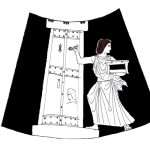
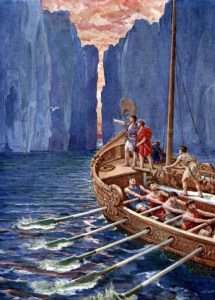
Side step: Heliopolis is the Latinised form of the Greek name Hēlioúpolis (Ἡλιούπολις), meaning "City of the Sun". Helios, the personified and deified form of the sun, was identified by the Greeks with the native Egyptian gods Ra and Atum, whose principal cult was located in the city.
Its native name was iwnw "The Pillars". The exact pronunciation is uncertain because ancient Egyptian recorded only consonantal values.[5]
Its traditional Egyptological transcription is Iunu but it appears as ʾOn (Biblical Hebrew: אֹן) in Genesis 41:45 and 50 and ʾĀwen (אָוֶן) in Ezekiel 30:17 and Amos 1:5 (apparently Baalbek). This later form would be the expected form in pausa, but perhaps is a play on awen "idolatry." Some scholars reconstruct its pronunciation in earlier Egyptian as *ʔa:wnu, perhaps from older /ja:wunaw/. Variant transcriptions include Awnu and Annu. The name survived as Coptic ⲱⲛ Ōn.[6]
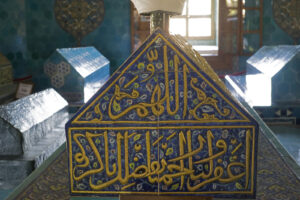
The Green Tomb (Turkish: Yeşil Türbe) is a mausoleum of the fifth Ottoman Sultan, Mehmed I, in Bursa, N/W Turkey. It was built by Mehmed's son and successor Murad II following the death of the sovereign in 1421. The architect Hacı Ivaz Pasha designed the tomb and the Yeşil Mosque opposite to it....In addition to the sultan's sarcophagus, it contains seven other tombs: those of his sons Mustafa, Mahmud and Yusuf, his daughters Selçuk, Ayşe and Sitti and his wet nurse (Daye Hatun). Set amid cypresses on top of the hill in the Yeşil neighborhood in Bursa, the mausoleum stands higher than the rest of the complex. It is built on a hexagonal plan and crowned with a hemi-spherical dome. The exterior of the mausoleum is clad with the green-blue tiles that give it its name.
The city is called "House of Ra" in the Pyramid Texts, which date to the Old Kingdom of Egypt.[7]
Side note: The Symplegades are sometimes identified with (or confused with) the Planctae (Πλαγκταί) or Wandering Rocks, which are mentioned in the Odyssey and Apollonius of Rhodes' Argonautica. In Apollonius's telling, the Symplegades were encountered on the way to the Golden Fleece and the Planctae were encountered on the return voyage....

Delos.
The Symplegades (/sɪmˈplɛɡədiːz/; Greek: Συμπληγάδες, Symplēgádes), also known as Clashing Rocks or Cyanean Rocks (Κυανέαι), were, according to Greek mythology, a pair of rocks at the Bosphorus that clashed together whenever a vessel went through. They were defeated by Jason and the Argonauts, who would have been lost and killed by the rocks except for Phineus's advice. Jason let a dove fly between the rocks to see exactly how fast they'd have to row to beat the rocks; the dove lost only its tail feathers. The Argonauts rowed mightily to get through and lost only part of the stern ornament. After that, the Symplegades stopped moving permanently.
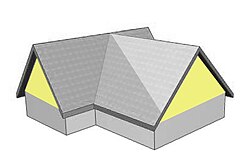
Gable end.
CONTINUED: A gable is the generally triangular portion of a wall between the edges of intersecting roof pitches. The shape of the gable and how it is detailed depends on the structural system used, which reflects climate, material availability, and aesthetic concerns.
The term gable wall or gable end more commonly refers to the entire wall, including the gable and the wall below it.
Some types of roof do not have a gable (for example hip roofs do not). One common type of roof with gables, the 'gable roof', is named after its prominent gables.
A parapet made of a series of curves (shaped gable,[1] see also Dutch gable) or horizontal steps (crow-stepped gable) may hide the diagonal lines of the roof.
Gable ends of more recent buildings are often treated in the same way as the Classic pediment form. But unlike Classical structures, which operate through trabeation, the gable ends of many buildings are actually bearing-wall structures.
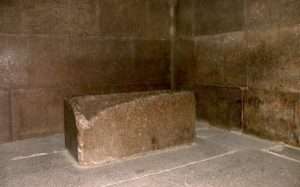
Beginning or end?

Unas: 'Three and four'?
Gable style is also used in the design of fabric structures, with varying degree sloped roofs, dependent on how much snowfall is expected.
Sharp gable roofs are a characteristic of the Gothic and classical Greek styles of architecture.[2]
The opposite or inverted form of a gable roof is a V-roof or butterfly roof.
Side note: "Butterflies taste with their feet."
The Oxford English Dictionary derives the word straightforwardly from Old English butorflēoge, butter-fly; similar names in Old Dutch and Old High German show that the name is ancient, but modern Dutch and German use different words (vlinder and Schmetterling) and the common name often varies substantially between otherwise closely related languages. A possible source of the name is the bright yellow male of the brimstone (Gonepteryx rhamni); another is that butterflies were on the wing in meadows during the spring and summer butter season while the grass was growing.[6][7]
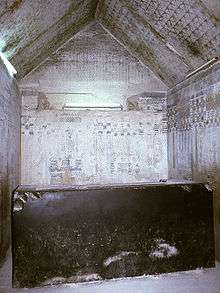
From a different perspective: The Lutheran church {having as its facade the same form as above} is now a boxing gym. "This has just done my head in because everything always comes full circle but never in such a poetic way as this. I feel so joyful, I couldn't have been more delighted by this whole thing." Sue Perkins' episode of Who Do You Think You Are / BBC2.
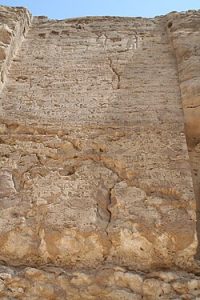
'Pillar'?
Continued: The Boundary Stelae of Akhenaten are a group of royal monuments in Upper Egypt. They are carved into the cliffs surrounding the area of Akhetaten, or the Horizon of Aten, which demarcates the limits of the site. The Pharaoh Akhenaten commissioned the construction of Akhetaten in year five of his reign during the New Kingdom. It served as a sacred space for the god Aten in an uninhabited location roughly halfway between Memphis and Thebes at today's Tell El-Amarna. The boundary stelae include the foundation decree of Akhetaten along with later additions to the text, which delineate the boundaries and describe the purpose of the site and its founding by the Pharaoh. Total of sixteen stelae have been discovered around the area.[1] According to Barry Kemp, the Pharaoh Akhenaten did not “conceive of Akhetaten as a city, but as a tract of sacred land”.[2]

Something 'new'?
Continued: His predecessor Senusret I was the first pharaoh to realign the orientation of HIS temple at Heliopolis: ''His temple stood behind the obelisk - the procssional avenue into Heliopolis does not follow the usual E/W orientation but is significantly slanted.... towards the north. With computer software it is found that: ''The day on which the sun rose over the temple is Monday 26th February 1936 BC - which is the day after the 2nd aniversary of his fathers death {hypothesis}. First step in his building program. ''In the south of the city the sacrosanct area for the gods. In the north - home to the mortals - that contains the kings palace {'prince' link} and houses of the priests and their families.'' [Heliopolis: The City of the Sun'].
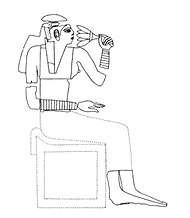
Wife / Mother / Grandmother of the Old Kingdom pharaohs. AND/OR: Pentecost (also called Whit Sunday, Whitsunday or Whitsun) is a Christian holiday which takes place on the 49th day (50th day when inclusive counting is used) after Easter Day.[1] It commemorates the descent of the Holy Spirit upon the Apostles of Jesus while they were in Jerusalem celebrating the Feast of Weeks, as described in the Acts of the Apostles (Acts 2:1–31).[2] The Catholic Church believes the Holy Spirit descended upon Mary, the mother of Jesus, at the same time, as recorded in the Acts of the Apostles (Acts 1:14).[3]
What about the 'moon'?
''Twentytwo''?
"FIRST WITNESS"?
''A series of steps in a river designed to enable fish to bypass a dam and move upstream is called a salmon ladder.'' ['The Chase'].
Graylings?
The REAL QUESTIONS, however, remain the same.
 And/or: "These organs were called the Sons of Horus because their functions, when man became aware of them, contribute to the realization of Horus in man, that is, of man's complete and immortal consciousness. They are therefore represented at the judgement of the deceased as elevated on a lotus, that is to say, sublimated, having lost all their perishable elements and become pure consciousness. Each belongs to one of the four regions of the body...The canopic vases did not contain either the 'polar' {N/E} organs {brain and 'sex'} or the kidneys {S/W} ..." [Same book]. Try ''lotus''.
And/or: "These organs were called the Sons of Horus because their functions, when man became aware of them, contribute to the realization of Horus in man, that is, of man's complete and immortal consciousness. They are therefore represented at the judgement of the deceased as elevated on a lotus, that is to say, sublimated, having lost all their perishable elements and become pure consciousness. Each belongs to one of the four regions of the body...The canopic vases did not contain either the 'polar' {N/E} organs {brain and 'sex'} or the kidneys {S/W} ..." [Same book]. Try ''lotus''.
N.B. Before those first impressions fizzle the innards of the mind - ''Sex'' in relation to the concept of 'fire'. Enlarged throughout.
Define {'see'} the above to get an idea {''hang on''?} - the following: The Cerrigydrudion Crown. A Celtic piece of ancient artwork. Bronze {'red'?} and leather {'cow'?} headpiece. ''Possibly signifies 'warrior' headgear - with palm leaf and lotus designs - neither of which are common to these islands {UK}.'' ['Inside Museums: St. Fagan/Cardiff. Sat.TV].
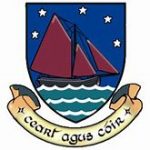
Purple sail? 'Triangular' in shape?
Side note: Pampootie shoes/'slipper'/sandal? - worn in the Aran Islands, County Galway, Ireland. Made of untanned cowhide or sealskin. Aran = ''kidney shape''.
''County Galway (/ˈɡɔːlweɪ/ GAWL-way; Irish: Contae na Gaillimhe) is a county in Ireland. It is in the West of Ireland, taking up the south of the province of Connacht..... Clonfert (Irish: Cluain Fearta) is a small village in east County Galway, Ireland, halfway between Ballinasloe and Portumna. The village gives its name to the Diocese of Clonfert. Clonfert Cathedral is one of the EIGHT cathedral churches of the Church of Ireland, Diocese of Limerick and Killaloe.''

Brendan and the Whale.
And/or: ''Brendan of Clonfert (c. AD 484 - c.577), is one of the early Irish monastic saints and one of the Twelve Apostles of Ireland. He is also referred to as Brendan the Navigator, Brendan the Voyager, Brendan the Anchorite, Brendan the Bold. The Irish translation of his name is Naomh Bréanainn or Naomh Breandán. He is mainly known for his legendary voyage to find the “Isle of the Blessed” which is sometimes referred to as “Saint Brendan’s Island”. The written narrative of his journey comes from the immram The Navigatio Sancti Brendani Abbatis (Voyage of Saint Brendan the Abbot).''
Saint Brendan's feast day is celebrated on 16 {'sixteen'} May by Catholics, Anglicans, and Orthodox Christians.
''The legend of travelling monk, St Brendan was well known in the High Middle Ages: He set off, with followers, from Ireland in 512 for the Land of Promise. On the journey, the monks met demons, were chased by sea serpents and a griffin – and landed on the back of a whale, mistaking it for an island.''
''The Jasconius is a creature with origins in Roman mythology, legend and folklore. In particular, accounts of its existence first arose in Pliny the Elder's Natural History. However, the specific name Jasconius is not given for the creature until a much later account from Medieval Europe (specifically in an account called The Legend of Saint Brendan).
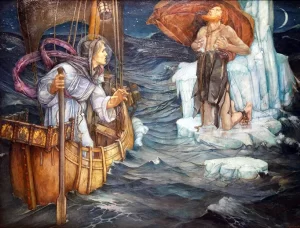
The 'living' island.
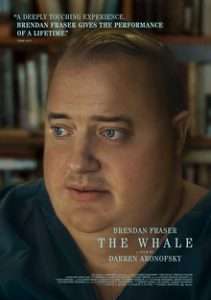 Or, at least, most believe that the Jasconius is first mentioned in Ancient Greek texts. However, there are some that believe the creature is first mentioned in the Bible. Specifically, they believe that the Jasconius is the gigantic fish that swallows Jonah up, for three [3] days and three [3] nights, in Jonah 2:2 {'twentytwo'?}. Though, in all actuality, there is no evidence that the two fish are the same, other than the fact that they can both grow to enormous size.
Or, at least, most believe that the Jasconius is first mentioned in Ancient Greek texts. However, there are some that believe the creature is first mentioned in the Bible. Specifically, they believe that the Jasconius is the gigantic fish that swallows Jonah up, for three [3] days and three [3] nights, in Jonah 2:2 {'twentytwo'?}. Though, in all actuality, there is no evidence that the two fish are the same, other than the fact that they can both grow to enormous size.
Likewise, no source actually even gives a translation for the name 'Jasconius', or any of the name's variations. The closest one comes to any name with a distinct meaning is when Pliny the Elder refers to the creature as "pristis", meaning "of immense size". And yet, this seems more like a description than a species name.''
And/or: ''According to the tradition of the Physiologus and medieval bestiaries, the aspidochelone is a fabled sea creature, variously described as a large whale or vast sea turtle, and a giant sea monster with huge spines on the ridge of its back. No matter what form it is, it is always described as being so huge that it is often mistaken for an island and appears to be rocky with crevices and valleys with trees and greenery and having sand dunes all over it. The name aspidochelone appears to be a compound word combining Greek aspis (which means either "asp" or "shield"), and chelone, the turtle. It rises to the surface from the depths of the sea, and entices unwitting sailors with its island appearance to make landfall on its huge shell and then the whale is able to pull them under the ocean, ship and all the people, drowning them. It also emits a sweet smell that lures fish into its trap where it then devours them. In the moralistic allegory of the Physiologus and bestiary tradition, the aspidochelone represents Satan, who deceives those whom he seeks to devour.''
Greek equivalent: Poseidon {'horses + island' links}. Zeus {'cave / fed by she goat link}. Apollo + sister {born on island with foundations i.e., 'anchored' link}.
Atlantis / Anchorite to enlarge.
'The Story of Turtle Woman' by Nettie Eldredge. {Page 263 'Invoking the Scribes of Ancient Egypt'}.

Any cracks?

''Possible turtle people emerging from a horizontal crack."
And/or: ''From the root of 'ankh' we get the German angst, which means 'anxiety' the neurosis that Freud explicitly links with the 'birth process', for he points out: The name Angst {angustiae, Eage} = a narrow place, a strait - accentuates the characteristic tightening in the breathing...The ankh is also then the chance 'opening', or opportunity, that is narrow {Gebel el -Silsila?} - as the 'crack between the worlds'. The Egyptians placed an ankh in the left ear of the dead person - a link to karmic judgement - that which i take in, as opposed to that which i do not want to hear. Also the ear lobe is shaped like an ankh loop....The ankh is sometimes seen as a sandal with a toe strap. For not only does the pun {sacred ones?} apply that the sandal cares for the comfort of the sole i.e., soul {where no foot may tread?}.... The Egyptian word ankh is from the Old Egyptian hnk, meaning 'narrow' / 'embrace' / 'strangle' - a reminder of birth into life - suggesting something that binds. A contemporary symbol would be a wedding ring. Eliade points out that ankh may be derived from Sumerian An, meaning 'Sky' and 'Ki' meaning 'Earth' - born out of the Great Mother, Chaos....Originally 'close together' {no space between}...First offspring forces 'them apart' {light i.e., luminosity and/or numinosity} - only in this 'created space' {''being''?} can naming of the various parts of the world be carried out {'fifteen'?}.'' [Pages 220/294 'Fruits of the Moon Tree' / A. Bleakley].
The Egyptian word ankh is from the Old Egyptian hnk, meaning 'narrow' / 'embrace' / 'strangle' - a reminder of birth into life - suggesting something that binds. A contemporary symbol would be a wedding ring. Eliade points out that ankh may be derived from Sumerian An, meaning 'Sky' and 'Ki' meaning 'Earth' - born out of the Great Mother, Chaos....Originally 'close together' {no space between}...First offspring forces 'them apart' {light i.e., luminosity and/or numinosity} - only in this 'created space' {''being''?} can naming of the various parts of the world be carried out {'fifteen'?}.'' [Pages 220/294 'Fruits of the Moon Tree' / A. Bleakley].
Ishon.
''A persons ability to BALANCE is aided by the ears.'' ['The Chase'].
Spirit/Soul as a means....?
Gebel el Silsila to enlarge.
The phrase “hot on the heels” means in close pursuit of someone or something, or immediately after some event1. It originates from hunting terminology, where the “on the heels” part refers to a hunter’s literal closeness behind their quarry. The word “hot” alludes to the warmth of an active living creature, as opposed to the cold of a corpse or the unconsciousness of being “out cold” 1. When hounds are close to their prey, they are said to be “in hot pursuit.”
Side note: "Horeb" is thought to mean glowing/heat, which seems to be a reference to the Sun, while Sinai may have derived from the name of Sin, the Ancient Mesopotamian religion deity of the Moon,[2][9] and thus Sinai and Horeb would be the mountains of the Moon and Sun, respectively.''

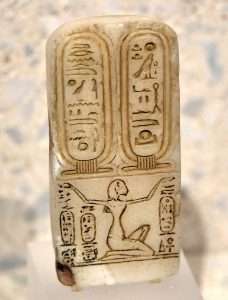 '' Now Moses was tending the flock of Jethro his father-in-law, the priest of Midian, and he led the flock to the far side of the wilderness and came to Horeb, the mountain of God. 2 There the angel of the Lord appeared to him in flames of fire from within a bush. Moses saw that though the bush was on fire it did not burn up. 3 So Moses thought, “I will go over and see this strange sight—why the bush does not burn up.”
'' Now Moses was tending the flock of Jethro his father-in-law, the priest of Midian, and he led the flock to the far side of the wilderness and came to Horeb, the mountain of God. 2 There the angel of the Lord appeared to him in flames of fire from within a bush. Moses saw that though the bush was on fire it did not burn up. 3 So Moses thought, “I will go over and see this strange sight—why the bush does not burn up.”
4 When the Lord saw that he had gone over to look, God called to him from within the bush, “Moses! Moses!”
And Moses said, “Here I am.”
5 “Do not come any closer,” God said. “Take off your sandals, for the place where you are standing is holy ground.”
6 Then he said, “I am the God of your father,[a] the God of Abraham, the God of Isaac and the God of Jacob.” At this, Moses hid his face, because he was afraid to look at God.
7 The Lord said, “I have indeed seen the misery of my people in Egypt. I have heard them crying out because of their slave drivers, and I am concerned about their suffering. 8 So I have come down to rescue them from the hand of the Egyptians and to bring them up out of that land into a good and spacious land, a land flowing with milk and honey.''

More horizontal? What would it look like in the 'vertical'? Djed column?
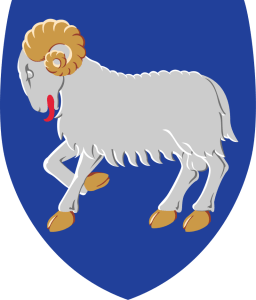
Golden tongued?
A working example: ''In Faroese, the name appears as Føroyar. Oyar represents the plural of oy, older Faroese for 'island'. Due to sound changes, the modern Faroese word for island is oyggj. The first element, før, may reflect an Old Norse word fær ('sheep'), although this analysis is sometimes disputed because Faroese now uses the word seyður (from Old Norse sauðr) to mean 'sheep'. Another possibility is that the Irish monks {i.e., St. Brendan}, who settled the island around 625, had already given the islands a name related to the Gaelic word fearann, meaning 'land' or 'estate'. This name could then have been passed on to the Norwegian settlers, who then added oyar (islands).[12] The name thus translates as either 'Islands of Sheep' or 'Land Islands'....According to a ninth-century voyage tale, the Irish saint Brendan visited islands resembling the Faroes in the sixth century. This association, however, is not conclusive...
In English, it may be seen as a tautology to say the Faroe Islands, since the oe comes from an element meaning 'island'. This is seen in the BBC Shipping Forecast, where the waters around the islands are called Faeroes. The name is also rarely spelled Faeroe.''
N.B. 'Eighteen' in total.
Sheep decans to enlarge.
'Manger'?
From a different perspective: ''At the age of sixty Khudiram made a pilgrimage to Gaya {N/E India}. Here, from ancient times, Hindus have come from the four corners of India to discharge their duties to their departed ancestors by offering them food and drink at the sacred footprint of the Lord Vishnu. At this holy place Khudiram had a dream in which the Lord Vishnu promised to be born as his son. His wife {Chandra Devi} also had a vision in front of the Siva temple at Kamarpukur indicating the birth of a 'divine' child. It was on February 18 {'eighteen'}, 1836, that the child - later to known as Ramakrishna, was born. In memory of the dream at Gaya he was given the name Gadadhar, the 'Bearer of the Mace', an epithet of Vishnu. Three years later a little sister was born.'' [Intro: The Gospel of Sri Ramakrishna].
Conception/Conceive to enlarge.
Continued: A working example: Recall Odysseus journey back to his homeland. Lotus island being its 'first stage'.

Ear shape?
'Spirit/Soul' - as a means....?
Question. What would ''hang on'' be represented with - if anything?
A side step: The Step Pyramid - oldest {'elder'?} in Egypt. The very first one. The first stone one. The beginning of something. A vast labyrinth beneath.
''Labyrinth'' in relation to 'underworld' therefore represented as a ''river''?
''The labyrinth is a reflection of the labyrinthine canals of the inner ear that regulate the balance on the ground, for to slay the minotaur, or engage with the vitality of life, is to do so in a balanced way, in a way that harmonises the vertical of the quest, the journey for 'vision', and the horizontal of the ground....'' [Page 198 'Fruits of the Moon Tree'].
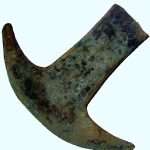
Hoe money. Aztec.
Recall same under the Step Pyramid. What was found within? And/or...at its deepest level a clay pot/vase found. What does the ''vase'' represent? and/or fired/UNfired?
Isiah 19:19 for a ''deeper'' read if only in relation to a 'direction'.
Many 'fired vases' found under Teotihuacan Pyramid. Ancient lake bed found - the base of which in the shape of the Aztec ''hoe money''. ['Blowing Up History: Seven Wonders ofv the Pyramid'].

Off center?
Side note: "Alfred Watkins believed that the tradition of underground passages connects with leys. He explained that there is evidence to support the theory that where one finds underground passage legends, these hidden lines follow leys, the notion being that such subterranean passages are a folk memory of leys." ['Quicksilver Heritage: The Mystic Leys - Their Legacy of Ancient Wisdom' / P. Screeton].
Question. When was the first plant symbolism introduced? When was it first seen {represented?} within those stone monuments? Try ''bosom'' for a 'deeper' read {understanding?}.
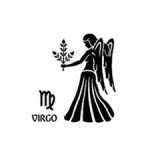 Vernal Equinox.
Vernal Equinox.
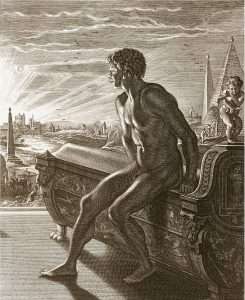
Memnon.
"A few months later, Easter 1937, i conducted on the lawn of the new ashram the first of many Easter sunrise services. Like the Magi of old, several hundred students gazed in awe of the daily miracle: the awakening solar rite in the eastern sky. To the west lay the Pacific Ocean, booming its solemn praise; in the distance a tiny white sailing boat and the lonely flight of a seagull. 'Christ, thou art risen'. Not with the vernal sun alone, but in spirit's eternal dawn." [Extract from the book 'Autobiography of a Yogi'].
"The Virgin - is the principle of springtime,i.e., that of creative spiritual elan and spiritual flourishing. The prodigious flourishing of philosophy and the arts in ancient Athens took place under the sign of the Virgin. Similarly, the flourishing of the Renaissance at Florence was under the vernal sign of the Virgin. Also, Weimar at the beginning of the 19th century was a place where the 'breath' of the Virgin perceptibly moved hearts and minds." [Extract taken from within the book by Tomberg].
Venus?

Humiliated? Which one? Mother Russia ? Question. If she was - would she slaughter innocents - just to prove a point? Man or mouse?
Analogy {closer to the 'heart'?}: "A certain aspect of the Old Mystery wisdom which continued on into early Christian times was known as Gnosis. The Christian Gnostic scriptures which have come down to us in the 'Pistis Sophia' tell of the descent or fall of the original ''Virgin'' wisdom into darkness, and its salvation by 'Christ'. It is called Sophia, the virgin of light. There are passages which refer to the power of the 'virgin of light' to redeem mankind from ..."['The Flaming Door'. Includes ''double inverted'' emphasis].
'Daughters of Saturn' by Patricia Reis.
Side note: "It is therefore impossible for a scholar to possess knowledge of these problems, whether it be through his own researches or through his 'masters' teaching - without communicating part of that knowledge to others. This cannot be done in clear words; it must be done sparingly by way of hints. We find in the words of some of our Sages numerous hints and notes of this kind, but mixed up with words of others and with other subjects. In treating of these mysteries, as a rule, I quote as much as contains the principle idea, and leave the rest for those who are worthy of it." [Page 211 'Guide for the Perplexed' / Moses Maimonides].
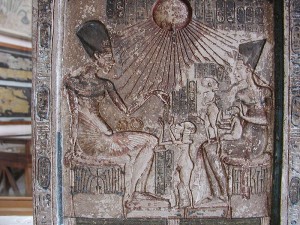
All 'Daughters'? As a means...? Try the title of the book to 'see' {gnosis?} something from a {top/down?} point of view i.e.,astronomy/astrology.
Continued: As seen from a different perspective : ''Wisdom, through 'suffering and experience', incarnation through the messy and painful process of 'birth', and embodiment in matter {from the Latin 'mater' for mother}, are all feminine elements one can see in Saturn. Reis speaks to the principle of wisdom in her groundbreaking work Daughters of Saturn: 'The product of a feminine ''immersion in life'' is experiential knowledge. We call this feminine consciousness wisdom. It has been personified in Christian theology as Sophia and in Jewish mysticism as the Shekhina, God's feminine aspect. In Greek mythology, Athena as the goddess of wisdom. These feminine aspects of the Saturn archetype highlight how the Greek god Cronos..." ['Saturn and the Theoretical Foundations of an Emerging Discipline']. Try ''line of sight'' and/or ''line of/in'' and/or ''afar'' and/or ''at a distance'' - ALL AS A MEANS...?
''Foundations'' in relation to Homer's Secret Illiad.

''M''?
Continued: For a truer possible interpretation for 'its' original chose {i.e.,the structure of the letter 'M'} - try the chapter entitled 'The Science and Art of Animating Statues' within the book 'Alexandria' vol 2 by D. Fideler. [The pictures have to be seen to understand their true significance]. Until then...
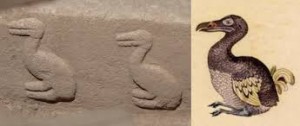
Question. Stylized 'm' - in the 'vertical' position? If so, what does the 'bird' represent and for whom?
"The bas relief we have examined, dating back some 3,300 years, is clearly structured on the accepted canon of 19 squares. However, the 19-square grid is not a true canon of proportion, but a canonical rule of thumb that was used in Egyptian art. True proportion involves the use of ratio, and one of the most dynamic ratios is the Golden Section, reflected in the process of unfolding life. Students of geometry draw a distinction between the principles of static and dynamic symmetry. The square grid is useful but static; the phi grid is dynamic and brings the piece to life." [Same chapter]. Put both ''ratio'' and especially ''bosom'' in the usual box. Then try ''nineteen''.
"...To meditate is to deepen; it is to go to the heart of things." [Extract from the book by Tomberg. 'Letter 21' ].
A study program does the same. Yes or no?


The hand of Sabazios. Thumb = pinecone? And/or: Thumb and forefinger = ''onehundred'' i.e., 'circle'
Analogy of same..."That duality is now expressed on a lower plane in the static and the dynamic elements of our construction. That is in a circle and a cross. The cross represents a 'static' matrix of energies, the circle a 'dynamic' expression of energies within that matrix. Both circle and cross are expressions of the initiating, creative spirit that is represented by the point at the common center of both cross and circle...That central point is also expressed as an 'altar'...In masonic symbolism this duality is expressed by the square and compass. The square marks out the cross; the compass, the circle. This finds another expression in the heavens and the earth. The heavens are associated with circular movement {12+5? and/or N/S? }, for that is what the stars describe to all who watch them from the earth. The earth is associated with the straight line {10+7? and/or E/W? } - the measuring out of land - and the straight line that is given by a plumb bob or pendulum, or a falling object, that by the force of gravity makes a direct path toward the center of the earth." [Extract from the book 'The Rose Cross and The Goddess: The Quest for the Eternal Feminine Principle'].
Compass of the Heart?
''The inner guardian is our true North, the keeper of the charts.'' Try 'map' / 'whale'.
And/or: ''There are perhaps a hundred pendulums moving here and there in man. These ascents and descents, these wave like flunctuations of moods {ebb and flow?}, thoughts, feelings, energy, determination, are periods of the development of forces between 'intervals' in the octaves as well as the intervals themselves...'' [Location 2688 {Kindle}: 'In Search of the Miraculous'].
All as a means.......?

Static or dynamic?

Above or below the clouds?
A working example and/or synchronistic: ''Then think of your own metamorphosis', he suggested. 'What will you be when you become a butterfly. What is the butterfly of Jeanne?' What a great question for a 14 year old girl, a question for puberty rites, initiations into adulthood, and other new ways of being. 'I don't really know anymore Mr Tayer,'.... 'Yes you do know. It is inside of you, like the butterfly is inside the caterpillar.' He then used a word that i heard for the first time, a word that became essential to my later work. 'What is the entelechy of Jeanne? A great word, A Greek word, entelechy. It means the dynamic purpose that is coded in you. It is the entelechy of the acorn to be an oak tree or the entelechy of the caterpillar to undergo metamorphosis and become a butterfly. So what is the butterfly, the entelechy of Jeanne? You know, you really do'..... I looked up at the CLOUDS, and it seemed that i could see in them the shapes of many countries. A fractal of my future emerged in the cumulus nimbus floating overhead. 'I think that i will travel all over the world and help people find their entelechy.'' [Page 142/3 'A Mythic Life' / J. Houston].
'Cloud of Unknowing'?
Side note: ''He found that god is two in one, like man. Besides this he noticed something that our text also emphasizes, namely ''suspension of breathing.'' He says ordinary breathing stopped and was replaced by an internal respiration, ''as if breathing of a distinct personality within and other than the physical organism.'' He took this to being the ''entelechy'' of Aristotle and the ''inner Christ'' of the apostle Paul, the ''spiritual and substantial individuality engendered within the physical and phenomenal personality, and representing, therefore, the rebirth of man on a plane transcending the material.'' [Page 27 'Alchemical Studies'].
Karnac to enlarge.
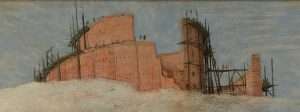
Tower reaching above....{The Peak Above the Clouds}.
 Continued: ''Cumulonimbus (from Latin cumulus, "heaped" and nimbus, "rainstorm") is a dense, towering vertical cloud,[1] typically forming from water vapor condensing in the lower troposphere that builds upward carried by powerful buoyant air currents. Above the lower portions of the cumulonimbus the water vapor becomes ice crystals, such as snow and graupel,'' [Wiki].
Continued: ''Cumulonimbus (from Latin cumulus, "heaped" and nimbus, "rainstorm") is a dense, towering vertical cloud,[1] typically forming from water vapor condensing in the lower troposphere that builds upward carried by powerful buoyant air currents. Above the lower portions of the cumulonimbus the water vapor becomes ice crystals, such as snow and graupel,'' [Wiki].
''The only cloud type to produce hail, thunder and lightening is Cumulonimbus.'' ['The Chase' / 2018].
(from Latin cumulus 'swell' and nimbus 'cloud')
''Cirrus clouds - being the lightest of all - could be described as 'wispy'....sometimes called the horses tail...'' Same.
Try Q.S. Lam for another example.
N.B. Recall the tail of the Bear as it was thrown up into the sky by {Zeus?}.
'Stretched' to enlarge.

The most ancient of all 'sea dragons' found in Rutland. Ruthland?
From a different perspective: ''In the text i notice that the dissolution of the 'dragon' by Sol is also seen to bring about the division of 'mercury' and 'sulphur' - the volatile and the fixed. This represents the beginning of the seperation between the inner mental life {psyche} and the outer physical life {body}.[Page 140/1 'Mercurius' / P. Harpur].
That ''duality'' that can be represented as {examples of}: King/Queen {Sol/Luna} and/or Thorns/Roses, i.e.,'petals' {flowers?} and/or Dark/Light and/or Bitter/Sweet and/or Spotted/ Unspotted and/or Redeemed/Unredeemed and/or Lucky/Unlucky and/or Ebb/Flow and/or Waxing/Waning and/or Separate/Union and/or Shield/Cup and/or Circle/Square and/or Line/Arc and/or East/West and/or North/South and/or Womb/Tomb and/or Death/Rebirth etc.
ALL AS A MEANS....?

Stags or Doe's? {'Winterwatch' / Feb. 2019}.
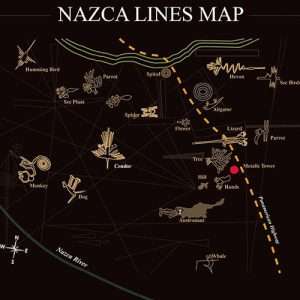 "The concept of the Pillars is of great importance. Everything that exists to objective perception is a manifestation of forces in 'duality.' These dual forces in complement or vortex ['spiral' link], are represented by two pillars." [Chapter one, 'The Rose Cross and the Goddess' by G. Knight]. Recall what ''objective'' implies. Recall 'its' importance in any subject. [Representational of]. Continued elsewhere.
"The concept of the Pillars is of great importance. Everything that exists to objective perception is a manifestation of forces in 'duality.' These dual forces in complement or vortex ['spiral' link], are represented by two pillars." [Chapter one, 'The Rose Cross and the Goddess' by G. Knight]. Recall what ''objective'' implies. Recall 'its' importance in any subject. [Representational of]. Continued elsewhere.
'On Having No Head: Zen and the Rediscovery of the Obvious' / D. E. Harding.
The REAL question however is - as always - regardless of what one may or may not come to understand - is WHY. Why go to all this effort?
Why a Virgin birth? To distinguish it from the norm. A normal birth cannot be described as ‘virginal’ but a concept can... ....Life equals source; equals birth; equals woman; equals woman's name; equals ‘Virgin’. [ ‘Key’ word.] Folklore equivalent = Maiden...Equals that first experience; with the reader in mind only; of the understanding of a concept. In relation to a possible understanding of the source / origin of ‘something’. Symbolic of...the ‘source of life.’ [ in their opinion...by way of implication ] ’The breath of life’. [ Old testament ] Or ’ Kore Kosmou’.[ Hermetic equivalent ].

Flag of Brazil. 'Twentysix' stars above the equator. The solitary one = Spica - below. 'Twentyseven' in total. 'nineteen{th}' of November 1889 = Independence Day.
"The term 'virgin birth' does not appear anywhere in the biblical texts, but Isaiah 7:14 and Mathew 1:23 both make the same statement: 'The virgin will be with child and will give birth to a son'..." [From the book by K. Gest].
Put those three keys together, i.e.,virgin; 'child' and 'son' - to define something other than the obvious...
Nefertiti?
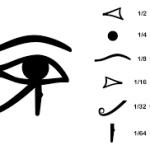
Third eye?
Side note: "You have three guesses: why does the proverb say ''Good things come in threes'', and why does the psychologist think that 3 restores the damaged 2 has caused by dividing? The reason , as Ludwig Paneth has stated, is that the triad leads to a new integration, one that does not negate the duality preceding it but rather, overcomes it, just as the child is a binding element that unites the male and female partner." [from the chapter: The Embracing Synthesis {3} / 'Mystery of Numbers' / Annemarie Schimmel].
Duality?
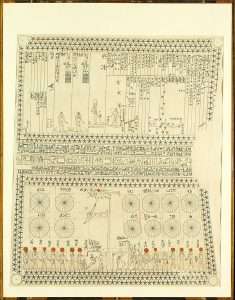
Astro ceiling in Senenmut bare tomb chamber. 'Folded'?
And/or: "Scholar Arthur Waley has discovered magic thread reference in I-Ching, oracle 29: 'Bind with a thread of three strands and two strands, put it in a bramble thicket {'Hawthorn'?} - and you will get your wish after three years'.
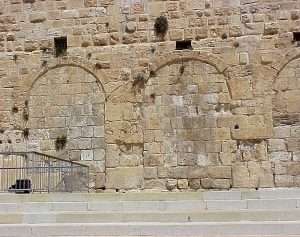
Eastern_gate_of_huldah_
This twentyseven line oracle is usually called 'The Pit' or The Abysmal'. But its Chinese name usually means the double or folded pit {'cube'?}. Waley believes it is connected with lunar ritual, being 'one hole opening out of another... [Page 79 'The White Goddess' ].
A working example: "Like the Gnostics of old before him, so Jung also was accused of being gloomy and pessimistic in his outlook. Perhaps the best illustration of his attitude is found in the dream of a woman patient, mentioned earlier, who saw herself submerged in a pit filled with a dangerous substance and who then perceived Jung pushing her right down into the pit with the words, ‘‘Not out but through!’”’ It has been reported that whenever Jung discussed this particular dream in public or before friends, he showed visible enjoyment, delighting in the fact that such a clear recognition of his essential attitude should have emerged from the dream of his patient. To Jung, life has always two movements: one upward, the other downward." [Page 197 'The Gnostic Jung' / S. Hoeller].

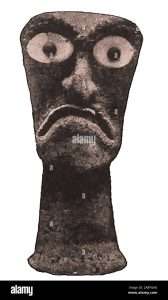
Gloomy?
'On Having No Head: Zen and the Rediscovery of the Obvious' / D. E. Harding.
'Turquoise'?
"...The lower three 'spheres' are related to worldly consciousness and the upper four are related to spiritual consciousness and 'enlightenment'. Therefore, the lower must be sublimated into the higher ones." [Extract from the book by S. Ashby].
REFRESHER; "Clement of Alexandria elucidates the idea that Jesus is the 'son of god' by explaining: 'The Son is the consciousness of the Father.' The 'Father' is the Mystery...the dazzling darkness of UNconscious Consciousness." Anything?
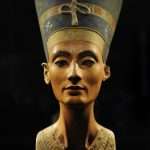
A 'virgin' Queen?
Analogy {closer to the 'heart'?}: "A certain aspect of the Old Mystery wisdom which continued on into early Christian times was known as Gnosis. The Christian Gnostic scriptures which have come down to us in the 'Pistis Sophia' tell of the descent or fall of the original ''Virgin'' wisdom into darkness, and its salvation by Christ. It is called Sophia, the virgin of light. There are passages which refer to the power of the 'virgin of light' to redeem mankind...The 'Virgin' has always stood for the archetype of the soul, clothed in the light of wisdom..." ['The Flaming Door'].
Question. If ''Virgin'' = soul. What represents 'spirit'. And why?
"She is an archetype, unborn and deathless, a Virgin, bringing her Child - the human soul - from the Sun." Same book.
Dazzling Aten?

Headband_with_Heads_of_Gazelles_and_a_Stag_Between_Stars_or_Flowers. 'Eight' petalled? "Diadem" to enlarge.
"In the Christian mythos the Blessed Virgin, Mary, becomes the vehicle for both these aspects [in relation to the principles that 'Binah' represents within the Hebrew tree of life]. In the bright vernal scene of the Annunciation, when the Archangel Gabriel comes to her, bearing lilies......she is the archetypal embodiment of the Bright 'Fertile Mother'. In a sense this is a transformation and fulfillment of the great pagan virgin goddess such as Diana or Atalanta." [Part 6, 'The Rose Cross and the Goddess'. Emphasis, this readers]. Recall what ''lilies'' represent.

Use the minds eye to 'see' something!
''To see is to behold''? i.e., in the SPIRTUAL SENSE of the word!
A 'working' example {i.e.,something hinted at}: "He arrived at the Atelier. The sculpture received him cordially and asked him to come in...Jean Thomas looked around at the new decor. On the stiff curtains hanging from column to column were engravings of religious paintings - primitive paintings and those of the Renaissance, of Giotto, della Francesca, and Fra Angelico. There were Madonnas and angels. Before the Holy See, there was a beautifully illustrated Mass book on a pulpit. At the feet of the black Virgin was a spray of lilies, which contrasted with the ebony of the statue." ['Journey into the Light'].

